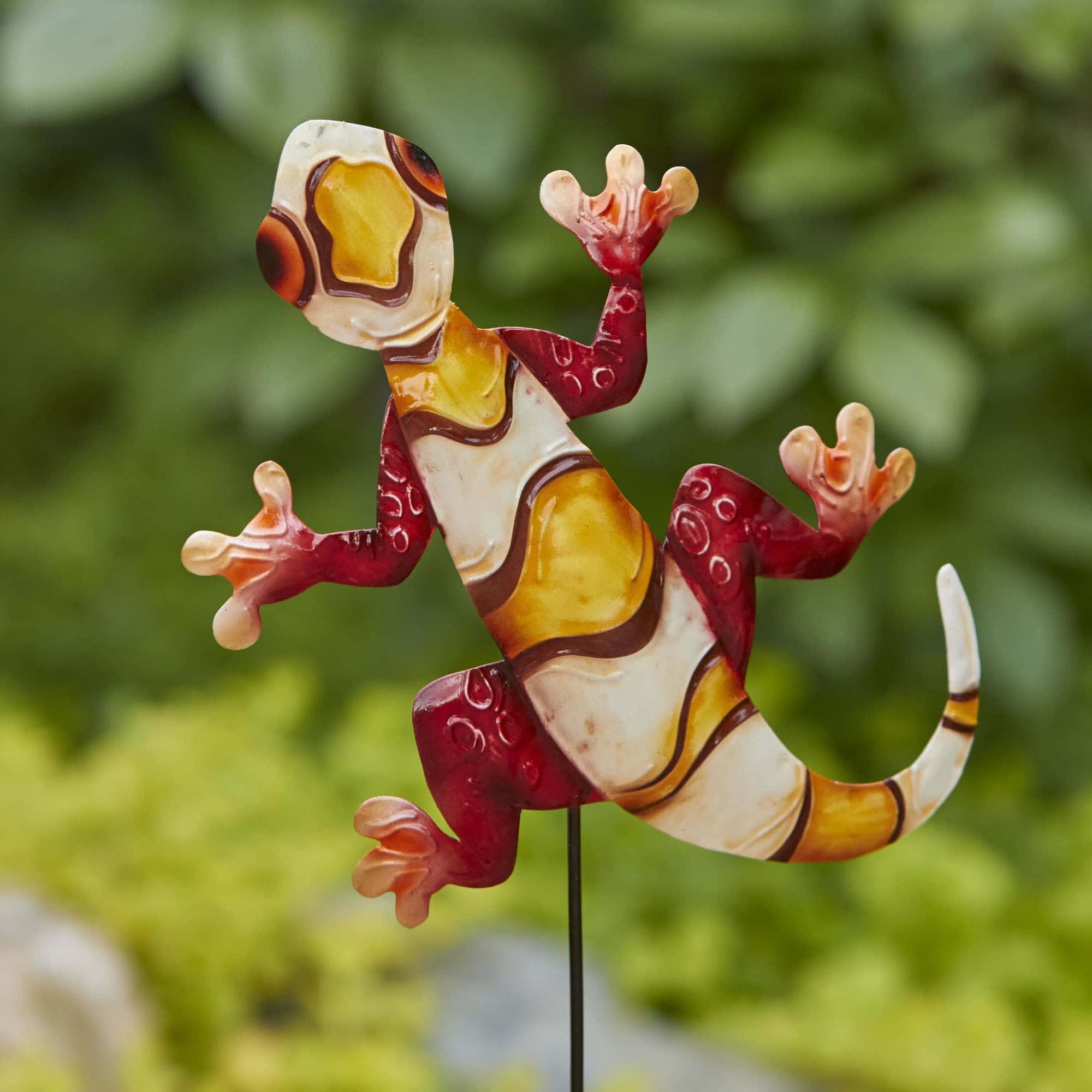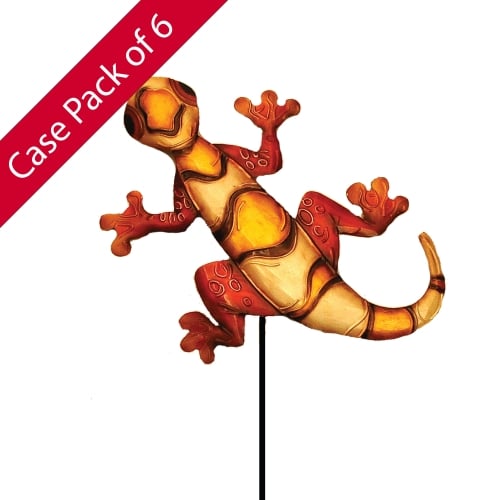-
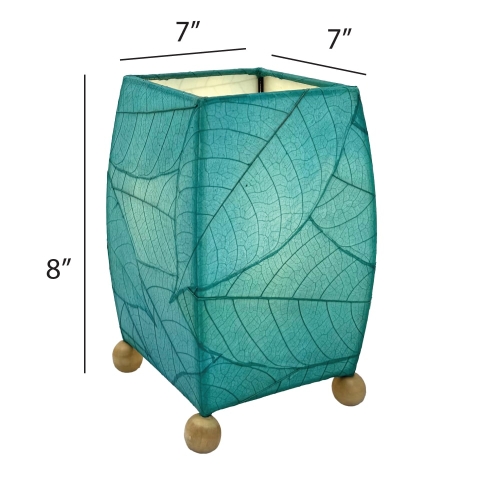
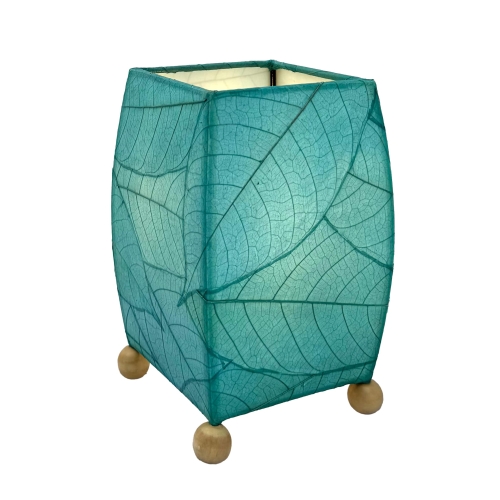 Bring home the essence of nature today with the Mini Square Cocoa Leaf Lamp: where style intertwines with sustainability in a compact form. Standing at eight inches high, this lamp may be compact, but its impact is far from small. The subtle curved sides and its overall squared shape adds a contemporary flair to any space, making it a versatile addition to your home decor. What further sets this lamp apart is the fusion of hand-shaped metal work, with a sturdy lamp backing, and wrapped fossilized cocoa leaves. This innovative combination not only creates a stunning visual effect but also reflects our commitment to eco-conscious design. Features fossilized Cocoa leaves that are hand placed on a standard UL lamp backing and then laminated using a non-toxic adhesive, creating each of the four sides of the lamp. The panels are adheard onto a powder coated, wrought iron frame to form a rectangular design. The entire lamp is set on wooden finials.
Bring home the essence of nature today with the Mini Square Cocoa Leaf Lamp: where style intertwines with sustainability in a compact form. Standing at eight inches high, this lamp may be compact, but its impact is far from small. The subtle curved sides and its overall squared shape adds a contemporary flair to any space, making it a versatile addition to your home decor. What further sets this lamp apart is the fusion of hand-shaped metal work, with a sturdy lamp backing, and wrapped fossilized cocoa leaves. This innovative combination not only creates a stunning visual effect but also reflects our commitment to eco-conscious design. Features fossilized Cocoa leaves that are hand placed on a standard UL lamp backing and then laminated using a non-toxic adhesive, creating each of the four sides of the lamp. The panels are adheard onto a powder coated, wrought iron frame to form a rectangular design. The entire lamp is set on wooden finials. -
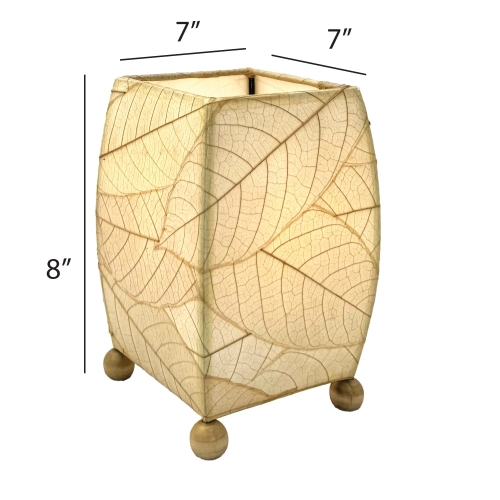
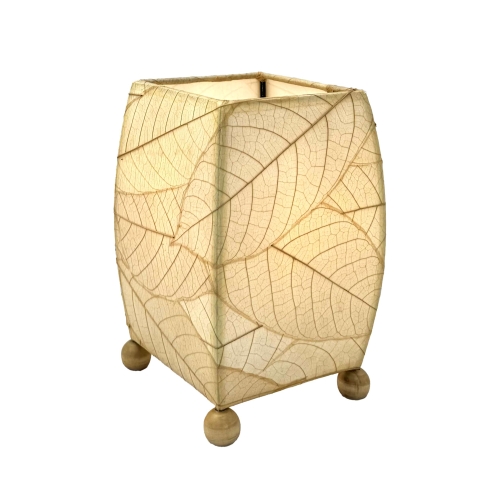 Bring home the essence of nature today with the Mini Square Cocoa Leaf Lamp: where style intertwines with sustainability in a compact form. Standing at eight inches high, this lamp may be compact, but its impact is far from small. The subtle curved sides and its overall squared shape adds a contemporary flair to any space, making it a versatile addition to your home decor. What further sets this lamp apart is the fusion of hand-shaped metal work, with a sturdy lamp backing, and wrapped fossilized cocoa leaves. This innovative combination not only creates a stunning visual effect but also reflects our commitment to eco-conscious design. Features fossilized Cocoa leaves that are hand placed on a standard UL lamp backing and then laminated using a non-toxic adhesive, creating each of the four sides of the lamp. The panels are adheard onto a powder coated, wrought iron frame to form a rectangular design. The entire lamp is set on wooden finials.
Bring home the essence of nature today with the Mini Square Cocoa Leaf Lamp: where style intertwines with sustainability in a compact form. Standing at eight inches high, this lamp may be compact, but its impact is far from small. The subtle curved sides and its overall squared shape adds a contemporary flair to any space, making it a versatile addition to your home decor. What further sets this lamp apart is the fusion of hand-shaped metal work, with a sturdy lamp backing, and wrapped fossilized cocoa leaves. This innovative combination not only creates a stunning visual effect but also reflects our commitment to eco-conscious design. Features fossilized Cocoa leaves that are hand placed on a standard UL lamp backing and then laminated using a non-toxic adhesive, creating each of the four sides of the lamp. The panels are adheard onto a powder coated, wrought iron frame to form a rectangular design. The entire lamp is set on wooden finials. -
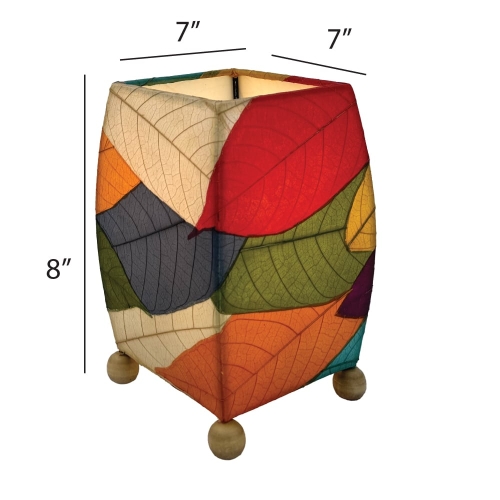
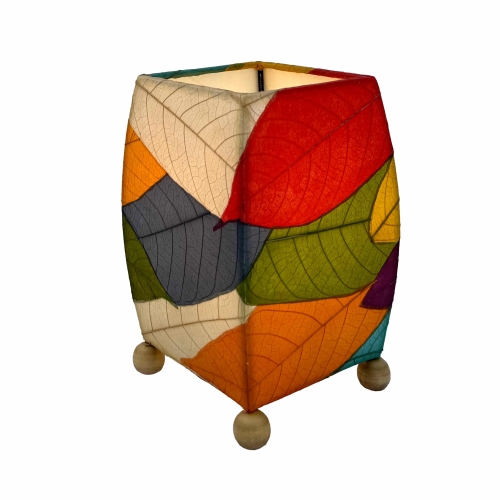 Bring home the essence of nature today with the Mini Square Cocoa Leaf Lamp: where style intertwines with sustainability in a compact form. Standing at eight inches high, this lamp may be compact, but its impact is far from small. The subtle curved sides and its overall squared shape adds a contemporary flair to any space, making it a versatile addition to your home decor. What further sets this lamp apart is the fusion of hand-shaped metal work, with a sturdy lamp backing, and wrapped fossilized cocoa leaves. This innovative combination not only creates a stunning visual effect but also reflects our commitment to eco-conscious design. Features fossilized Cocoa leaves that are hand placed on a standard UL lamp backing and then laminated using a non-toxic adhesive, creating each of the four sides of the lamp. The panels are adheard onto a powder coated, wrought iron frame to form a rectangular design. The entire lamp is set on wooden finials.
Bring home the essence of nature today with the Mini Square Cocoa Leaf Lamp: where style intertwines with sustainability in a compact form. Standing at eight inches high, this lamp may be compact, but its impact is far from small. The subtle curved sides and its overall squared shape adds a contemporary flair to any space, making it a versatile addition to your home decor. What further sets this lamp apart is the fusion of hand-shaped metal work, with a sturdy lamp backing, and wrapped fossilized cocoa leaves. This innovative combination not only creates a stunning visual effect but also reflects our commitment to eco-conscious design. Features fossilized Cocoa leaves that are hand placed on a standard UL lamp backing and then laminated using a non-toxic adhesive, creating each of the four sides of the lamp. The panels are adheard onto a powder coated, wrought iron frame to form a rectangular design. The entire lamp is set on wooden finials. -
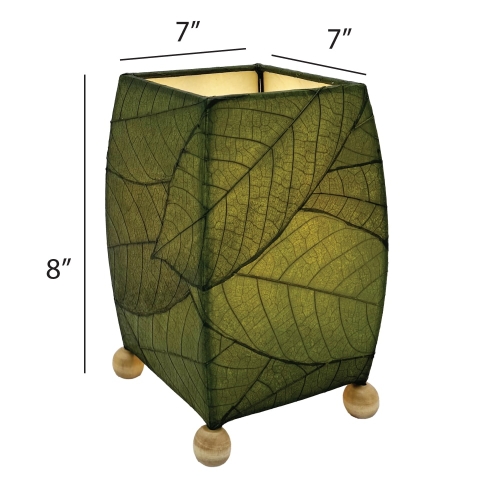
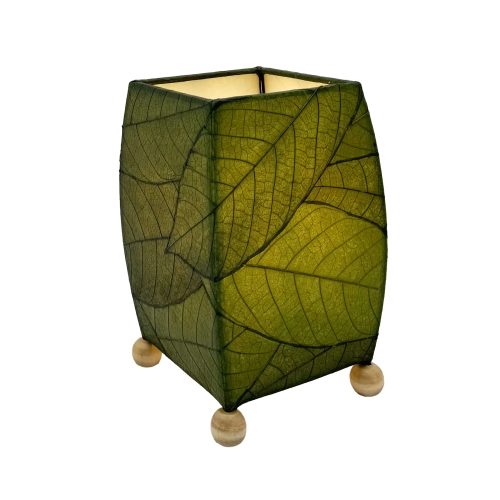 Bring home the essence of nature today with the Mini Square Cocoa Leaf Lamp: where style intertwines with sustainability in a compact form. Standing at eight inches high, this lamp may be compact, but its impact is far from small. The subtle curved sides and its overall squared shape adds a contemporary flair to any space, making it a versatile addition to your home decor. What further sets this lamp apart is the fusion of hand-shaped metal work, with a sturdy lamp backing, and wrapped fossilized cocoa leaves. This innovative combination not only creates a stunning visual effect but also reflects our commitment to eco-conscious design. Features fossilized Cocoa leaves that are hand placed on a standard UL lamp backing and then laminated using a non-toxic adhesive, creating each of the four sides of the lamp. The panels are adheard onto a powder coated, wrought iron frame to form a rectangular design. The entire lamp is set on wooden finials.
Bring home the essence of nature today with the Mini Square Cocoa Leaf Lamp: where style intertwines with sustainability in a compact form. Standing at eight inches high, this lamp may be compact, but its impact is far from small. The subtle curved sides and its overall squared shape adds a contemporary flair to any space, making it a versatile addition to your home decor. What further sets this lamp apart is the fusion of hand-shaped metal work, with a sturdy lamp backing, and wrapped fossilized cocoa leaves. This innovative combination not only creates a stunning visual effect but also reflects our commitment to eco-conscious design. Features fossilized Cocoa leaves that are hand placed on a standard UL lamp backing and then laminated using a non-toxic adhesive, creating each of the four sides of the lamp. The panels are adheard onto a powder coated, wrought iron frame to form a rectangular design. The entire lamp is set on wooden finials. -
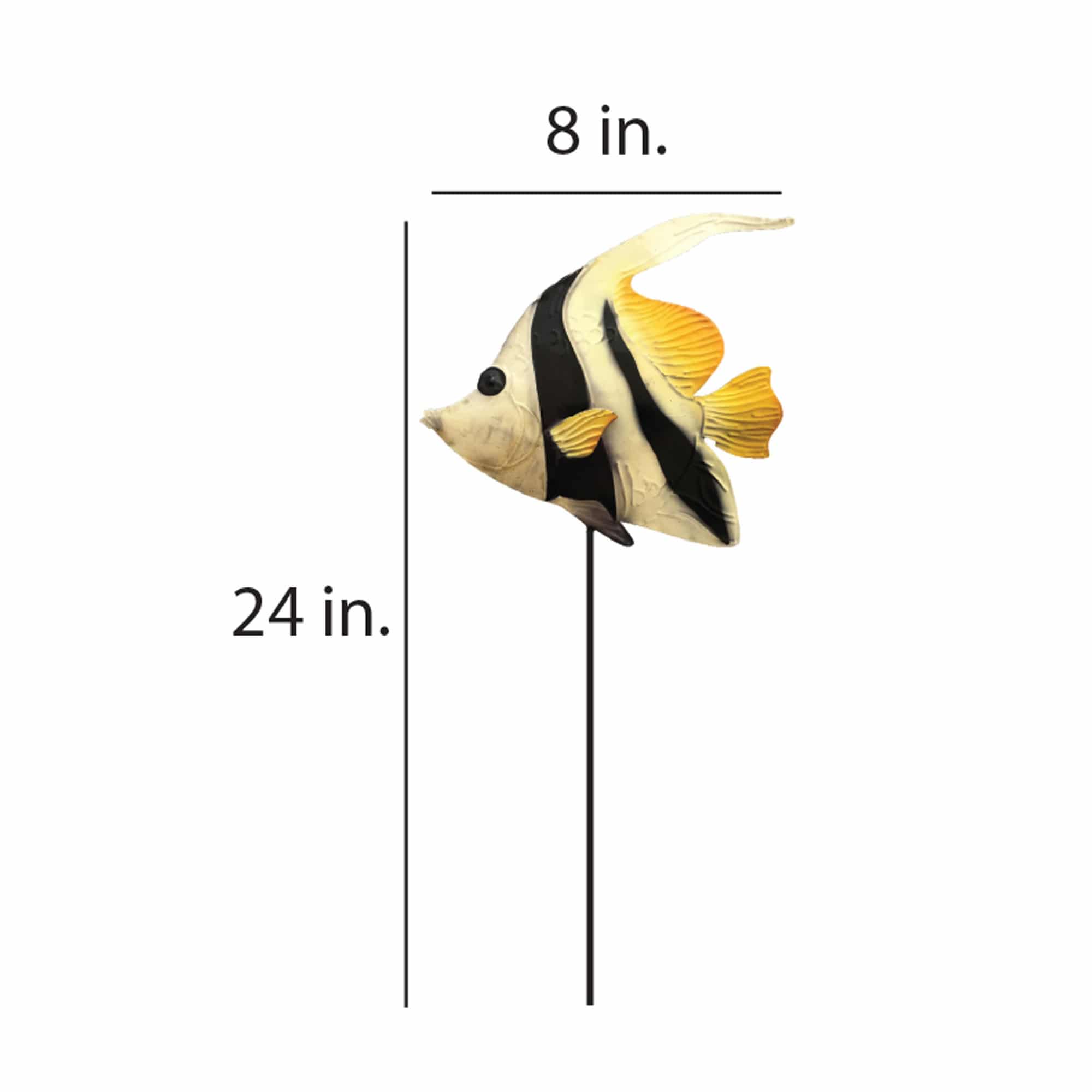
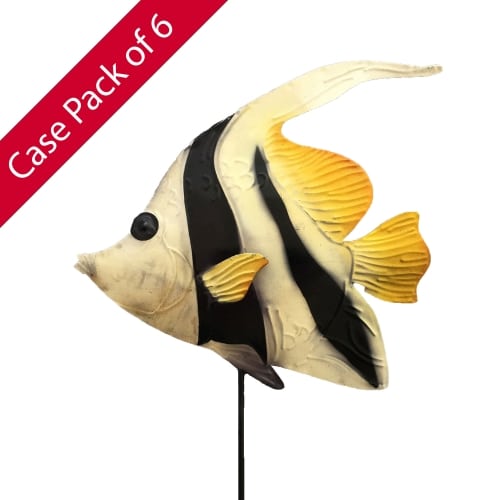 Case of 6 With its contrast of black and yellow and long iconic dorsal fin, the Moorish Idol Angle is well recognized by aquatic hobbyist and novices alike. This moderately peaceful fish is found throughout the southern hemisphere. The artist took great care on showing the big details common to the fish, but on closer examination one will see some color variations and shading in the paint itself. Handcrafted from metal then hand-painted and sealed.
Case of 6 With its contrast of black and yellow and long iconic dorsal fin, the Moorish Idol Angle is well recognized by aquatic hobbyist and novices alike. This moderately peaceful fish is found throughout the southern hemisphere. The artist took great care on showing the big details common to the fish, but on closer examination one will see some color variations and shading in the paint itself. Handcrafted from metal then hand-painted and sealed. -
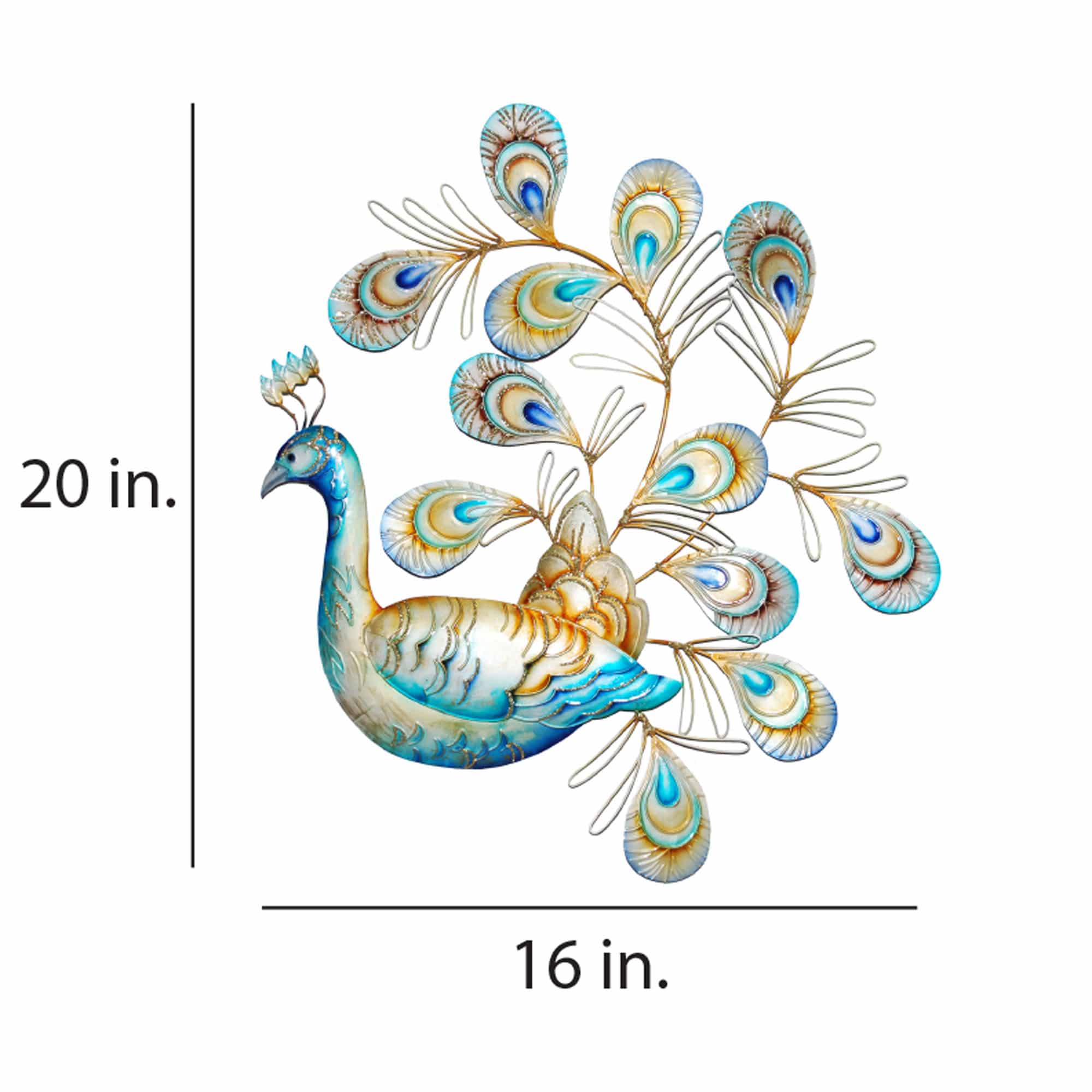
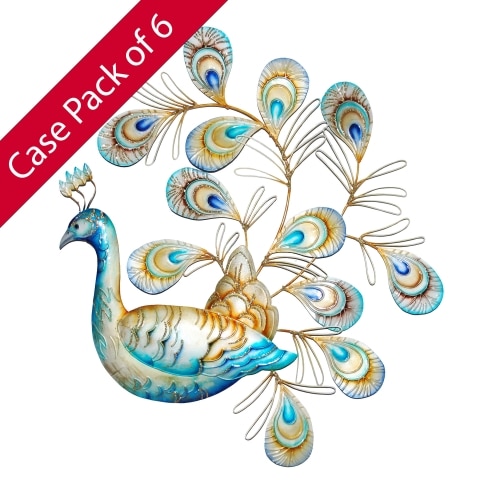 Case of 4 Tailfeathers raised, this Indian peacock is strutting his stuff. On display is its iridescent blue and green, metallic-colored, plumage. Throughout its tailfeathers, the artists drew in the peacock's distinctive eyespots, with the eye itself in different colors. The chest of the bird is crafted from capiz shell, carefully painted in the blues and greens this bird is known for. It fits perfectly within any decor style and will add the finishing touch to its surroundings. The basic frame of this piece is created using tin, which is powder coated with a black finish. The frame is reinforced using tin wire along the inner edge. The front of the body is adorned with capiz. Capiz is an oyster shell and the primary purpose of the oyster is as a source of food. However, the by-product, the shell, can be used for decoration. Due to it being a natural material, the natural colors of the capiz may come through as tans and browns underneath the hand-painted surface.
Case of 4 Tailfeathers raised, this Indian peacock is strutting his stuff. On display is its iridescent blue and green, metallic-colored, plumage. Throughout its tailfeathers, the artists drew in the peacock's distinctive eyespots, with the eye itself in different colors. The chest of the bird is crafted from capiz shell, carefully painted in the blues and greens this bird is known for. It fits perfectly within any decor style and will add the finishing touch to its surroundings. The basic frame of this piece is created using tin, which is powder coated with a black finish. The frame is reinforced using tin wire along the inner edge. The front of the body is adorned with capiz. Capiz is an oyster shell and the primary purpose of the oyster is as a source of food. However, the by-product, the shell, can be used for decoration. Due to it being a natural material, the natural colors of the capiz may come through as tans and browns underneath the hand-painted surface. -

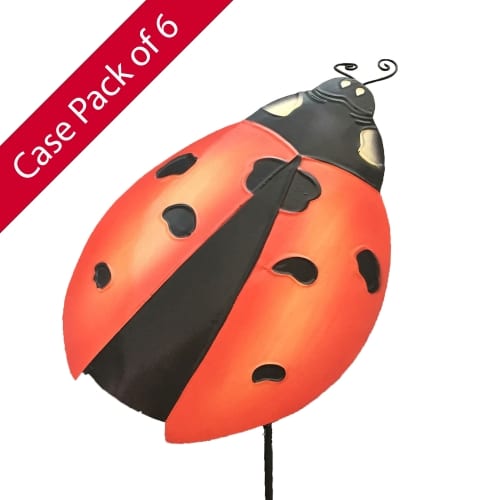 Case of 6 Some cultures believe seeing a ladybug brings good luck. Add good luck every day to your garden with a lady bug garden stake. With its bright red body, this lady bug adds a bright pop of color and fun to its surroundings. Whether placed with a potted plant or in a garden bed, this piece will add the finishing touch to any environment. Handcrafted from metal then hand-painted and sealed.
Case of 6 Some cultures believe seeing a ladybug brings good luck. Add good luck every day to your garden with a lady bug garden stake. With its bright red body, this lady bug adds a bright pop of color and fun to its surroundings. Whether placed with a potted plant or in a garden bed, this piece will add the finishing touch to any environment. Handcrafted from metal then hand-painted and sealed. -
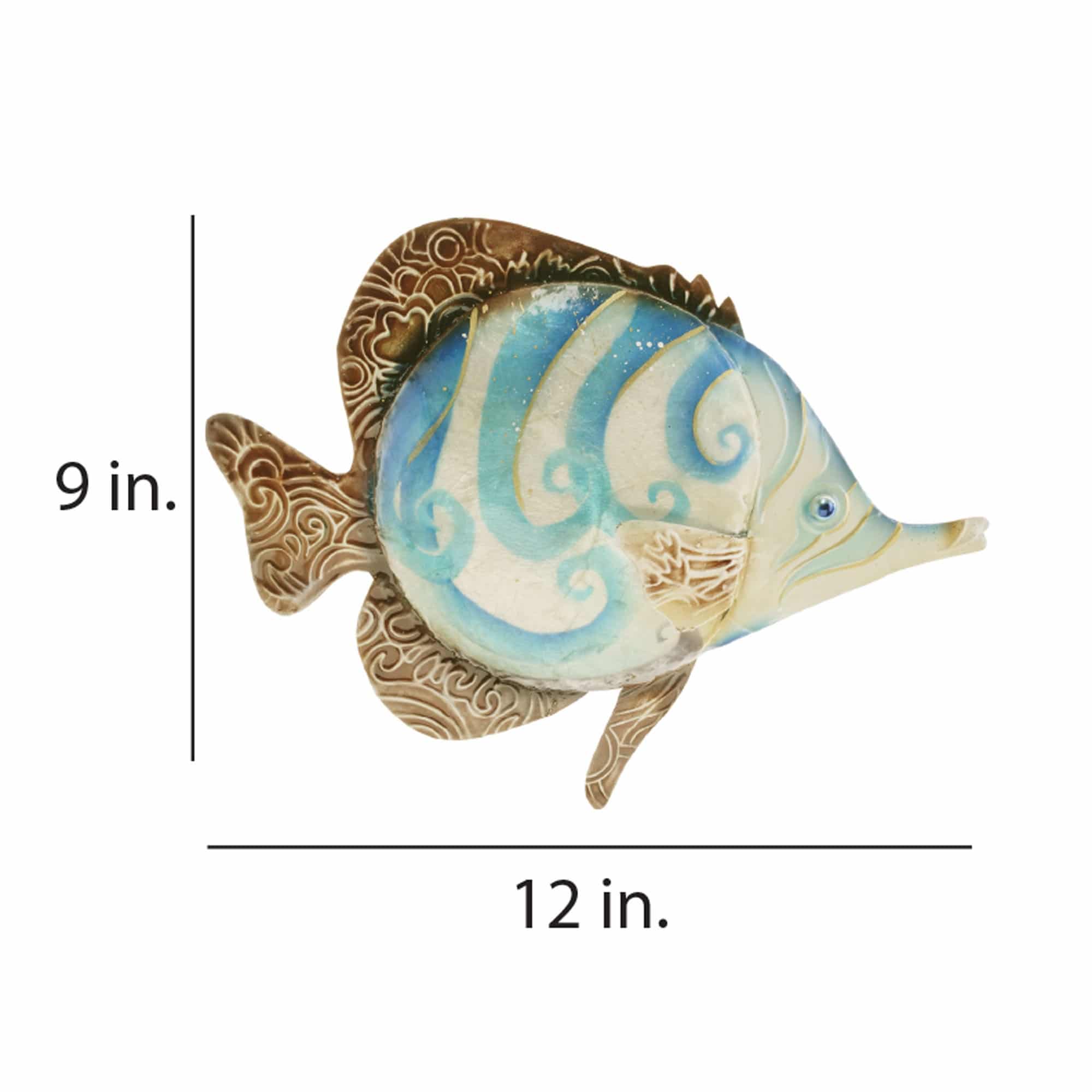
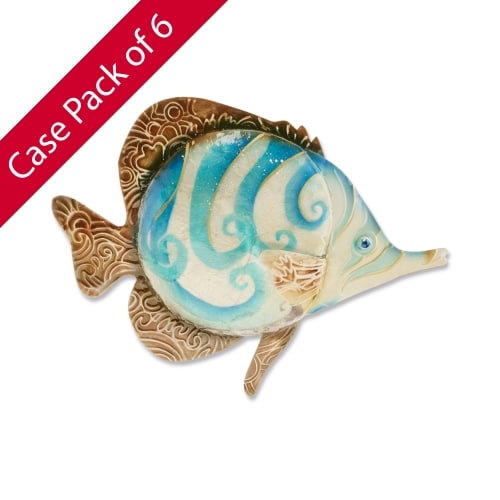 Case of 6 This fish was inspired by the Copperband Butterfly Fish. Though the name is a mouthful, the artist did capture the strips, colors, broad fins, and the beak that this fish is known for. The blue and pearl swirls contrast with its deeper bronze fins. Those fins are further enhanced with a swirled design, creating a very complex piece. The results is a piece rich in design and color. The basic frame of the wall fish is created using tin, which is powder coated as a black finish. The frame is reinforced using wrought iron wire along the inner edge. Capiz is an oyster shell and the primary purpose of the oyster is as a source of food. However, the by-product, the shell, can be used for decoration. Due to it being a natural material, the natural colors of the capiz can come through as tans and browns underneath the paint.
Case of 6 This fish was inspired by the Copperband Butterfly Fish. Though the name is a mouthful, the artist did capture the strips, colors, broad fins, and the beak that this fish is known for. The blue and pearl swirls contrast with its deeper bronze fins. Those fins are further enhanced with a swirled design, creating a very complex piece. The results is a piece rich in design and color. The basic frame of the wall fish is created using tin, which is powder coated as a black finish. The frame is reinforced using wrought iron wire along the inner edge. Capiz is an oyster shell and the primary purpose of the oyster is as a source of food. However, the by-product, the shell, can be used for decoration. Due to it being a natural material, the natural colors of the capiz can come through as tans and browns underneath the paint. -
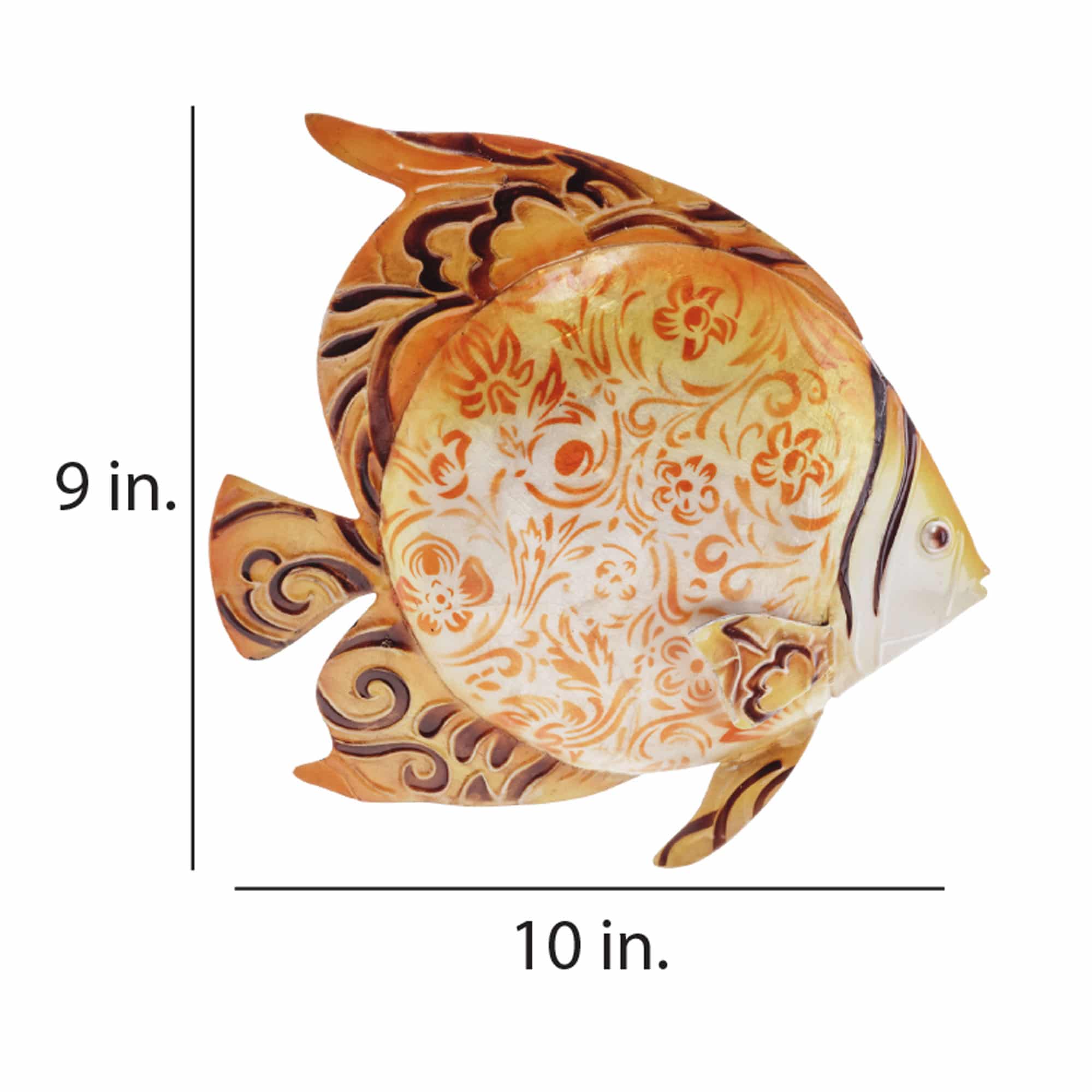
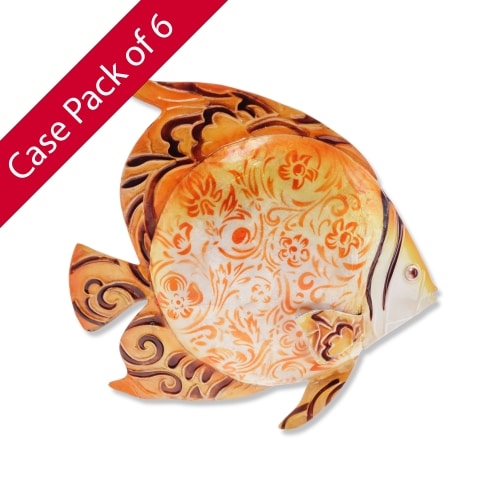 Case of 6 It's big. It's round and it's called an Opah. It looks like a goldfish that seriously outgrew its bowl. The Opah's bright orange is represented in this piece. Instead of spots, the artist took license and painted intricate floral patterns on top of capiz shells. The artist continues by pressing patterns into the tin both in the fins and the face of this magnificent fish. The basic frame of the wall fish is created using tin, which is powder coated as a black finish. The frame is reinforced using wrought iron wire along the inner edge. Capiz is an oyster shell and the primary purpose of the oyster is as a source of food. However, the by-product, the shell, can be used for decoration. Due to it being a natural material, the natural colors of the capiz can come through as tans and browns underneath the paint.
Case of 6 It's big. It's round and it's called an Opah. It looks like a goldfish that seriously outgrew its bowl. The Opah's bright orange is represented in this piece. Instead of spots, the artist took license and painted intricate floral patterns on top of capiz shells. The artist continues by pressing patterns into the tin both in the fins and the face of this magnificent fish. The basic frame of the wall fish is created using tin, which is powder coated as a black finish. The frame is reinforced using wrought iron wire along the inner edge. Capiz is an oyster shell and the primary purpose of the oyster is as a source of food. However, the by-product, the shell, can be used for decoration. Due to it being a natural material, the natural colors of the capiz can come through as tans and browns underneath the paint. -
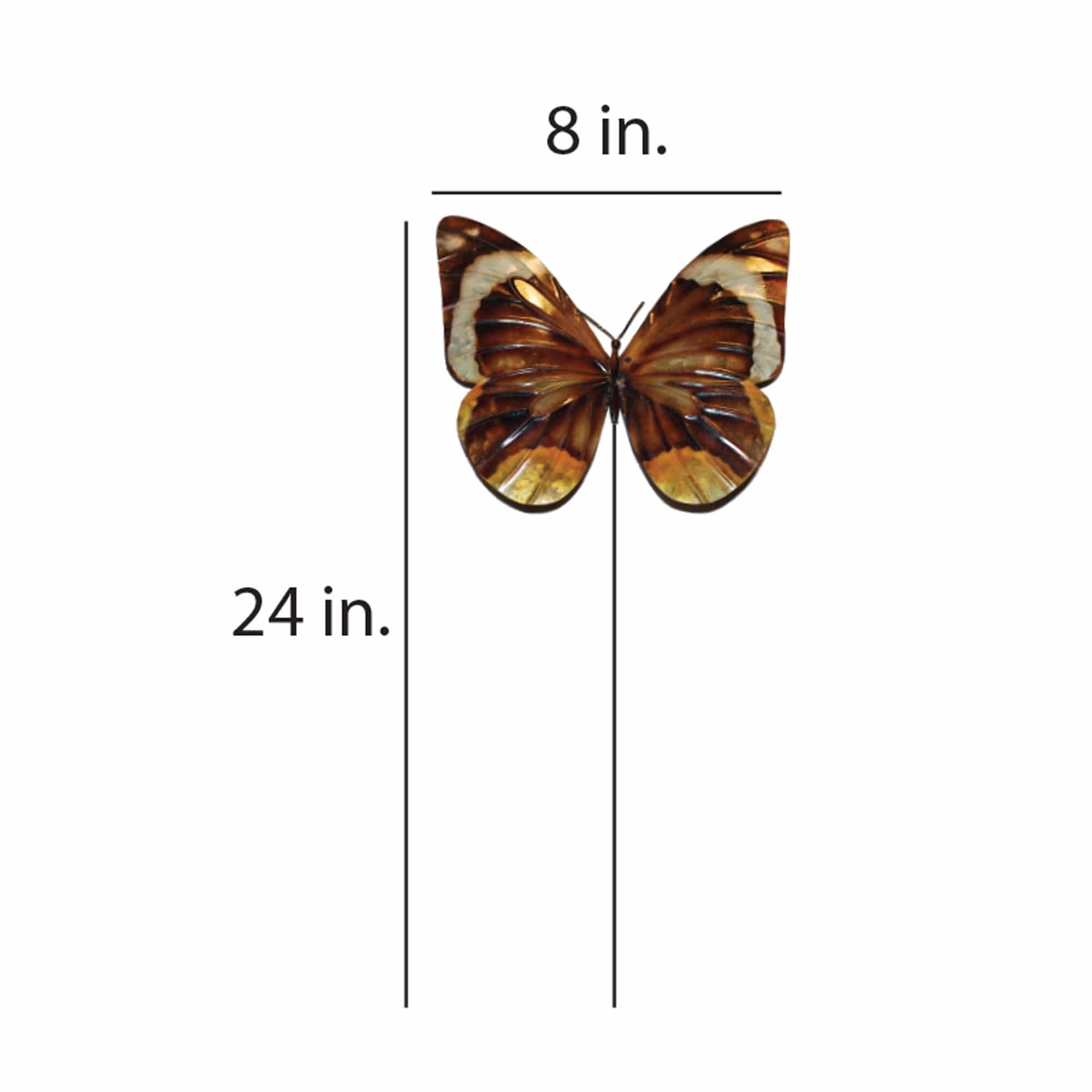
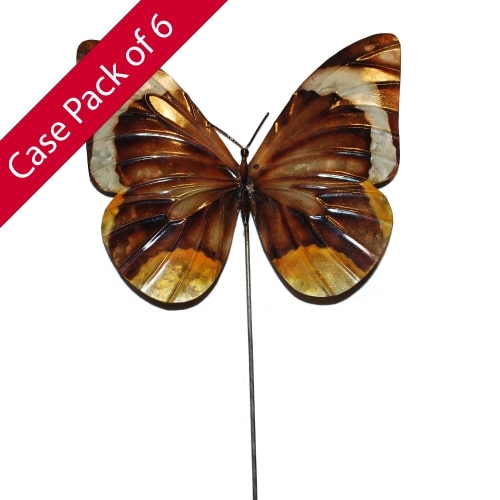 Case of 6 Neutral earth tones fill the body of this butterfly. A beautiful autumn brown sets around highlights of pearl and yellow. Whether placed with a potted plant or in a garden bed, this butterfly will add the finishing touch to any environment. Handcrafted from metal then hand-painted and sealed.
Case of 6 Neutral earth tones fill the body of this butterfly. A beautiful autumn brown sets around highlights of pearl and yellow. Whether placed with a potted plant or in a garden bed, this butterfly will add the finishing touch to any environment. Handcrafted from metal then hand-painted and sealed. -

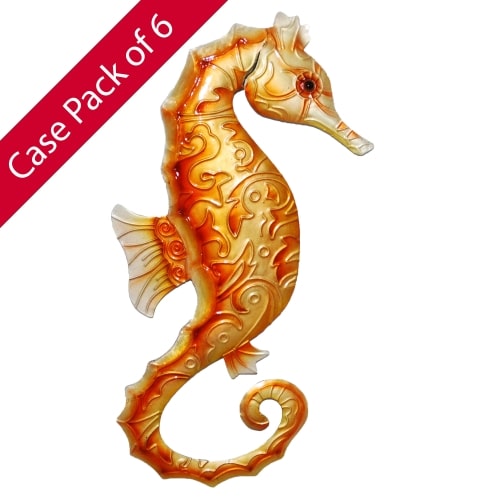 Case of 6 The seahorse has captured the minds and imaginations of people across all cultures for thousands of years. Seen as a symbol of good luck, strength and safety, this unique and beautiful animal is as charming as it is mysterious. The artist captures the beauty of the seahorse with a raised fine, high shine, hand-painted finish, and elegant mother of pearl chest and forefront. The basic frame of the wall seahorse is created using tin, which is powder coated as a black finish. Capiz is an oyster shell and the primary purpose of the oyster is as a source of food. However, the by-product, the shell, can be used for decoration. Due to it being a natural material, the natural colors of the capiz can come through as tans and browns.
Case of 6 The seahorse has captured the minds and imaginations of people across all cultures for thousands of years. Seen as a symbol of good luck, strength and safety, this unique and beautiful animal is as charming as it is mysterious. The artist captures the beauty of the seahorse with a raised fine, high shine, hand-painted finish, and elegant mother of pearl chest and forefront. The basic frame of the wall seahorse is created using tin, which is powder coated as a black finish. Capiz is an oyster shell and the primary purpose of the oyster is as a source of food. However, the by-product, the shell, can be used for decoration. Due to it being a natural material, the natural colors of the capiz can come through as tans and browns. -
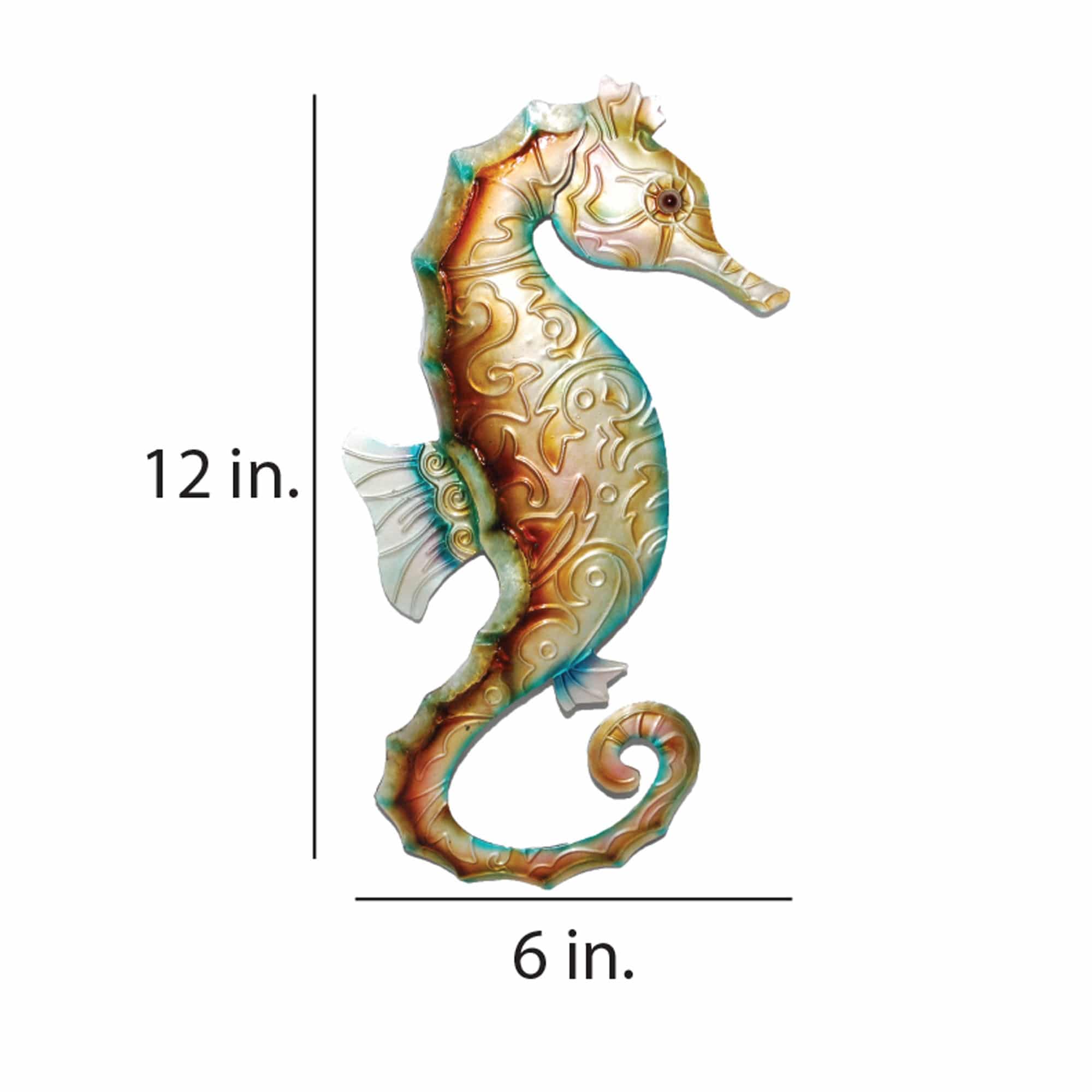
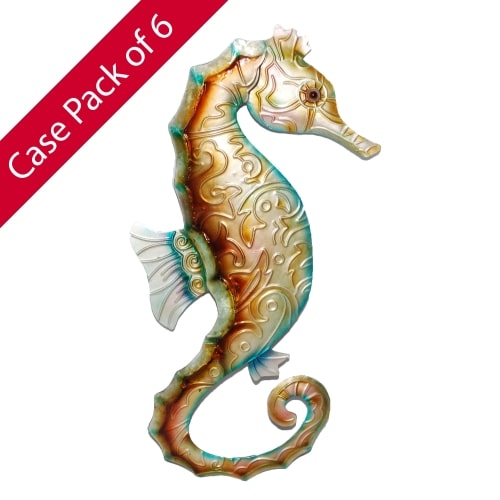 Case of 6 The seahorse has captured the minds and imaginations of people across all cultures for thousands of years. Seen as a symbol of good luck, strength and safety, this unique and beautiful animal is as charming as it is mysterious. The artist captures the beauty of the seahorse with a raised fine, high shine, hand-painted finish, and elegant mother of pearl chest and forefront. The basic frame of the wall seahorse is created using tin, which is powder coated as a black finish. Capiz is an oyster shell and the primary purpose of the oyster is as a source of food. However, the by-product, the shell, can be used for decoration. Due to it being a natural material, the natural colors of the capiz can come through as tans and browns.
Case of 6 The seahorse has captured the minds and imaginations of people across all cultures for thousands of years. Seen as a symbol of good luck, strength and safety, this unique and beautiful animal is as charming as it is mysterious. The artist captures the beauty of the seahorse with a raised fine, high shine, hand-painted finish, and elegant mother of pearl chest and forefront. The basic frame of the wall seahorse is created using tin, which is powder coated as a black finish. Capiz is an oyster shell and the primary purpose of the oyster is as a source of food. However, the by-product, the shell, can be used for decoration. Due to it being a natural material, the natural colors of the capiz can come through as tans and browns. -
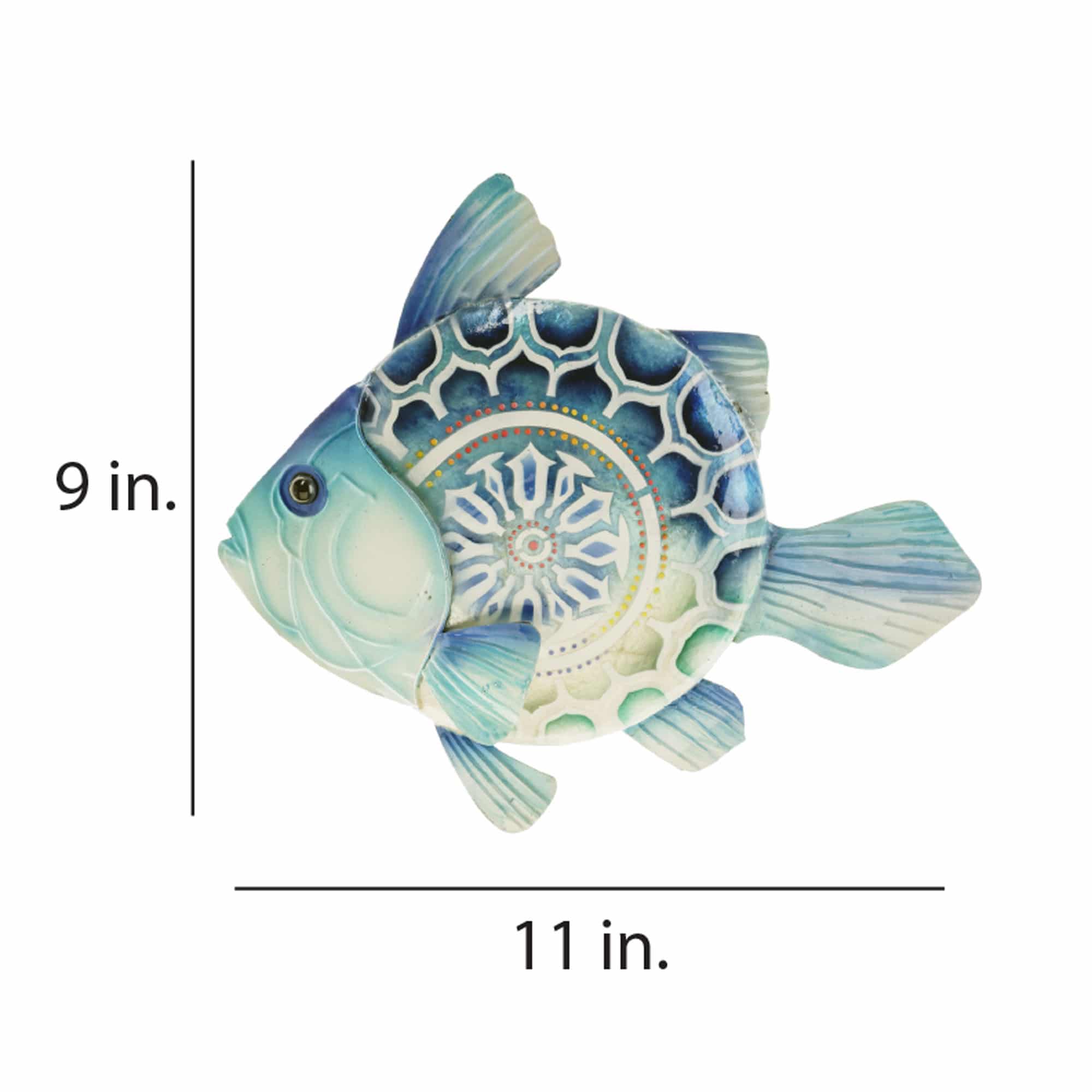
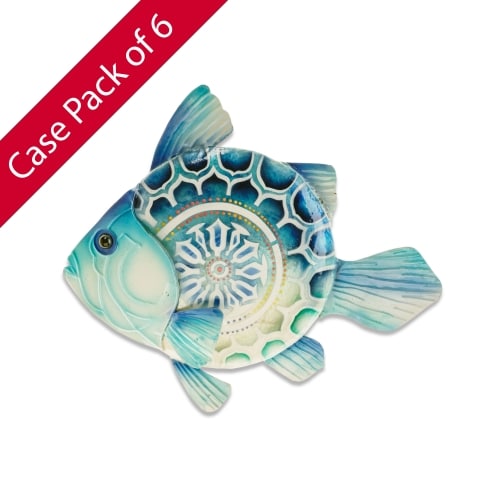 Case of 6 This fish is an artist's interpretation of the blue sea bass. The rich blue tones are common not only on the fish, but also the water within which it resides. The spiky fines and the scaly skin are also captured by the artist. The center of the fish is most interesting as it is adorned with capiz shell, which is hand-painted in wavy lines, representing the movement of the ocean as well as the fish. This piece will bring in color and design to your space and a smile to your face. The basic frame of the wall fish is created using tin, which is powder coated as a black finish. The frame is reinforced using wrought iron wire along the inner edge. Capiz is an oyster shell and the primary purpose of the oyster is as a source of food. However, the by-product, the shell, can be used for decoration. Due to it being a natural material, the natural colors of the capiz can come through as tans and browns underneath the paint.
Case of 6 This fish is an artist's interpretation of the blue sea bass. The rich blue tones are common not only on the fish, but also the water within which it resides. The spiky fines and the scaly skin are also captured by the artist. The center of the fish is most interesting as it is adorned with capiz shell, which is hand-painted in wavy lines, representing the movement of the ocean as well as the fish. This piece will bring in color and design to your space and a smile to your face. The basic frame of the wall fish is created using tin, which is powder coated as a black finish. The frame is reinforced using wrought iron wire along the inner edge. Capiz is an oyster shell and the primary purpose of the oyster is as a source of food. However, the by-product, the shell, can be used for decoration. Due to it being a natural material, the natural colors of the capiz can come through as tans and browns underneath the paint. -
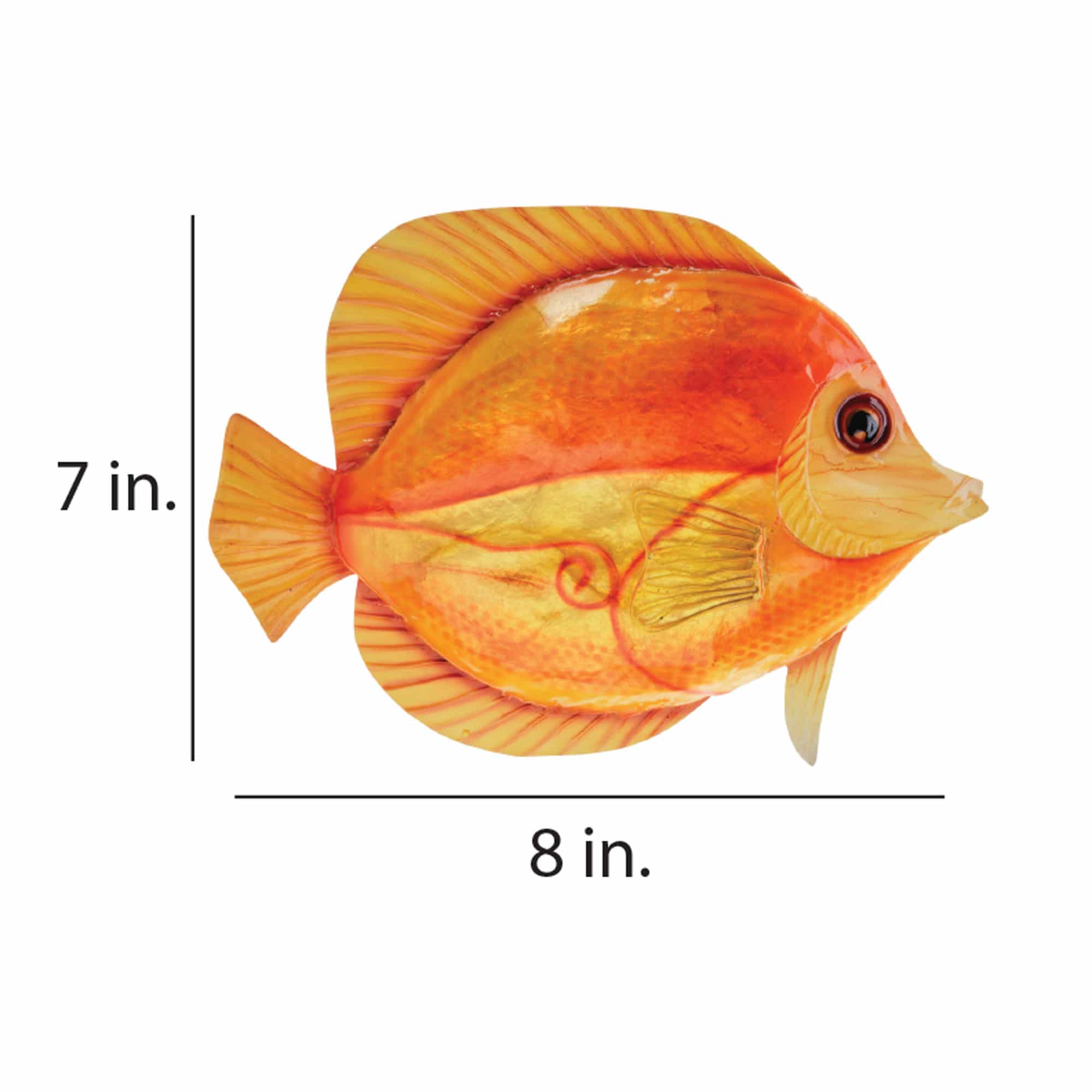
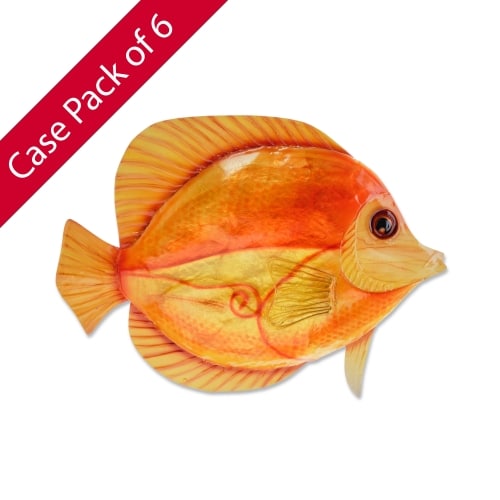 Case of 6 The discus fish is native to the Amazon river basin. These fish are known for their distinctive shape, bright colors, and unique patterns. The artist who painted this fish paid attention to the interacting color patterns. Using capiz shell, he emulated the natural scales of this fish. The basic frame of the wall fish is created using tin, which is powder coated as a black finish. The frame is reinforced using wrought iron wire along the inner edge. Capiz is an oyster shell and the primary purpose of the oyster is as a source of food. However, the by-product, the shell, can be used for decoration. Due to it being a natural material, the natural colors of the capiz can come through as tans and browns underneath the paint.
Case of 6 The discus fish is native to the Amazon river basin. These fish are known for their distinctive shape, bright colors, and unique patterns. The artist who painted this fish paid attention to the interacting color patterns. Using capiz shell, he emulated the natural scales of this fish. The basic frame of the wall fish is created using tin, which is powder coated as a black finish. The frame is reinforced using wrought iron wire along the inner edge. Capiz is an oyster shell and the primary purpose of the oyster is as a source of food. However, the by-product, the shell, can be used for decoration. Due to it being a natural material, the natural colors of the capiz can come through as tans and browns underneath the paint. -
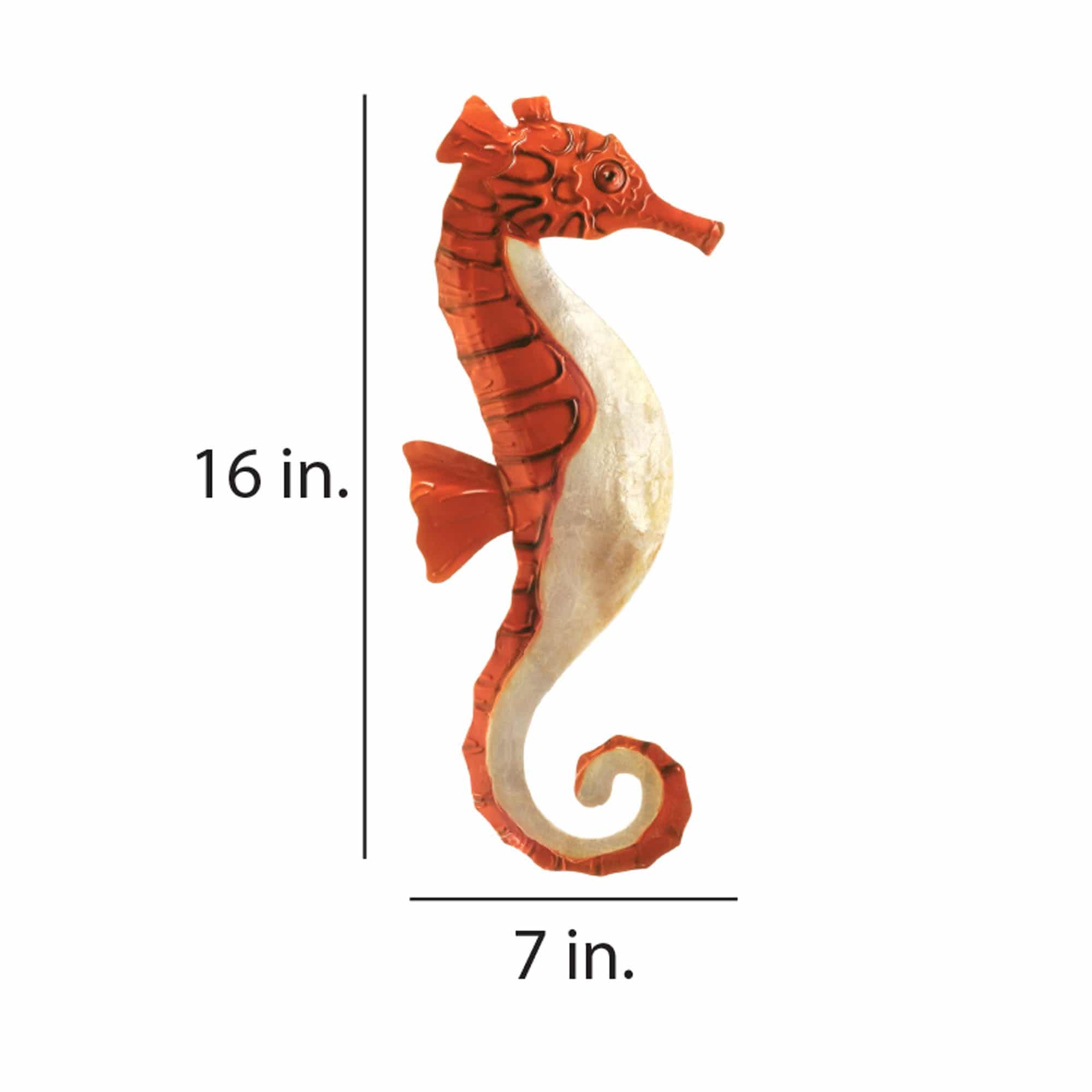
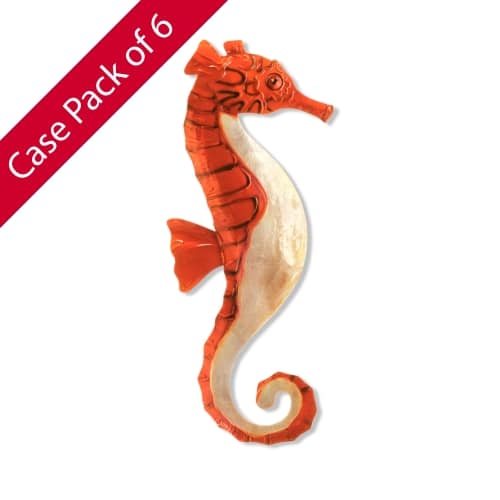 Case of 6 The seahorse has captured the minds and imaginations of people across all cultures for thousands of years. Seen as a symbol of good luck, strength and safety, this unique and beautiful animal is as charming as it is mysterious. The artist captures the beauty of the seahorse with a raised fine, high shine, hand-painted finish, and elegant mother of pearl chest and forefront. The basic frame of the wall seahorse is created using tin, which is powder coated as a black finish. Capiz is an oyster shell and the primary purpose of the oyster is as a source of food. However, the by-product, the shell, can be used for decoration. Due to it being a natural material, the natural colors of the capiz can come through as tans and browns.
Case of 6 The seahorse has captured the minds and imaginations of people across all cultures for thousands of years. Seen as a symbol of good luck, strength and safety, this unique and beautiful animal is as charming as it is mysterious. The artist captures the beauty of the seahorse with a raised fine, high shine, hand-painted finish, and elegant mother of pearl chest and forefront. The basic frame of the wall seahorse is created using tin, which is powder coated as a black finish. Capiz is an oyster shell and the primary purpose of the oyster is as a source of food. However, the by-product, the shell, can be used for decoration. Due to it being a natural material, the natural colors of the capiz can come through as tans and browns. -
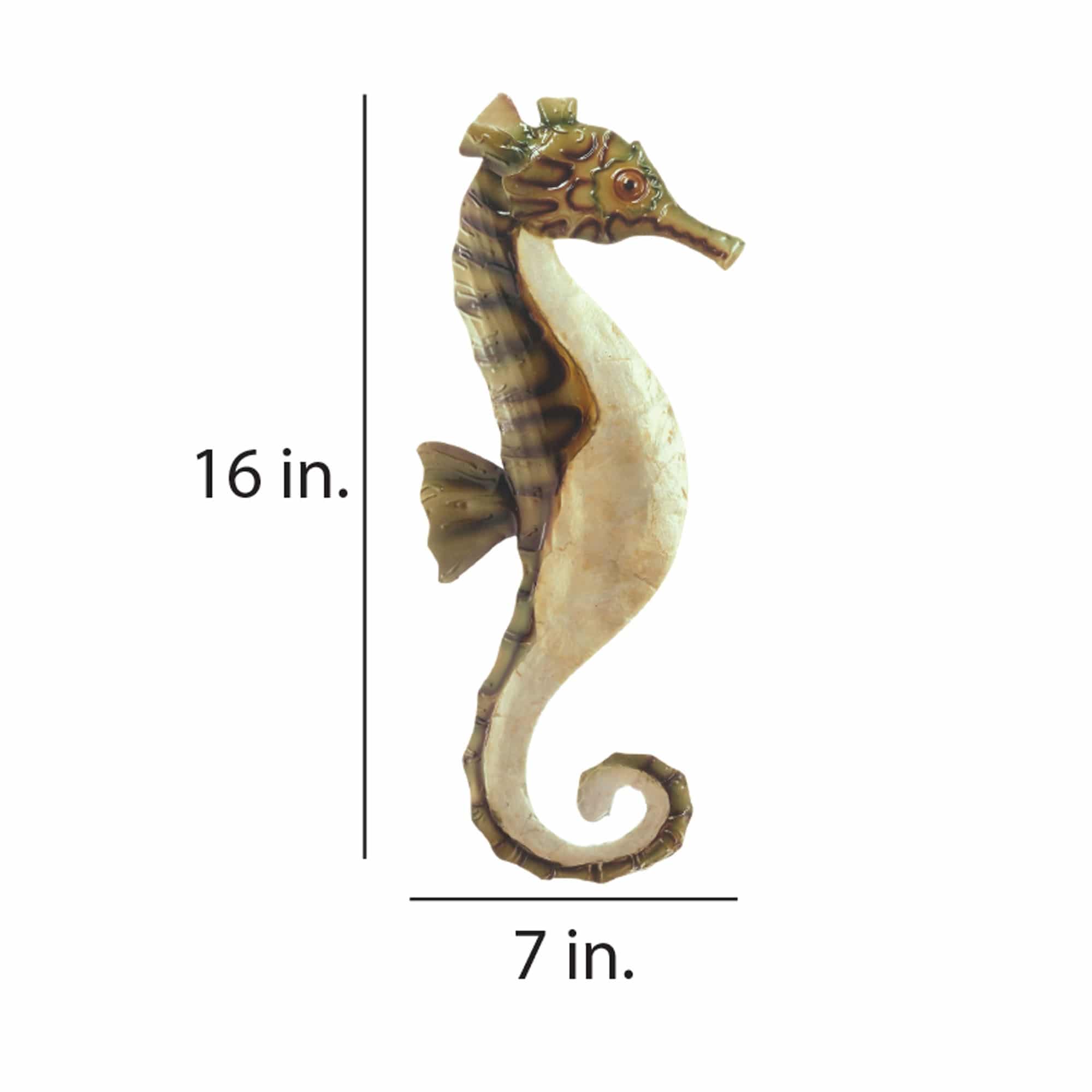
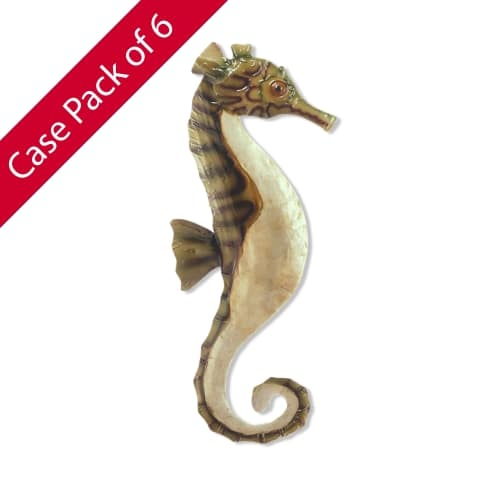 Case of 6 The seahorse has captured the minds and imaginations of people across all cultures for thousands of years. Seen as a symbol of good luck, strength and safety, this unique and beautiful animal is as charming as it is mysterious. The artist captures the beauty of the seahorse with a raised fine, high shine, hand-painted finish, and elegant mother of pearl chest and forefront. The basic frame of the wall seahorse is created using tin, which is powder coated as a black finish. Capiz is an oyster shell and the primary purpose of the oyster is as a source of food. However, the by-product, the shell, can be used for decoration. Due to it being a natural material, the natural colors of the capiz can come through as tans and browns.
Case of 6 The seahorse has captured the minds and imaginations of people across all cultures for thousands of years. Seen as a symbol of good luck, strength and safety, this unique and beautiful animal is as charming as it is mysterious. The artist captures the beauty of the seahorse with a raised fine, high shine, hand-painted finish, and elegant mother of pearl chest and forefront. The basic frame of the wall seahorse is created using tin, which is powder coated as a black finish. Capiz is an oyster shell and the primary purpose of the oyster is as a source of food. However, the by-product, the shell, can be used for decoration. Due to it being a natural material, the natural colors of the capiz can come through as tans and browns. -
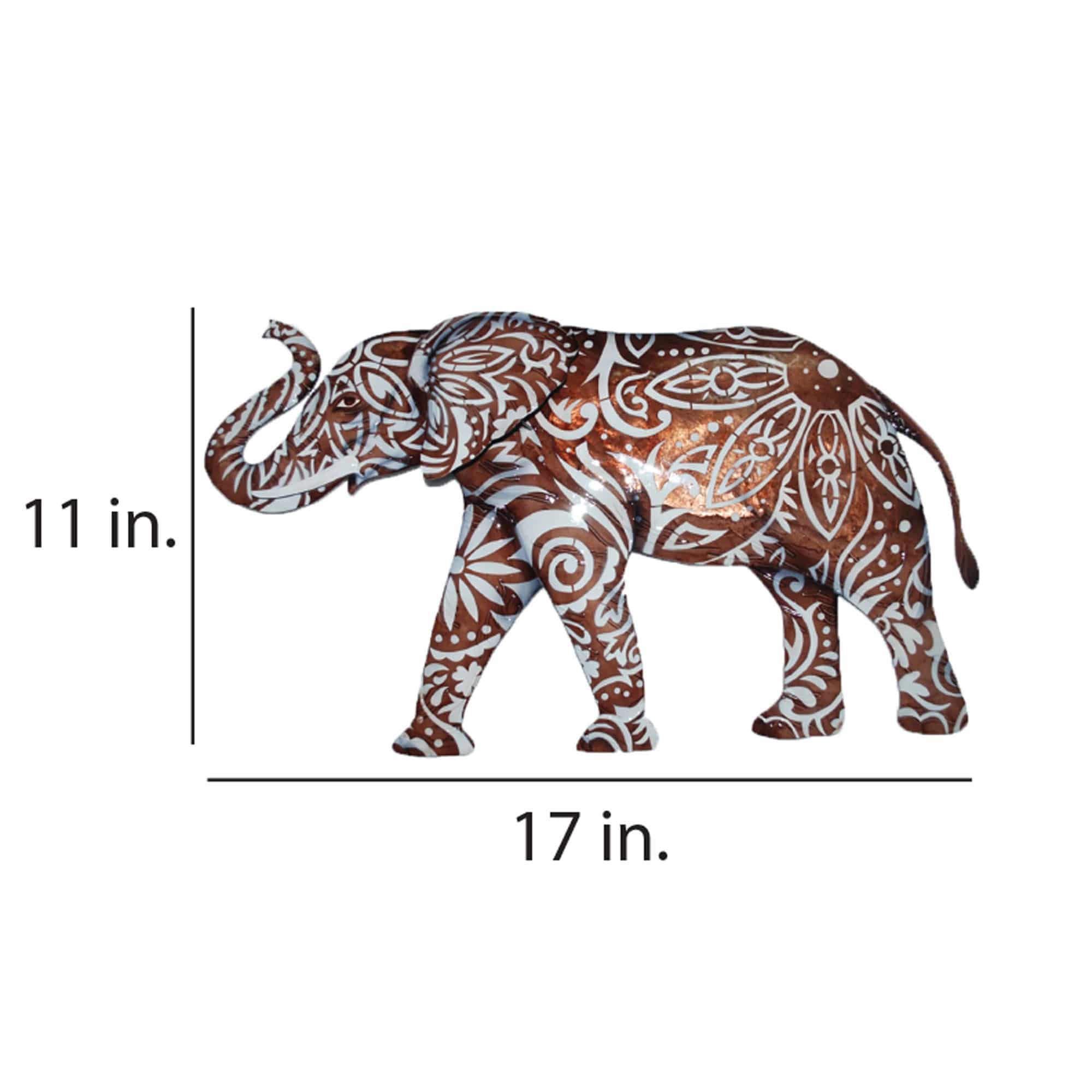
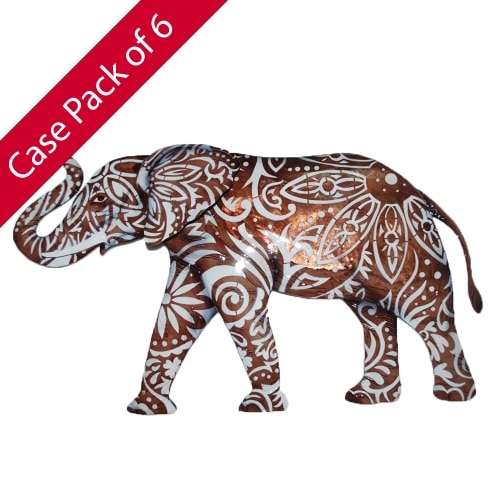 Case of 6 According to feng shui, an elephant with its trunk raised will shower good luck to those around it. It is a symbol for intelligence, curiosity, kindness and strength. The basic shape of this handcrafted metal elephant has its powerful trunk raised due to the importance of the symbolism. Furthermore, the artisan hand-paints the body in a colorful pattern influenced by designs from different Eastern cultures. Placing such a symbol near a door is said to welcome beneficial energy into that space. The basic frame of the is created using tin, which is powder coated with a black finish. The frame is reinforced using tin wire along the inner edge. Capiz is an oyster shell and the primary purpose of the oyster is as a source of food. However, the by-product, the shell, can be used for decoration. Due to it being a natural material, the natural colors of the capiz come through as tans and browns underneath the paint. The shell is then painted the bold colors you see. The entire front facing piece is carefully hand-painted.
Case of 6 According to feng shui, an elephant with its trunk raised will shower good luck to those around it. It is a symbol for intelligence, curiosity, kindness and strength. The basic shape of this handcrafted metal elephant has its powerful trunk raised due to the importance of the symbolism. Furthermore, the artisan hand-paints the body in a colorful pattern influenced by designs from different Eastern cultures. Placing such a symbol near a door is said to welcome beneficial energy into that space. The basic frame of the is created using tin, which is powder coated with a black finish. The frame is reinforced using tin wire along the inner edge. Capiz is an oyster shell and the primary purpose of the oyster is as a source of food. However, the by-product, the shell, can be used for decoration. Due to it being a natural material, the natural colors of the capiz come through as tans and browns underneath the paint. The shell is then painted the bold colors you see. The entire front facing piece is carefully hand-painted. -
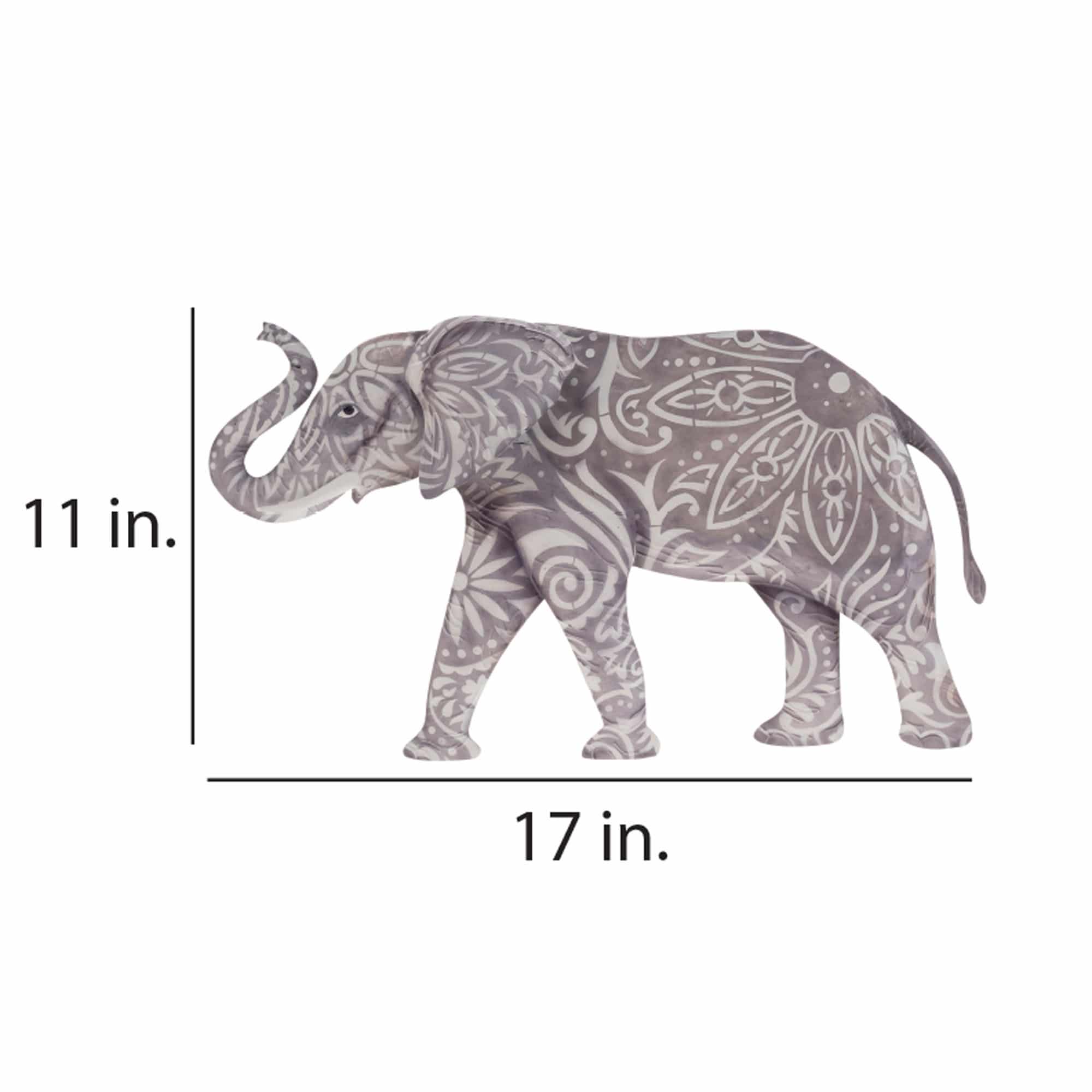
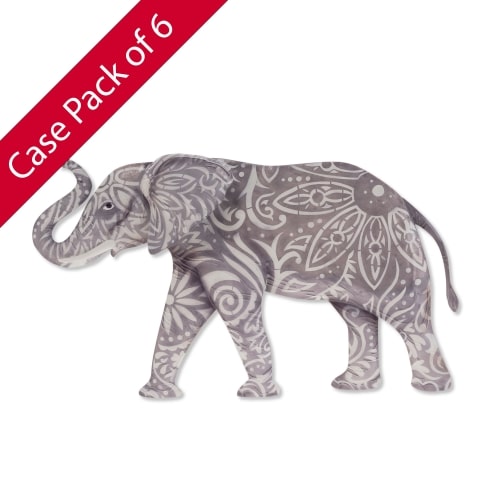 Case of 6 According to feng shui, an elephant with its trunk raised will shower good luck to those around it. It is a symbol for intelligence, curiosity, kindness and strength. The basic shape of this handcrafted metal elephant has its powerful trunk raised due to the importance of the symbolism. Furthermore, the artisan hand-paints the body in a colorful pattern influenced by designs from different Eastern cultures. Placing such a symbol near a door is said to welcome beneficial energy into that space. The basic frame of the is created using tin, which is powder coated with a black finish. The frame is reinforced using tin wire along the inner edge. Capiz is an oyster shell and the primary purpose of the oyster is as a source of food. However, the by-product, the shell, can be used for decoration. Due to it being a natural material, the natural colors of the capiz come through as tans and browns underneath the paint. The shell is then painted the bold colors you see. The entire front facing piece is carefully hand-painted.
Case of 6 According to feng shui, an elephant with its trunk raised will shower good luck to those around it. It is a symbol for intelligence, curiosity, kindness and strength. The basic shape of this handcrafted metal elephant has its powerful trunk raised due to the importance of the symbolism. Furthermore, the artisan hand-paints the body in a colorful pattern influenced by designs from different Eastern cultures. Placing such a symbol near a door is said to welcome beneficial energy into that space. The basic frame of the is created using tin, which is powder coated with a black finish. The frame is reinforced using tin wire along the inner edge. Capiz is an oyster shell and the primary purpose of the oyster is as a source of food. However, the by-product, the shell, can be used for decoration. Due to it being a natural material, the natural colors of the capiz come through as tans and browns underneath the paint. The shell is then painted the bold colors you see. The entire front facing piece is carefully hand-painted. -

 Case of 6 From the twisted wrought iron wire representing the rope of a sailboat to the folded wire representing the sails, this piece really is awe inspiring. The details of this sailboat don't stop at just the metal work; even the distressed silver color, with a hint of copper, imitates life at sea. This sailboat will make a statement in any living room, bedroom, dining room, or office, no matter if it is by itself or accompanied with other nautical themed decor. The sailboat is constructed by hand using several different gauges of wrought iron wire. There are nearly 120 strands spot welded together to give the depth and dimensionality to this piece. It is then painted by hand and finally set to rest on a wood composite stand, which is finished with a gray stain.
Case of 6 From the twisted wrought iron wire representing the rope of a sailboat to the folded wire representing the sails, this piece really is awe inspiring. The details of this sailboat don't stop at just the metal work; even the distressed silver color, with a hint of copper, imitates life at sea. This sailboat will make a statement in any living room, bedroom, dining room, or office, no matter if it is by itself or accompanied with other nautical themed decor. The sailboat is constructed by hand using several different gauges of wrought iron wire. There are nearly 120 strands spot welded together to give the depth and dimensionality to this piece. It is then painted by hand and finally set to rest on a wood composite stand, which is finished with a gray stain. -
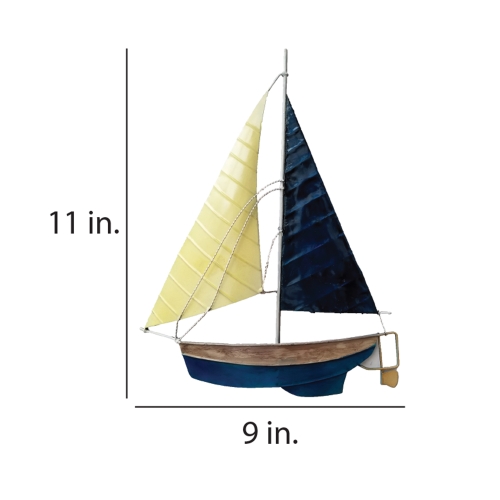
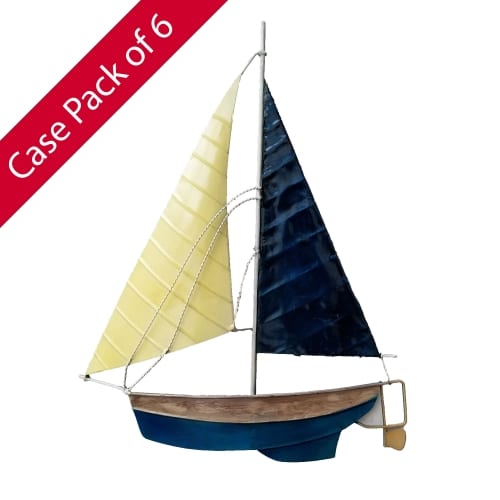 Case of 6 The sailboat is a common and familiar scene at most beaches. The Yellow Blue and Gray Sailboat Wall Decor brings home the well-known features of this iconic boat. The spinnaker is fully inflated and pops away from the wall with the rope tangling on the side. The headsail, usually the more colorful, is adorned with capiz shell which gives it a shine as it reflects the sunlight. The artist enhances the authenticity of the hull by painting it with a distressed finish, showing a well loved and traveled vessel. The basic frame of the wall sailboat is created using wrought iron, which is powder coated in a black finish. The frame is reinforced using wrought iron wire inner edge or outer edge. Capiz is an oyster shell and the primary purpose of the oyster is as a source of food. However, the by-product, the shell, can be used for decoration. Due to it being a natural material, the natural colors of the capiz can come through as tans and browns underneath the paint. The final step is to hand-paint the sailboat, giving this piece a rustic finish and feel.
Case of 6 The sailboat is a common and familiar scene at most beaches. The Yellow Blue and Gray Sailboat Wall Decor brings home the well-known features of this iconic boat. The spinnaker is fully inflated and pops away from the wall with the rope tangling on the side. The headsail, usually the more colorful, is adorned with capiz shell which gives it a shine as it reflects the sunlight. The artist enhances the authenticity of the hull by painting it with a distressed finish, showing a well loved and traveled vessel. The basic frame of the wall sailboat is created using wrought iron, which is powder coated in a black finish. The frame is reinforced using wrought iron wire inner edge or outer edge. Capiz is an oyster shell and the primary purpose of the oyster is as a source of food. However, the by-product, the shell, can be used for decoration. Due to it being a natural material, the natural colors of the capiz can come through as tans and browns underneath the paint. The final step is to hand-paint the sailboat, giving this piece a rustic finish and feel. -
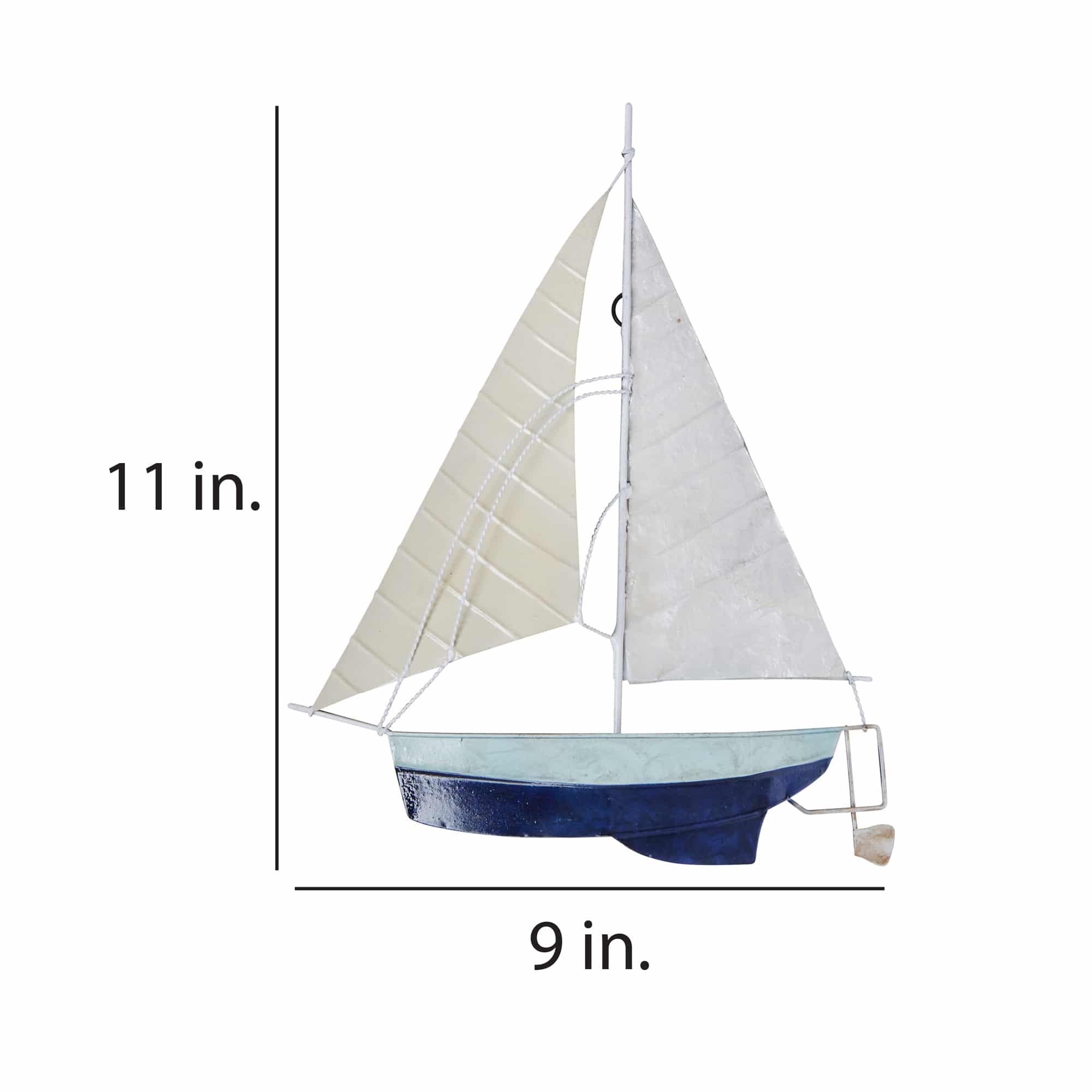
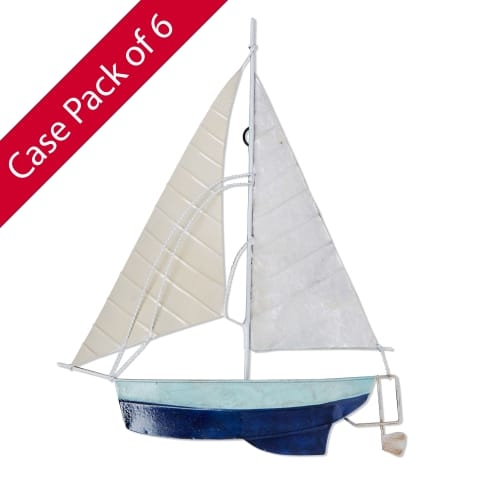 Case of 6 The sailboat is a common and familiar scene at most beaches. Cream Gold and Blue Sailboat Wall Decor brings home the well-known features of this iconic boat. The spinnaker is fully inflated and pops away from the wall with the rope tangling on the side. The headsail, usually the more colorful, is adorned with capiz shell which gives it a shine as it reflects the sunlight. The artist enhances the authenticity of the hull by painting it with a distressed finish, showing a well loved and traveled vessel. The basic frame of the wall sailboat is created using wrought iron, which is powder coated in a black finish. The frame is reinforced using wrought iron wire inner edge or outer edge. Capiz is an oyster shell and the primary purpose of the oyster is as a source of food. However, the by-product, the shell, can be used for decoration. Due to it being a natural material, the natural colors of the capiz can come through as tans and browns underneath the paint. The final step is to hand-paint the sailboat, giving this piece a rustic finish and feel.
Case of 6 The sailboat is a common and familiar scene at most beaches. Cream Gold and Blue Sailboat Wall Decor brings home the well-known features of this iconic boat. The spinnaker is fully inflated and pops away from the wall with the rope tangling on the side. The headsail, usually the more colorful, is adorned with capiz shell which gives it a shine as it reflects the sunlight. The artist enhances the authenticity of the hull by painting it with a distressed finish, showing a well loved and traveled vessel. The basic frame of the wall sailboat is created using wrought iron, which is powder coated in a black finish. The frame is reinforced using wrought iron wire inner edge or outer edge. Capiz is an oyster shell and the primary purpose of the oyster is as a source of food. However, the by-product, the shell, can be used for decoration. Due to it being a natural material, the natural colors of the capiz can come through as tans and browns underneath the paint. The final step is to hand-paint the sailboat, giving this piece a rustic finish and feel. -
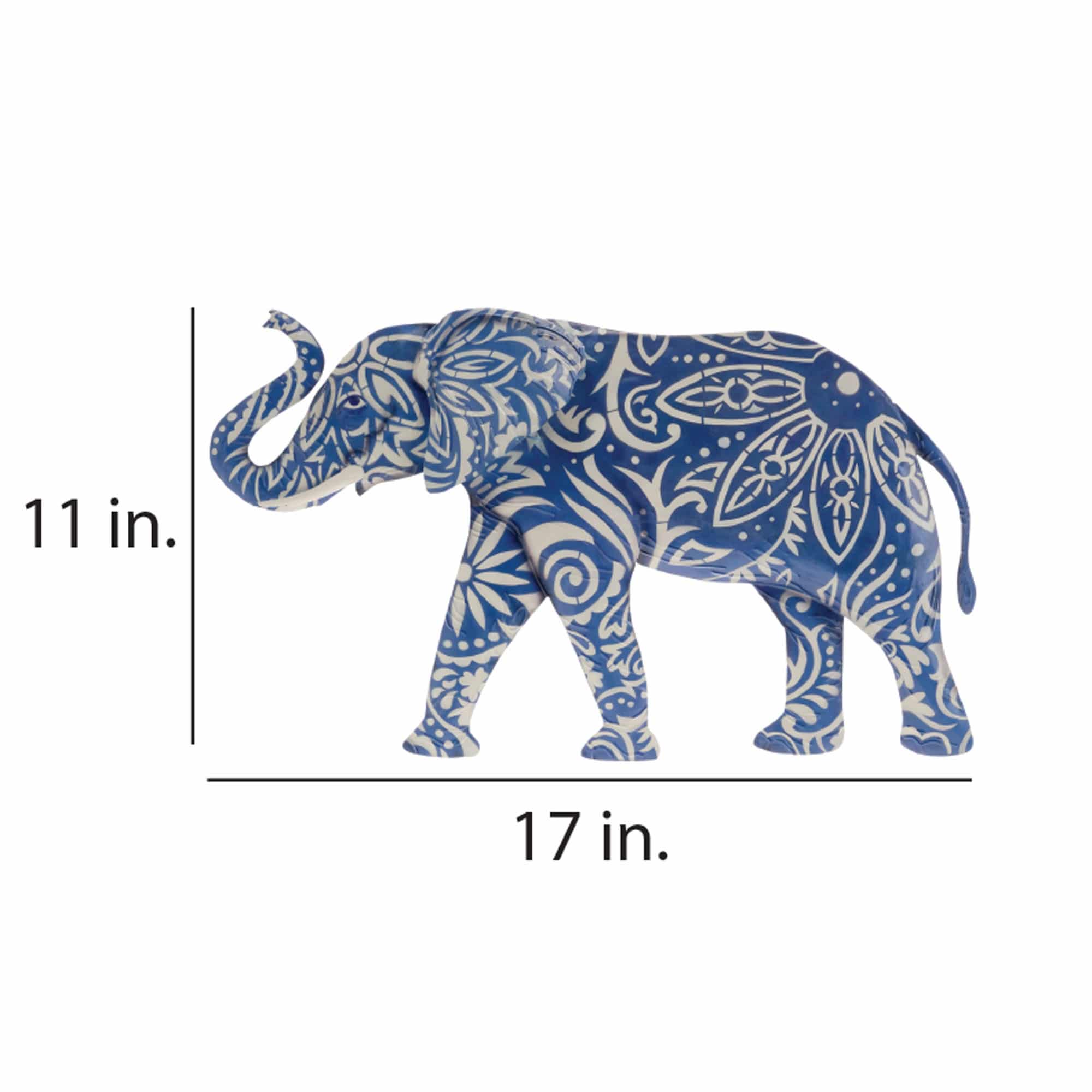
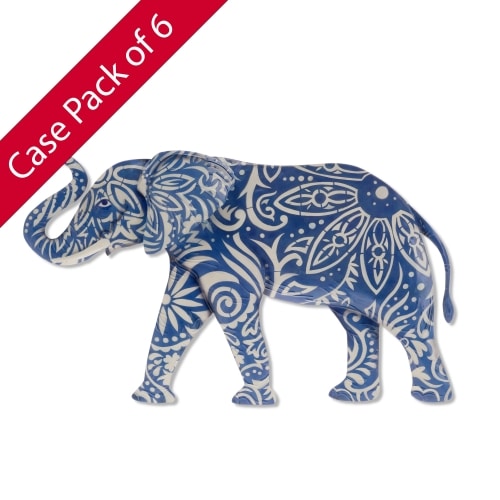 Case of 6 According to feng shui, an elephant with its trunk raised will shower good luck to those around it. It is a symbol for intelligence, curiosity, kindness and strength. The basic shape of this handcrafted metal elephant has its powerful trunk raised due to the importance of the symbolism. Furthermore, the artisan hand-paints the body in a colorful pattern influenced by designs from different Eastern cultures. Placing such a symbol near a door is said to welcome beneficial energy into that space. The basic frame of the is created using tin, which is powder coated with a black finish. The frame is reinforced using tin wire along the inner edge. Capiz is an oyster shell and the primary purpose of the oyster is as a source of food. However, the by-product, the shell, can be used for decoration. Due to it being a natural material, the natural colors of the capiz come through as tans and browns underneath the paint. The shell is then painted the bold colors you see. The entire front facing piece is carefully hand-painted.
Case of 6 According to feng shui, an elephant with its trunk raised will shower good luck to those around it. It is a symbol for intelligence, curiosity, kindness and strength. The basic shape of this handcrafted metal elephant has its powerful trunk raised due to the importance of the symbolism. Furthermore, the artisan hand-paints the body in a colorful pattern influenced by designs from different Eastern cultures. Placing such a symbol near a door is said to welcome beneficial energy into that space. The basic frame of the is created using tin, which is powder coated with a black finish. The frame is reinforced using tin wire along the inner edge. Capiz is an oyster shell and the primary purpose of the oyster is as a source of food. However, the by-product, the shell, can be used for decoration. Due to it being a natural material, the natural colors of the capiz come through as tans and browns underneath the paint. The shell is then painted the bold colors you see. The entire front facing piece is carefully hand-painted. -
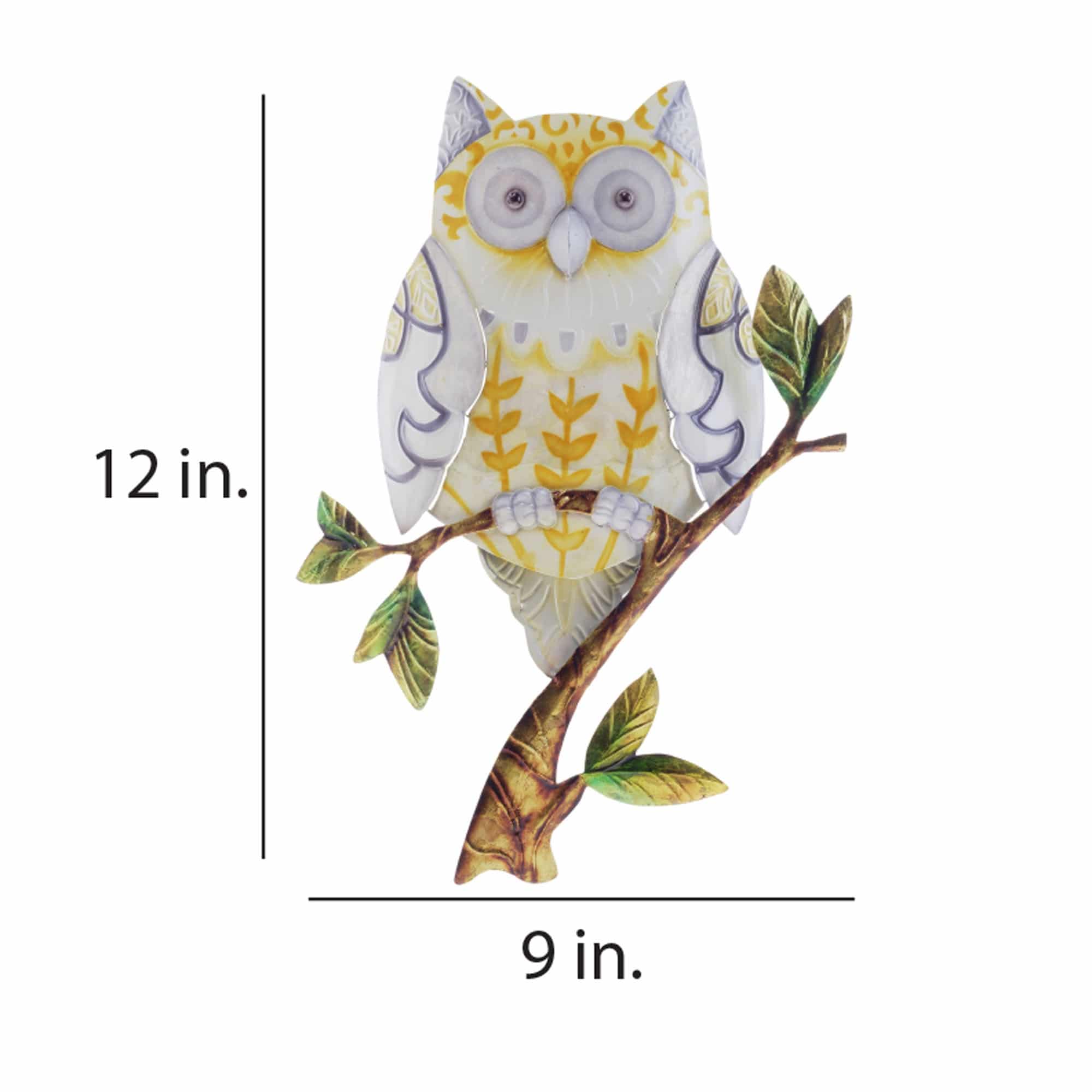
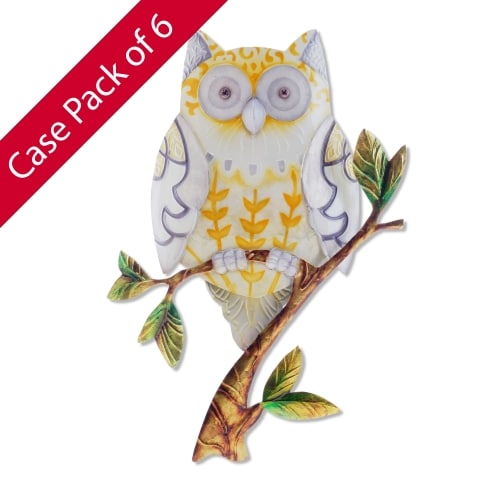 Case of 6 The owl was a bird of prophecy and wisdom in many ancient cultures. Its wide eyes seem to miss nothing and when an owl moves it seems calculated. Even though the colors and designs on the owl are human interpretations, the perched look is defiantly natural. The artist uses capiz shell on the wings to highlight the reflective nature of some of the owl's feathers. The basic frame of the owl is created using tin, which is powder coated with a black finish. The frame is reinforced using tin wire along the inner edge. Capiz is an oyster shell and the primary purpose of the oyster is as a source of food. However, the by-product, the shell, can be used for decoration.
Case of 6 The owl was a bird of prophecy and wisdom in many ancient cultures. Its wide eyes seem to miss nothing and when an owl moves it seems calculated. Even though the colors and designs on the owl are human interpretations, the perched look is defiantly natural. The artist uses capiz shell on the wings to highlight the reflective nature of some of the owl's feathers. The basic frame of the owl is created using tin, which is powder coated with a black finish. The frame is reinforced using tin wire along the inner edge. Capiz is an oyster shell and the primary purpose of the oyster is as a source of food. However, the by-product, the shell, can be used for decoration. -

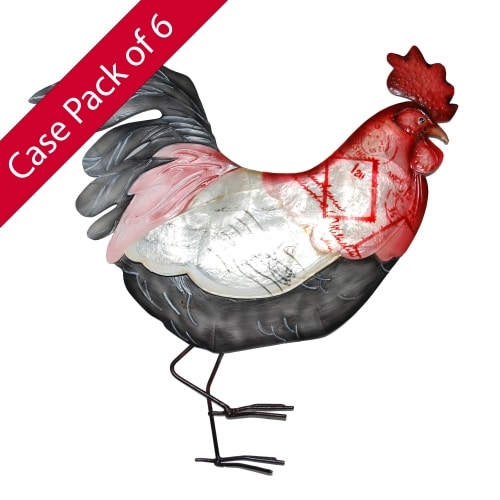 Case of 6 This vintage designed rooster is influenced by the designs of the early 20th century. The artist took great care in making sure the rooster's comb and wattle appear authentic by pressing texture into the metal frame. Furthermore, the artist made sure to use realistic colors and shading. Even the body and the tail feathers were pressed and cut to mimic the body of a real rooster. However, the center of the rooster deviates from the realism and merges into the nostalgic with what appears to be an envelope of an old handwritten letter. The capiz oyster shell gives an aged patina making the rooster and the letter feel like it has been around for a very long time. The letter is an artistic way of tying in a piece of the old into the new. The basic frame of this piece is created using tin, which is powder coated with a black finish. The frame is reinforced using tin wire along the inner edge. The front of the body is adorned with capiz. Capiz is an oyster shell and the primary purpose of the oyster is as a source of food. However, the by-product, the shell, can be used for decoration. Due to it being a natural material, the natural colors of the capiz may come through as tans and browns underneath the hand-painted surface.
Case of 6 This vintage designed rooster is influenced by the designs of the early 20th century. The artist took great care in making sure the rooster's comb and wattle appear authentic by pressing texture into the metal frame. Furthermore, the artist made sure to use realistic colors and shading. Even the body and the tail feathers were pressed and cut to mimic the body of a real rooster. However, the center of the rooster deviates from the realism and merges into the nostalgic with what appears to be an envelope of an old handwritten letter. The capiz oyster shell gives an aged patina making the rooster and the letter feel like it has been around for a very long time. The letter is an artistic way of tying in a piece of the old into the new. The basic frame of this piece is created using tin, which is powder coated with a black finish. The frame is reinforced using tin wire along the inner edge. The front of the body is adorned with capiz. Capiz is an oyster shell and the primary purpose of the oyster is as a source of food. However, the by-product, the shell, can be used for decoration. Due to it being a natural material, the natural colors of the capiz may come through as tans and browns underneath the hand-painted surface. -

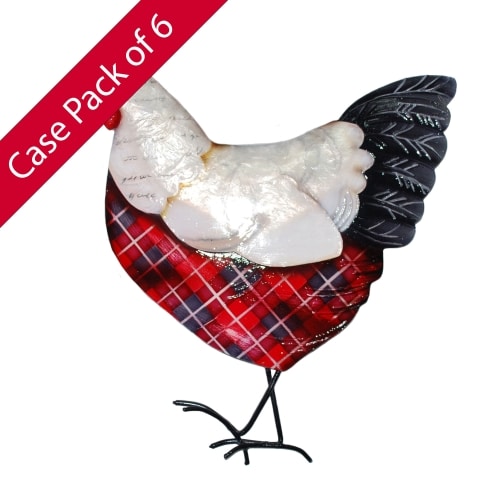 Case of 6 Farm animals are a common theme in the modern farmhouse design with plaid often used as an accent. Featuring modern farmhouse themes, this chicken is both classic and fun in the way the basic colors are portrayed on the familiar design shape. The mother of pearl oyster shell gives the piece an aged patina Modern farmhouse themes also about bringing the old back to new. As an added detail, the neck of the chicken features an excerpt of an old handwritten letter. The basic frame of this piece is created using tin, which is powder coated with a black finish. The frame is reinforced using tin wire along the inner edge. The front of the body is adorned with capiz. Capiz is an oyster shell and the primary purpose of the oyster is as a source of food. However, the by-product, the shell, can be used for decoration. Due to it being a natural material, the natural colors of the capiz may come through as tans and browns underneath the hand-painted surface.
Case of 6 Farm animals are a common theme in the modern farmhouse design with plaid often used as an accent. Featuring modern farmhouse themes, this chicken is both classic and fun in the way the basic colors are portrayed on the familiar design shape. The mother of pearl oyster shell gives the piece an aged patina Modern farmhouse themes also about bringing the old back to new. As an added detail, the neck of the chicken features an excerpt of an old handwritten letter. The basic frame of this piece is created using tin, which is powder coated with a black finish. The frame is reinforced using tin wire along the inner edge. The front of the body is adorned with capiz. Capiz is an oyster shell and the primary purpose of the oyster is as a source of food. However, the by-product, the shell, can be used for decoration. Due to it being a natural material, the natural colors of the capiz may come through as tans and browns underneath the hand-painted surface. -
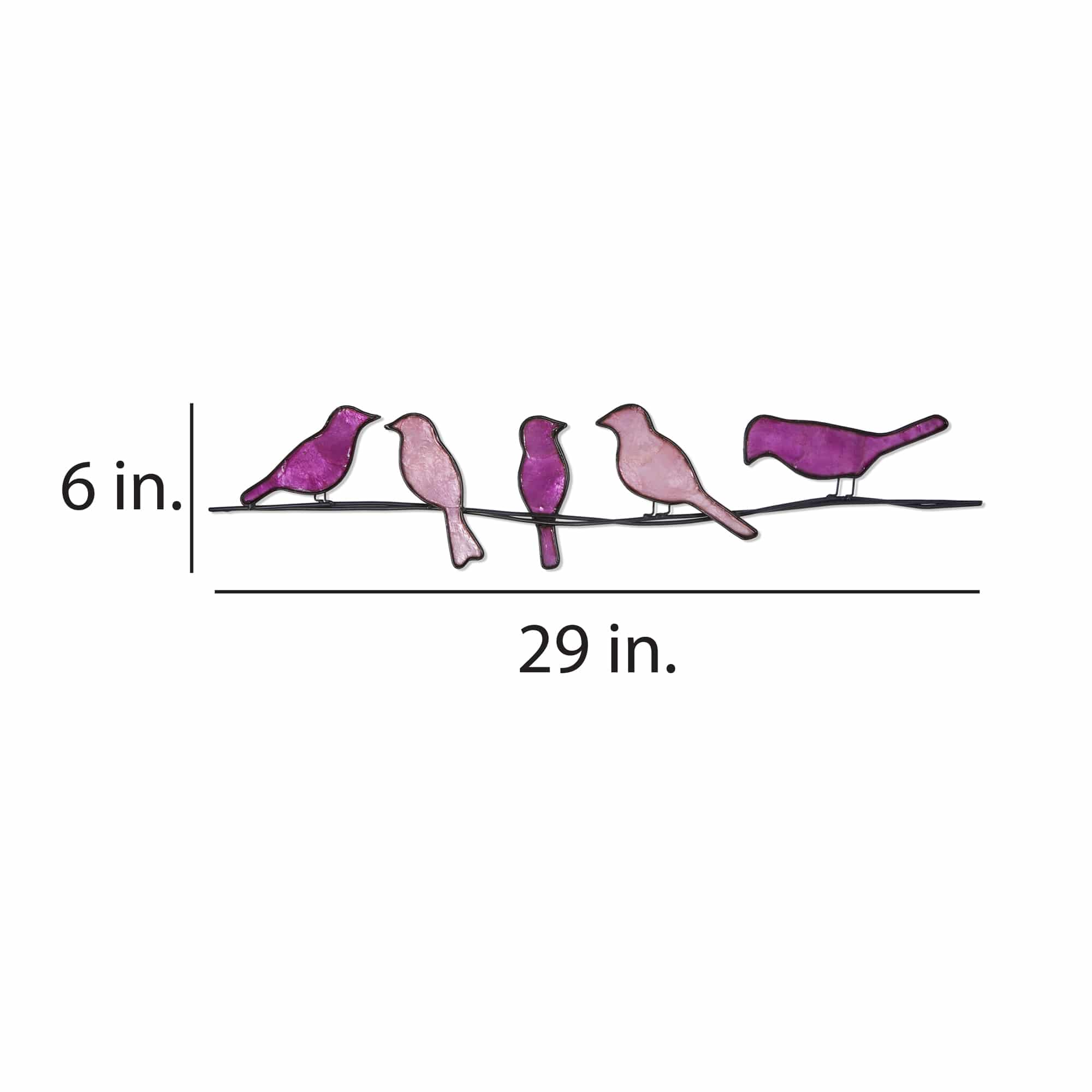
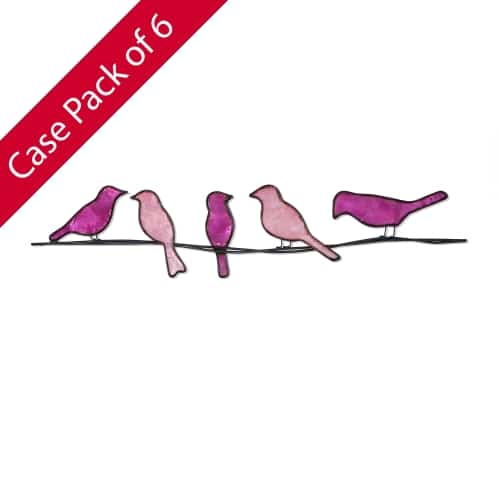 Case of 6 An old parable states that five birds were resting on a wire. Two decided to fly south. How many were birds are left? One's initial answer may be three, however, the answer is still five. The moral of the fable is actions are more important than intention; a kind reminder that a truer picture of one's character is drawn by actions. The artisan captures this parable by lining up five birds socializing on a wire. The basic frame of this piece is created using tin, which is powder coated with a black finish. The frame is reinforced using tin wire along the inner edge. The front of the body is adorned with capiz. Capiz is an oyster shell and the primary purpose of the oyster is as a source of food. However, the by-product, the shell, can be used for decoration. Due to it being a natural material, the natural colors of the capiz may come through as tans and browns underneath the hand-painted surface.
Case of 6 An old parable states that five birds were resting on a wire. Two decided to fly south. How many were birds are left? One's initial answer may be three, however, the answer is still five. The moral of the fable is actions are more important than intention; a kind reminder that a truer picture of one's character is drawn by actions. The artisan captures this parable by lining up five birds socializing on a wire. The basic frame of this piece is created using tin, which is powder coated with a black finish. The frame is reinforced using tin wire along the inner edge. The front of the body is adorned with capiz. Capiz is an oyster shell and the primary purpose of the oyster is as a source of food. However, the by-product, the shell, can be used for decoration. Due to it being a natural material, the natural colors of the capiz may come through as tans and browns underneath the hand-painted surface. -
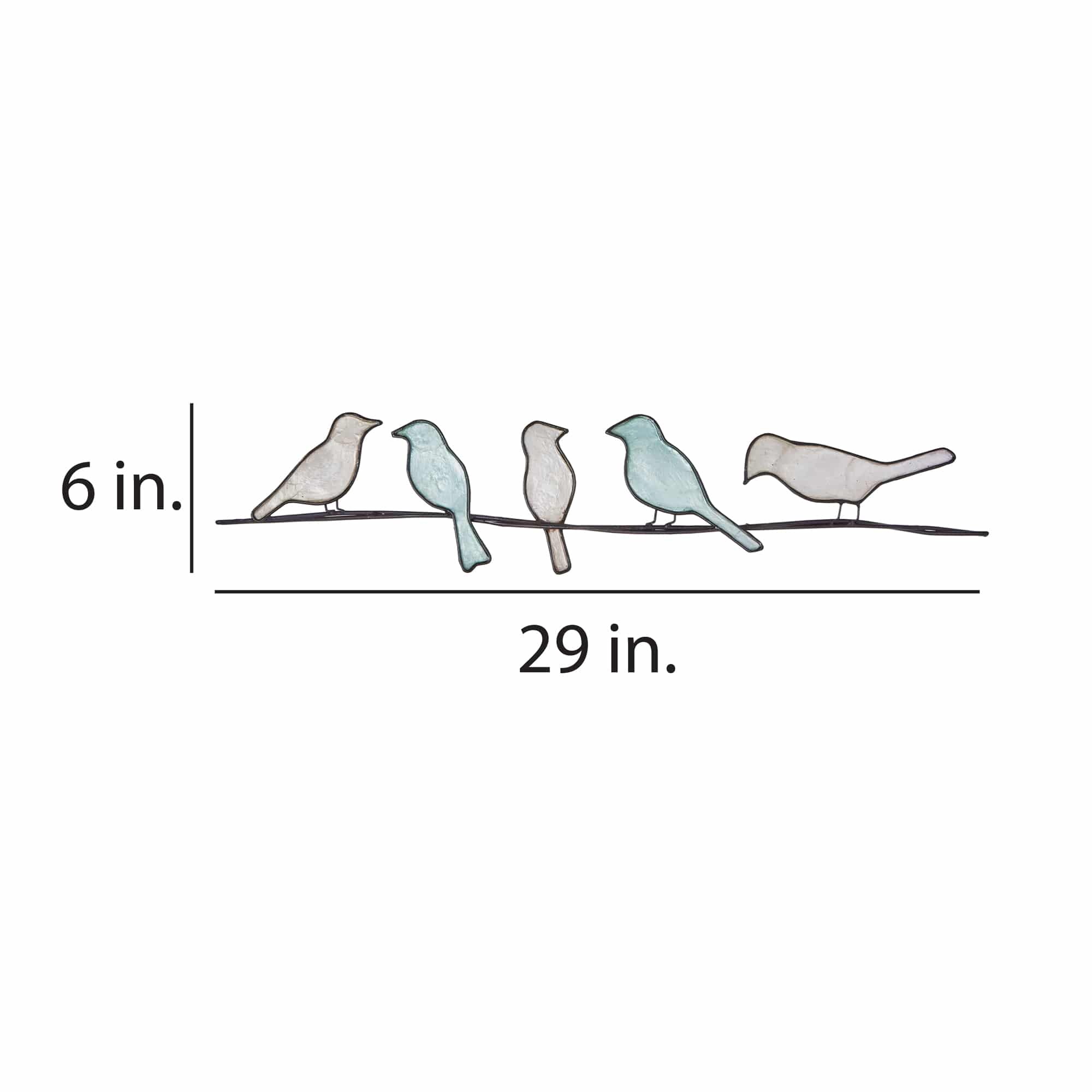
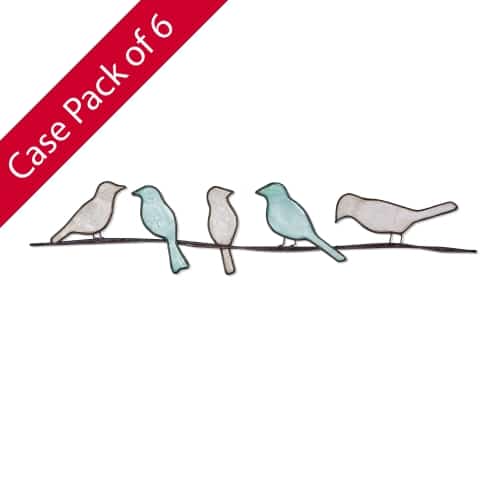 Case of 6 An old parable states that five birds were resting on a wire. Two decided to fly south. How many were birds are left? One's initial answer may be three, however, the answer is still five. The moral of the fable is actions are more important than intention; a kind reminder that a truer picture of one's character is drawn by actions. The artisan captures this parable by lining up five birds socializing on a wire. The basic frame of this piece is created using tin, which is powder coated with a black finish. The frame is reinforced using tin wire along the inner edge. The front of the body is adorned with capiz. Capiz is an oyster shell and the primary purpose of the oyster is as a source of food. However, the by-product, the shell, can be used for decoration. Due to it being a natural material, the natural colors of the capiz may come through as tans and browns underneath the hand-painted surface.
Case of 6 An old parable states that five birds were resting on a wire. Two decided to fly south. How many were birds are left? One's initial answer may be three, however, the answer is still five. The moral of the fable is actions are more important than intention; a kind reminder that a truer picture of one's character is drawn by actions. The artisan captures this parable by lining up five birds socializing on a wire. The basic frame of this piece is created using tin, which is powder coated with a black finish. The frame is reinforced using tin wire along the inner edge. The front of the body is adorned with capiz. Capiz is an oyster shell and the primary purpose of the oyster is as a source of food. However, the by-product, the shell, can be used for decoration. Due to it being a natural material, the natural colors of the capiz may come through as tans and browns underneath the hand-painted surface. -
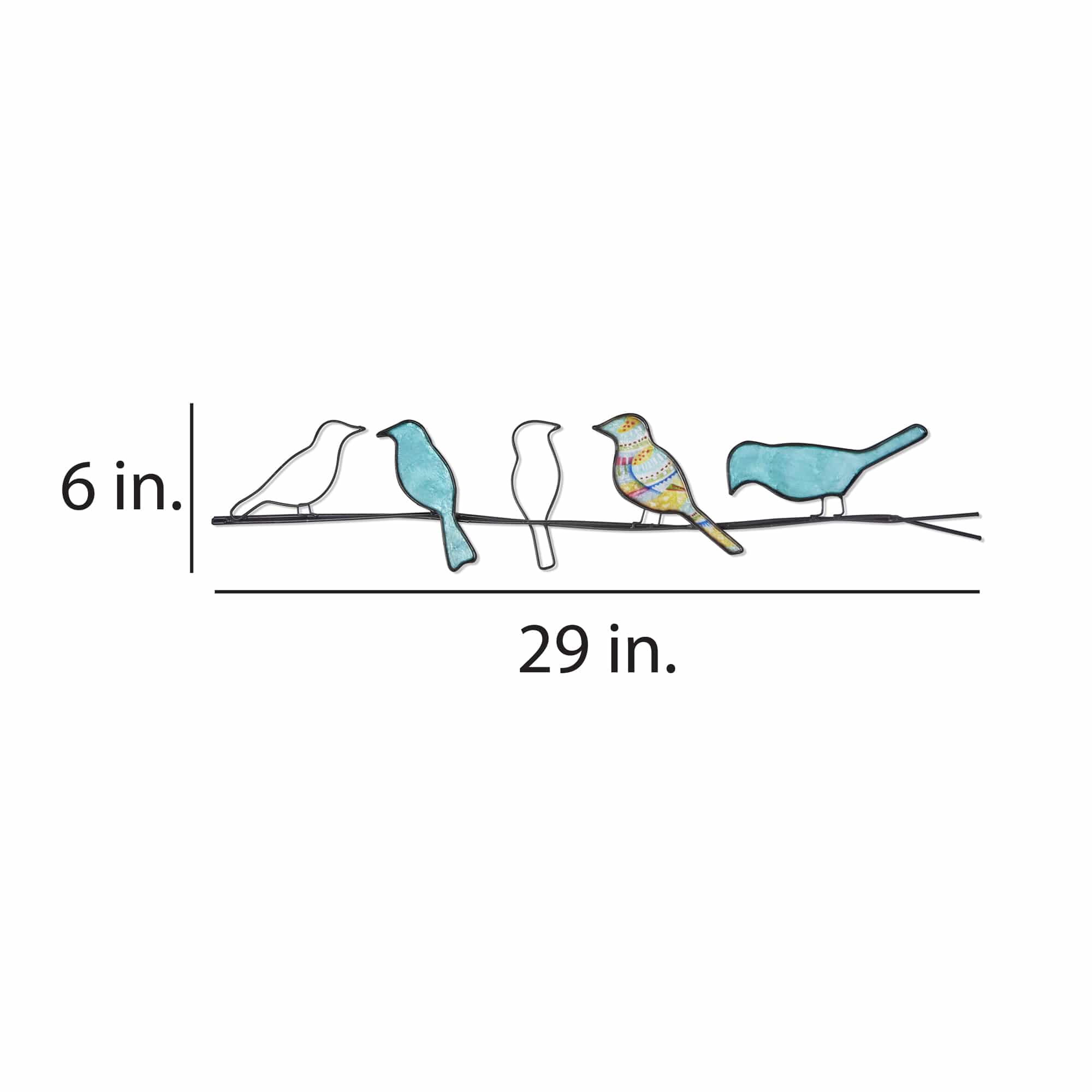
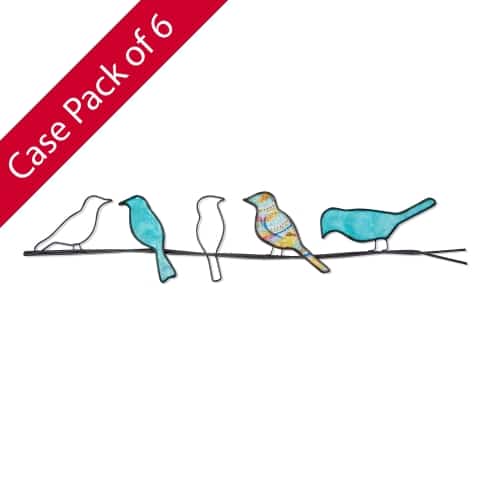 Case of 6 An old parable states that five birds were resting on a wire. Two decided to fly south. How many were birds are left? One's initial answer may be three, however, the answer is still five. The moral of the fable is actions are more important than intention; a kind reminder that a truer picture of one's character is drawn by actions. The artisan captures this parable by lining up five birds socializing on a wire. The basic frame of this piece is created using tin, which is powder coated with a black finish. The frame is reinforced using tin wire along the inner edge. The front of the body is adorned with capiz. Capiz is an oyster shell and the primary purpose of the oyster is as a source of food. However, the by-product, the shell, can be used for decoration. Due to it being a natural material, the natural colors of the capiz may come through as tans and browns underneath the hand-painted surface.
Case of 6 An old parable states that five birds were resting on a wire. Two decided to fly south. How many were birds are left? One's initial answer may be three, however, the answer is still five. The moral of the fable is actions are more important than intention; a kind reminder that a truer picture of one's character is drawn by actions. The artisan captures this parable by lining up five birds socializing on a wire. The basic frame of this piece is created using tin, which is powder coated with a black finish. The frame is reinforced using tin wire along the inner edge. The front of the body is adorned with capiz. Capiz is an oyster shell and the primary purpose of the oyster is as a source of food. However, the by-product, the shell, can be used for decoration. Due to it being a natural material, the natural colors of the capiz may come through as tans and browns underneath the hand-painted surface. -
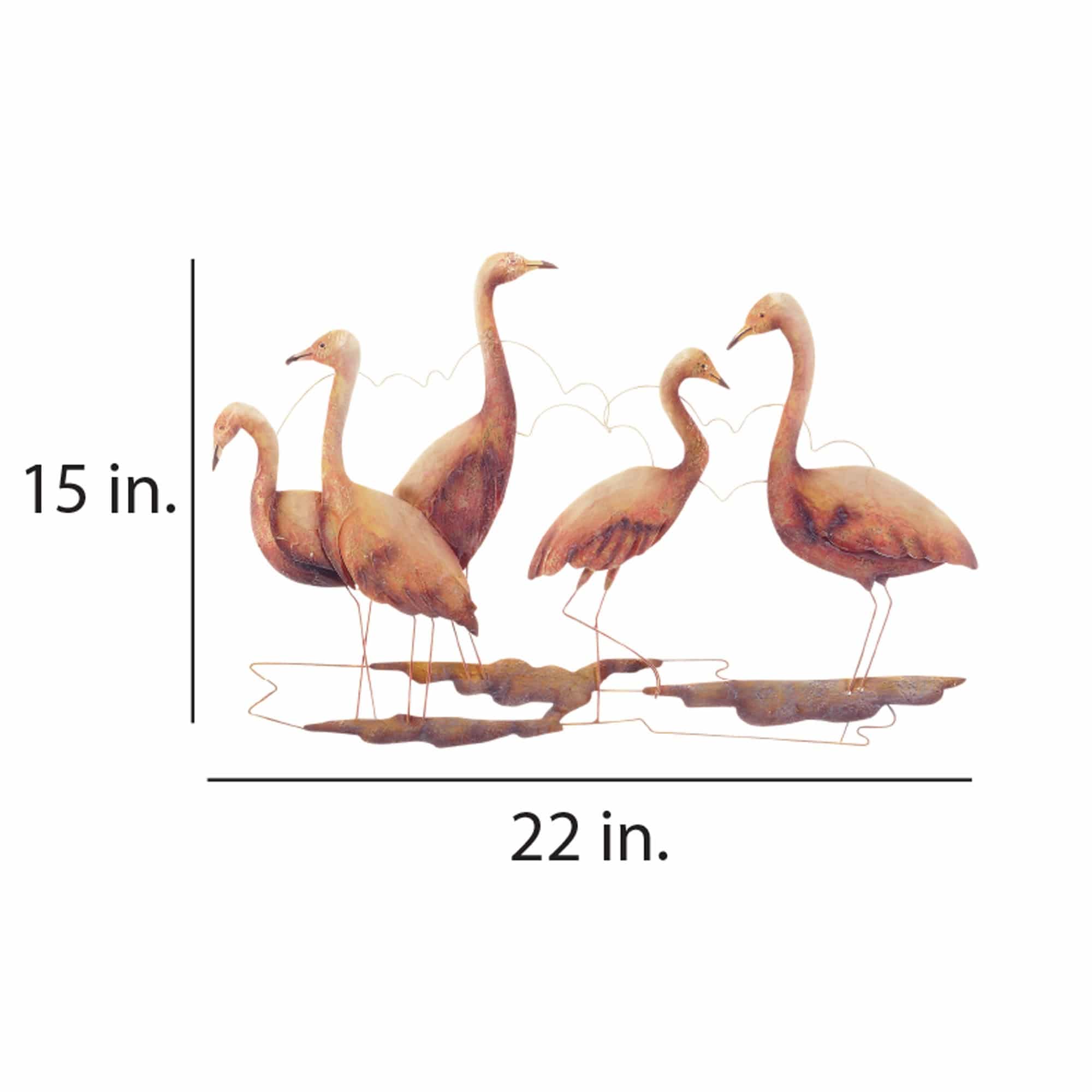
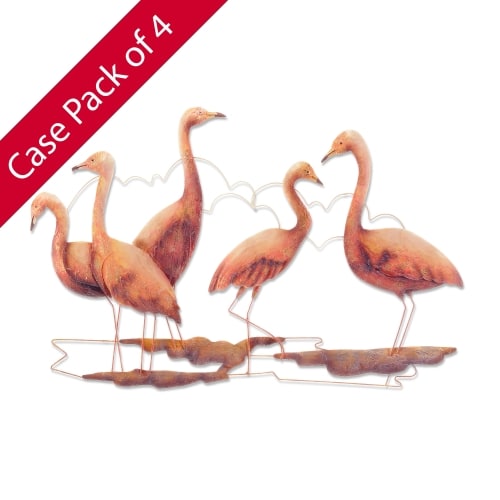 Case of 4 The name 'flamingo' comes from the Portuguese or Spanish 'flamengo,' which means 'flame-colored.' Born gray in hues, flamingos get their flamboyant color from brine shrimp that make up most of their diet. Flamingos are very social animals and the artist depicts this by creating a group of five birds wading through the calm water enjoying a warm day. The artist takes time in pressing the metal creating texture in the wings and body, and also uses metallic paints to highlight the famous colors of one of the most recognizable birds on the planet. The basic frame of this piece is created using tin, which is powder coated with a black finish. The frame is reinforced using tin wire along the inner edge. The front of the body is adorned with capiz. Capiz is an oyster shell and the primary purpose of the oyster is as a source of food. However, the by-product, the shell, can be used for decoration. Due to it being a natural material, the natural colors of the capiz may come through as tans and browns underneath the hand-painted surface.
Case of 4 The name 'flamingo' comes from the Portuguese or Spanish 'flamengo,' which means 'flame-colored.' Born gray in hues, flamingos get their flamboyant color from brine shrimp that make up most of their diet. Flamingos are very social animals and the artist depicts this by creating a group of five birds wading through the calm water enjoying a warm day. The artist takes time in pressing the metal creating texture in the wings and body, and also uses metallic paints to highlight the famous colors of one of the most recognizable birds on the planet. The basic frame of this piece is created using tin, which is powder coated with a black finish. The frame is reinforced using tin wire along the inner edge. The front of the body is adorned with capiz. Capiz is an oyster shell and the primary purpose of the oyster is as a source of food. However, the by-product, the shell, can be used for decoration. Due to it being a natural material, the natural colors of the capiz may come through as tans and browns underneath the hand-painted surface. -
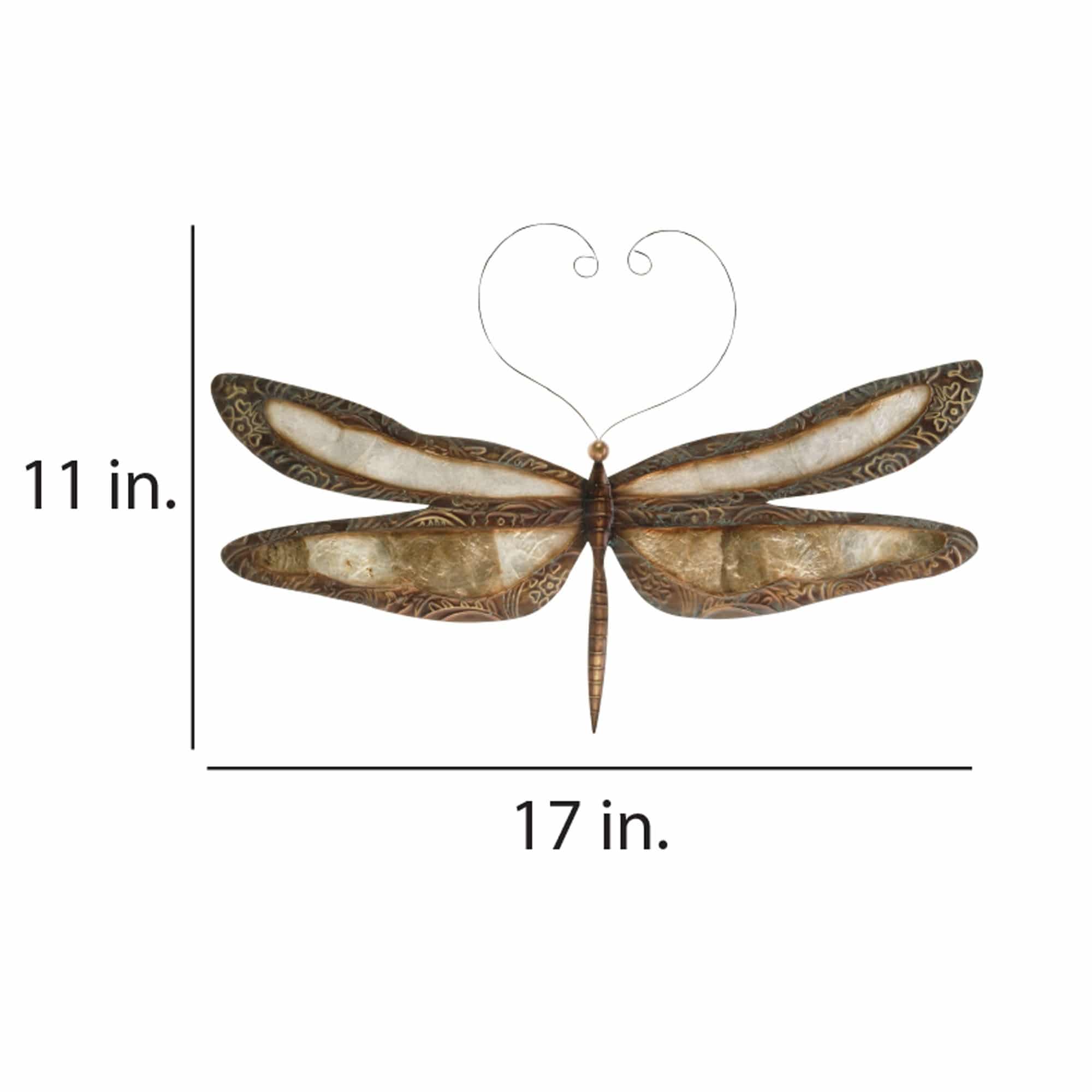
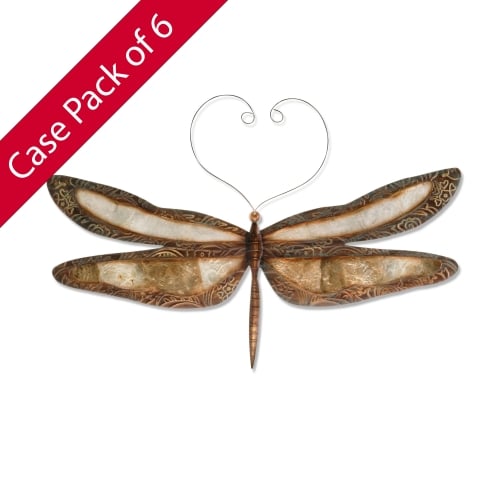 Case of 6
Case of 6The center of this dragonfly's wings is comprised of mother of pearl oyster shells. Each individual shell is emphasized by the different hues of the natural shell. Bordering the outer edge of the shells is tin, hand-painted, with a weathered copper finish. Though very different materials, both the metal and the shell complement each other and will enhance any space.
The basic frame of the dragonfly is created using tin, which is powder-coated with a black finish and makes this piece safe to use outdoors. The edges of the frame are reinforced using thicker tin wire. The front of this piece is adorned in areas with capiz shell, an oyster native to the Philippines, before being hand-painted and sealed with a water-based sealant. The primary purpose of this oyster to provide a source of food, however, the shell is a sustainable by-product that can be used for decoration. The capiz shell subtly replicates the reflective qualities of dragonflies in nature. The entire piece is lightweight and has an eyelet in the back allowing it to be hung using a finishing nail, command strip, or a push pin. Due to it being a natural material, the organic colors of capiz come through as tans and browns underneath the paint.
-
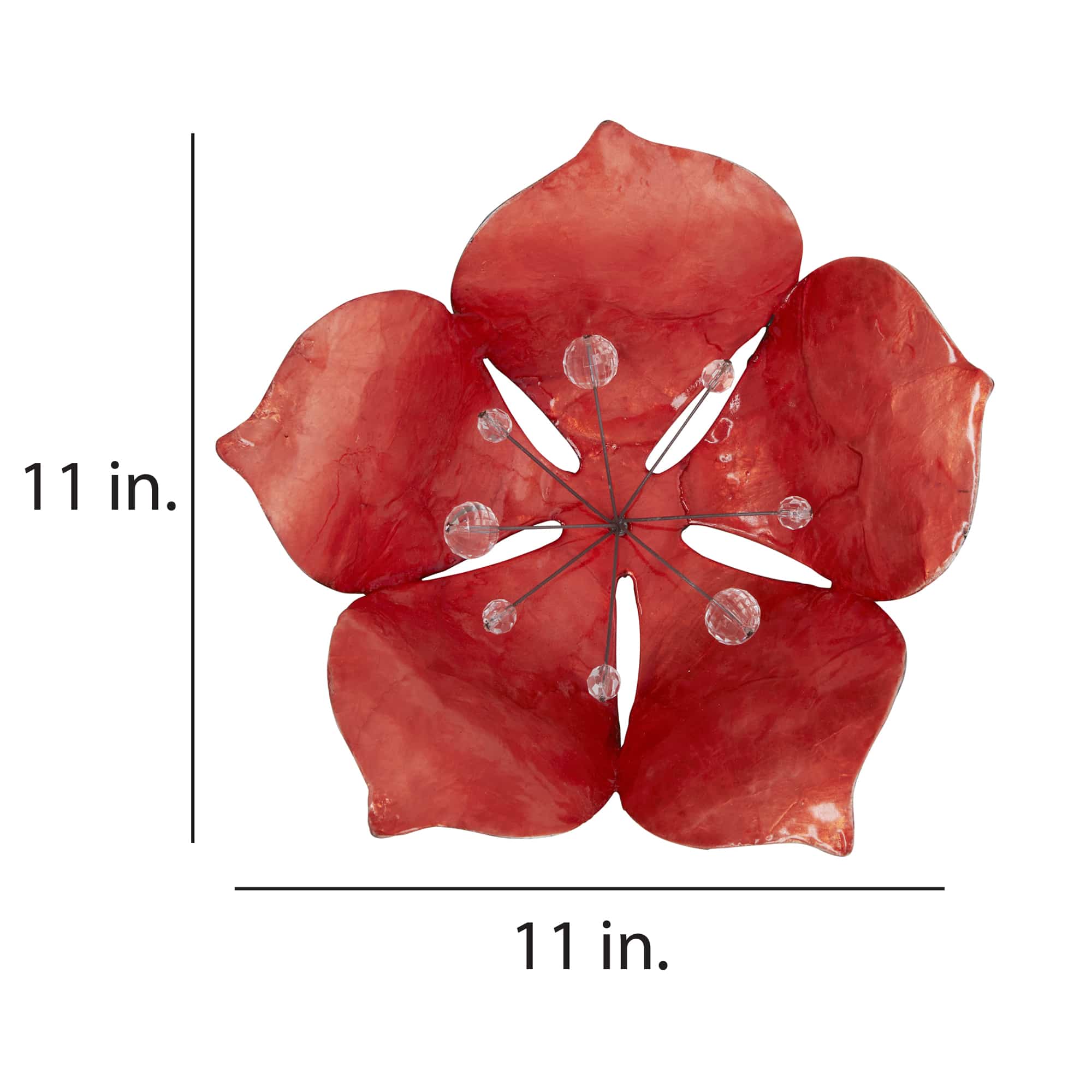
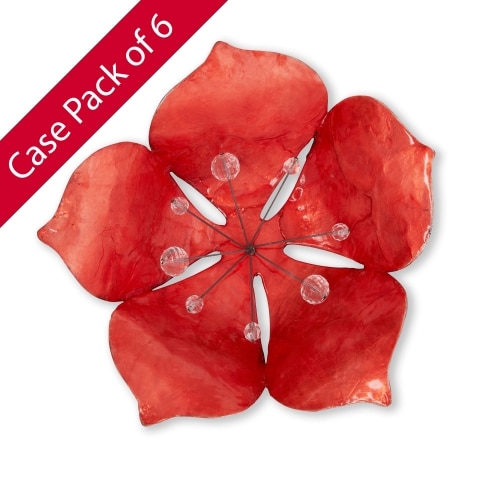 Case of 6 Bold and colorful, these wall flowers can set by themselves or in a group. The mix of materials such as capiz shell and wrought iron enhances the primary color of the flower by creating shading and shadows. But the artisans took another step by shaping a wrought iron frame into the basic shape of a lily opening itself to the sky. The basic frame of the wall flower is created using tin, which is powder coated as a black finish. The frame is reinforced using wrought iron wire along the inner edge. Capiz is an oyster shell and the primary purpose of the oyster is as a source of food. However, the by-product, the shell, can be used for decoration. Due to it being a natural material, the natural colors of the capiz can come through as tans and browns underneath the paint. The shell is then painted the bold colors you see. Finally, the piece is adorned with translucent balls attached using a wrought iron wire.
Case of 6 Bold and colorful, these wall flowers can set by themselves or in a group. The mix of materials such as capiz shell and wrought iron enhances the primary color of the flower by creating shading and shadows. But the artisans took another step by shaping a wrought iron frame into the basic shape of a lily opening itself to the sky. The basic frame of the wall flower is created using tin, which is powder coated as a black finish. The frame is reinforced using wrought iron wire along the inner edge. Capiz is an oyster shell and the primary purpose of the oyster is as a source of food. However, the by-product, the shell, can be used for decoration. Due to it being a natural material, the natural colors of the capiz can come through as tans and browns underneath the paint. The shell is then painted the bold colors you see. Finally, the piece is adorned with translucent balls attached using a wrought iron wire. -
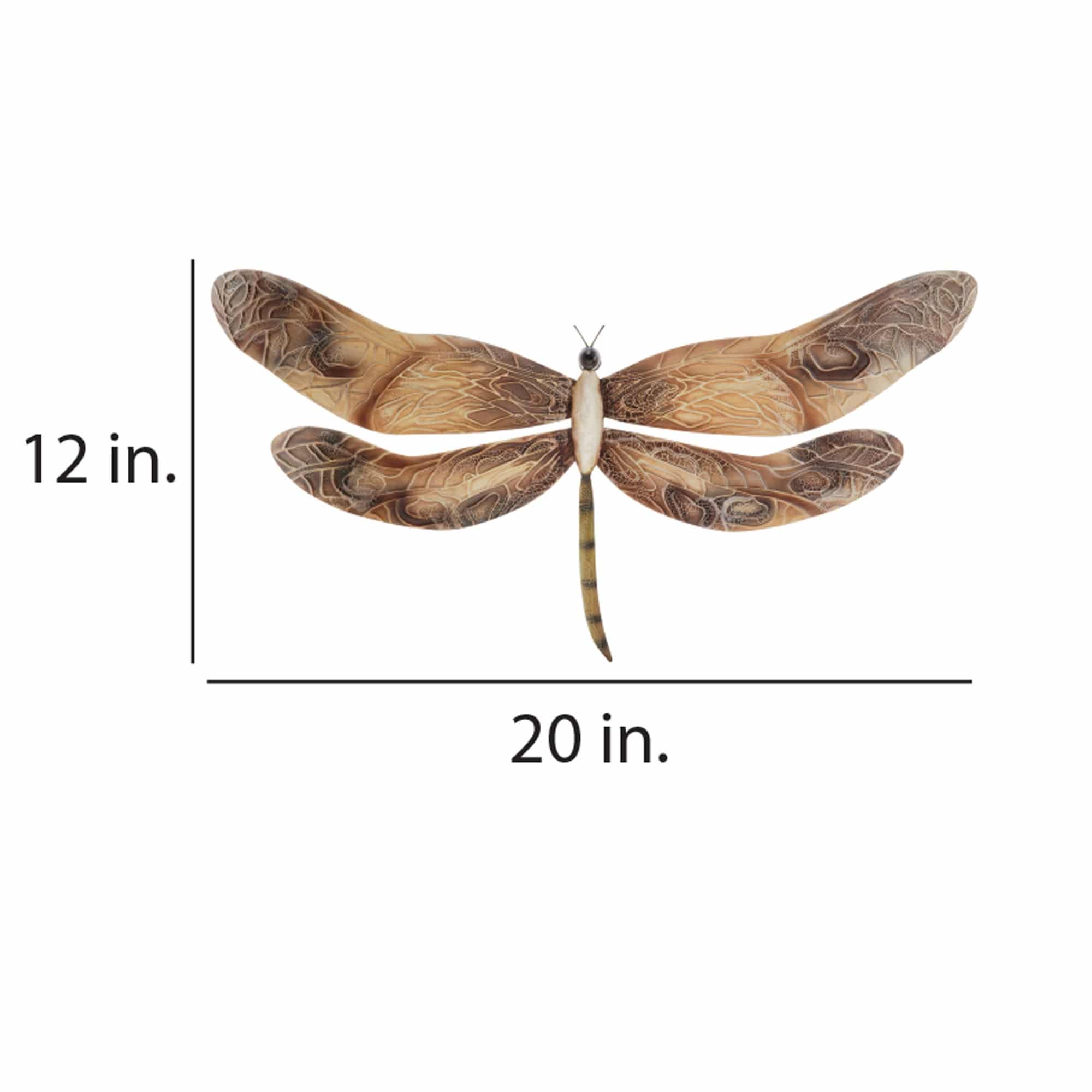
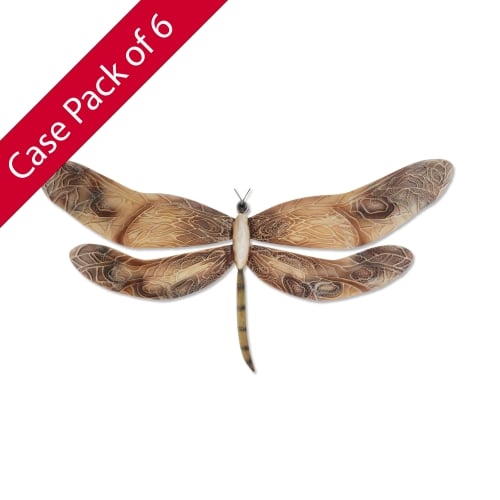 Case of 6
Case of 6Earthy in its brown winged form, this neutral piece is striking in its texture and contrasted pearl body. This dragonfly brings elegance and flair with its natural form. Perfect for all styles of decor, it will create the finishing touch to any space.
The basic frame of the dragonfly is created using tin, which is powder-coated with a black finish and makes this piece safe to use outdoors. The edges of the frame are reinforced using thicker tin wire. The front of this piece is adorned in areas with capiz shell, an oyster native to the Philippines, before being hand-painted and sealed with a water-based sealant. The primary purpose of this oyster to provide a source of food, however, the shell is a sustainable by-product that can be used for decoration. The capiz shell subtly replicates the reflective qualities of dragonflies in nature. The entire piece is lightweight and has an eyelet in the back allowing it to be hung using a finishing nail, command strip, or a push pin. Due to it being a natural material, the organic colors of capiz come through as tans and browns underneath the paint.
-
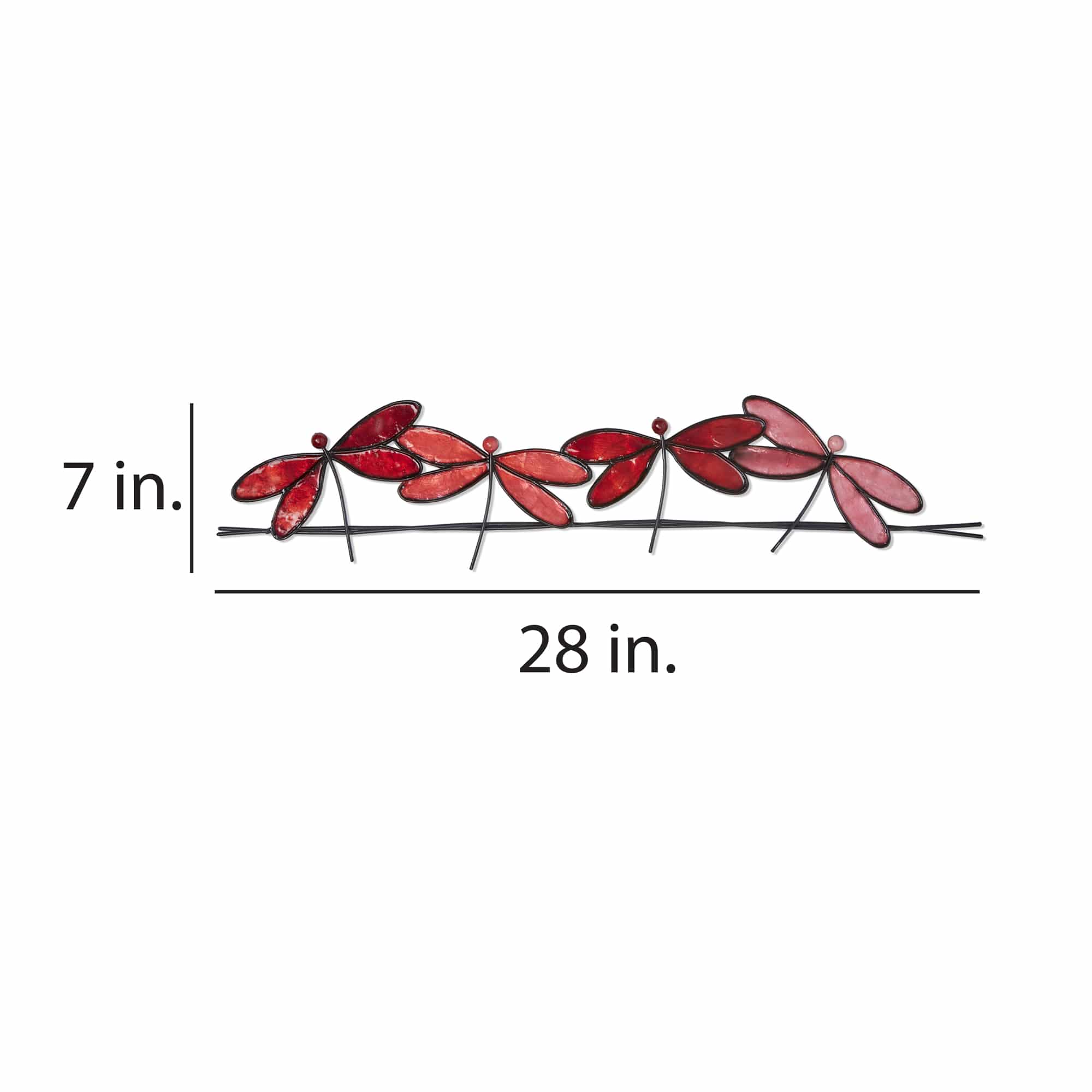
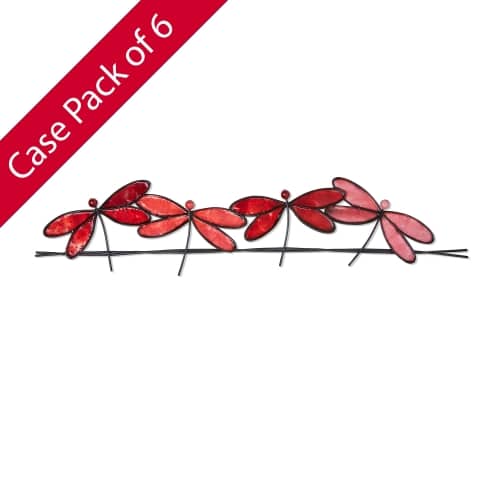 Case of 6 Four dragonflies are taking a mid-day break from fluttering and their characteristically unpredictable flight patterns around the lake. The slender, metal body of each dragonfly connects to colorful, capiz-shell wings, which catches light and adds shine. Each wing is framed using sturdy wrought iron and reinforced with a metal backing. The basic frame of the dragonfly is created using tin, which is powder-coated with a black finish and makes this piece safe to use outdoors. The edges of the frame are reinforced using thicker tin wire. The front of this piece is adorned in areas with capiz shell, an oyster native to the Philippines, before being hand-painted and sealed with a water-based sealant. The primary purpose of this oyster to provide a source of food, however, the shell is a sustainable by-product that can be used for decoration. The capiz shell subtly replicates the reflective qualities of dragonflies in nature. The entire piece is lightweight and has an eyelet in the back allowing it to be hung using a finishing nail, command strip, or a push pin. Due to it being a natural material, the organic colors of capiz come through as tans and browns underneath the paint.
Case of 6 Four dragonflies are taking a mid-day break from fluttering and their characteristically unpredictable flight patterns around the lake. The slender, metal body of each dragonfly connects to colorful, capiz-shell wings, which catches light and adds shine. Each wing is framed using sturdy wrought iron and reinforced with a metal backing. The basic frame of the dragonfly is created using tin, which is powder-coated with a black finish and makes this piece safe to use outdoors. The edges of the frame are reinforced using thicker tin wire. The front of this piece is adorned in areas with capiz shell, an oyster native to the Philippines, before being hand-painted and sealed with a water-based sealant. The primary purpose of this oyster to provide a source of food, however, the shell is a sustainable by-product that can be used for decoration. The capiz shell subtly replicates the reflective qualities of dragonflies in nature. The entire piece is lightweight and has an eyelet in the back allowing it to be hung using a finishing nail, command strip, or a push pin. Due to it being a natural material, the organic colors of capiz come through as tans and browns underneath the paint. -
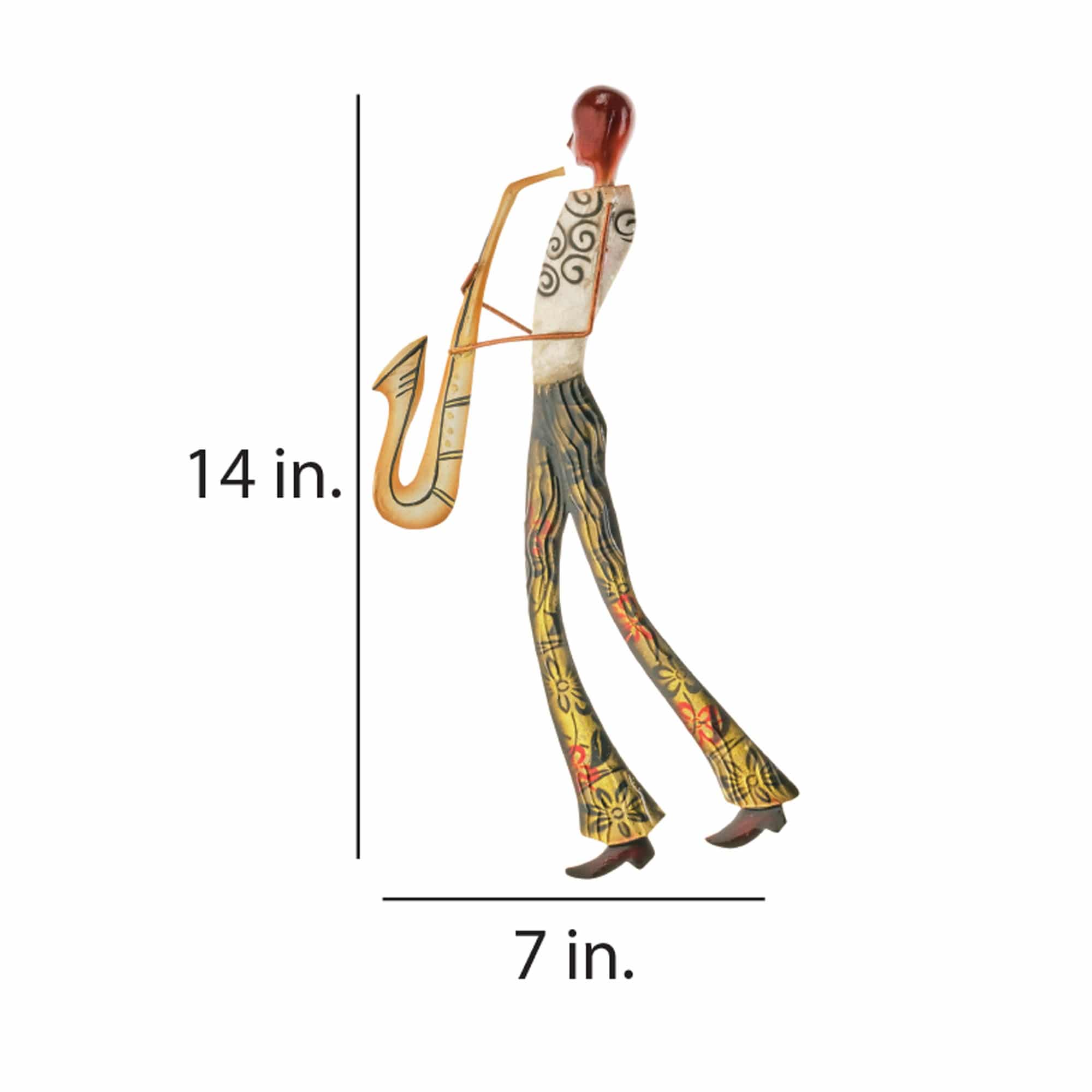
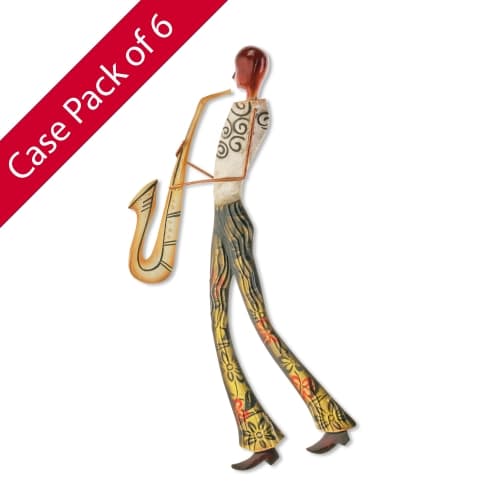 Case of 6 Jazz inspires the artisan's interpretation of the sax player. Jazz is considered music of the soul due to the deep emotion that runs to the roots of this important American movement. It can be used as a journey to happy times or a reflection of struggles. This particular guitarist, with the colorful finishes, the influence is definitely in a mood of celebration. The festive shirt of the player is adorned with capiz shell, giving it a shimmer as it reflects light. The frame of the Sax Player Wall Decor is created using tin, which is powder coated as a black finish. The frame is reinforced using wrought iron wire inner and outer edges. Capiz is an oyster shell and the primary purpose of the oyster is as a source of food. However, the by-product, the shell, can be used for decoration. Due to it being a natural material, the natural colors of the capiz can come through as tans and browns underneath the paint.
Case of 6 Jazz inspires the artisan's interpretation of the sax player. Jazz is considered music of the soul due to the deep emotion that runs to the roots of this important American movement. It can be used as a journey to happy times or a reflection of struggles. This particular guitarist, with the colorful finishes, the influence is definitely in a mood of celebration. The festive shirt of the player is adorned with capiz shell, giving it a shimmer as it reflects light. The frame of the Sax Player Wall Decor is created using tin, which is powder coated as a black finish. The frame is reinforced using wrought iron wire inner and outer edges. Capiz is an oyster shell and the primary purpose of the oyster is as a source of food. However, the by-product, the shell, can be used for decoration. Due to it being a natural material, the natural colors of the capiz can come through as tans and browns underneath the paint. -
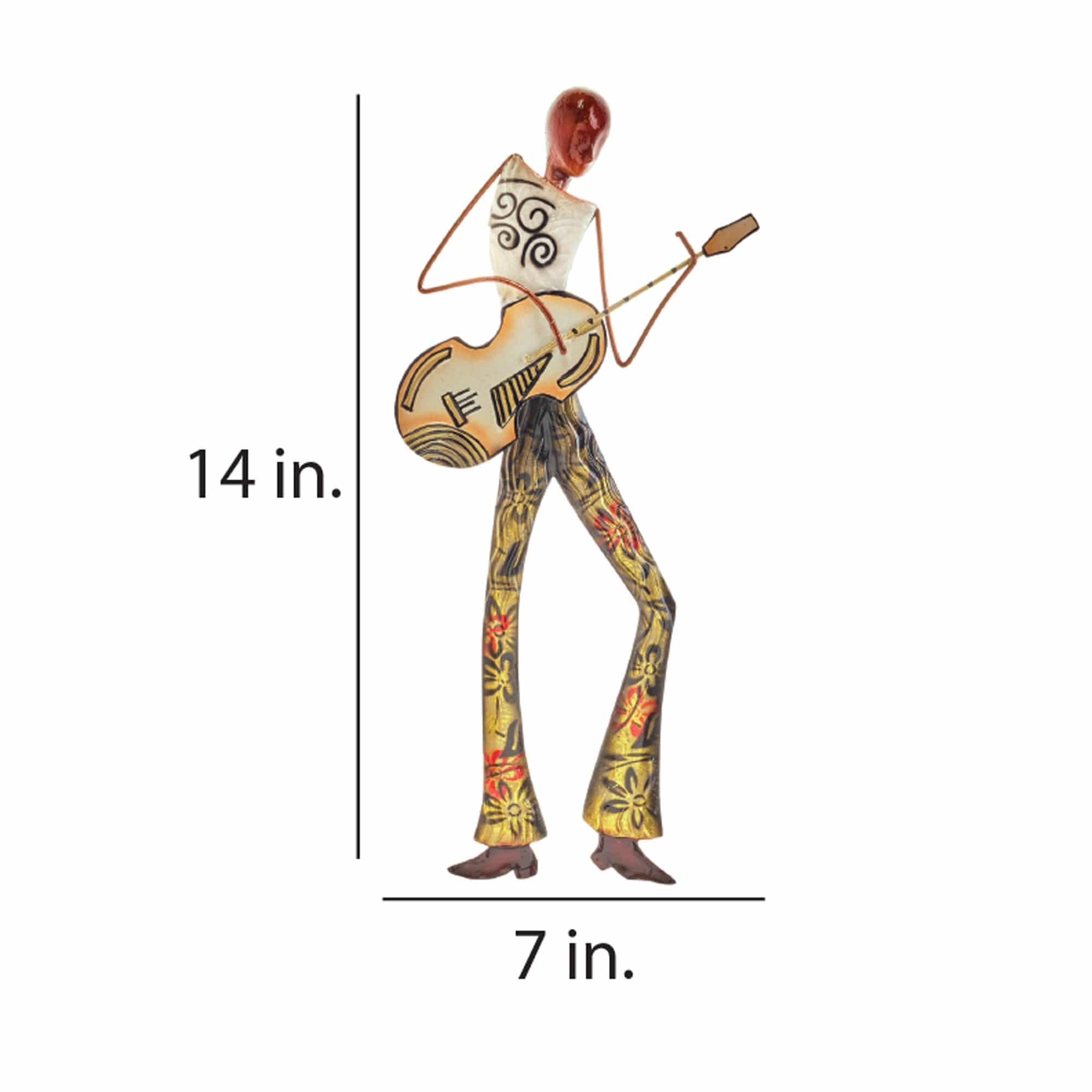
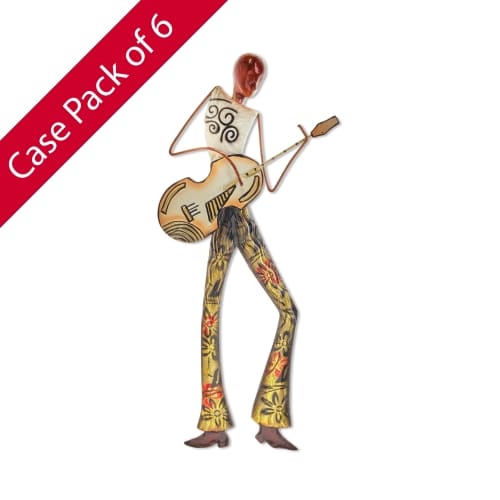 Case of 6
Case of 6Jazz inspires the artisan's interpretation of the guitar player. Jazz is considered music of the soul due to the deep emotion that runs to the roots of this important American movement. It can be used as a journey to happy times or a reflection of struggles. This particular guitarist, with the colorful finishes, the influence is definitely in a mood of celebration. The festive shirt of the player is adorned with capiz shell, giving it a shimmer as it reflects light.
The frame of the Guitar Player Wall Decor is created using tin, which is powder coated in a black finish. The frame is reinforced using wrought iron wire inner and outer edges. Capiz is an oyster shell and the primary purpose of the oyster is as a source of food. However, the by-product, the shell, can be used for decoration. Due to it being a natural material, the natural colors of the capiz can come through as tans and browns underneath the paint.
-
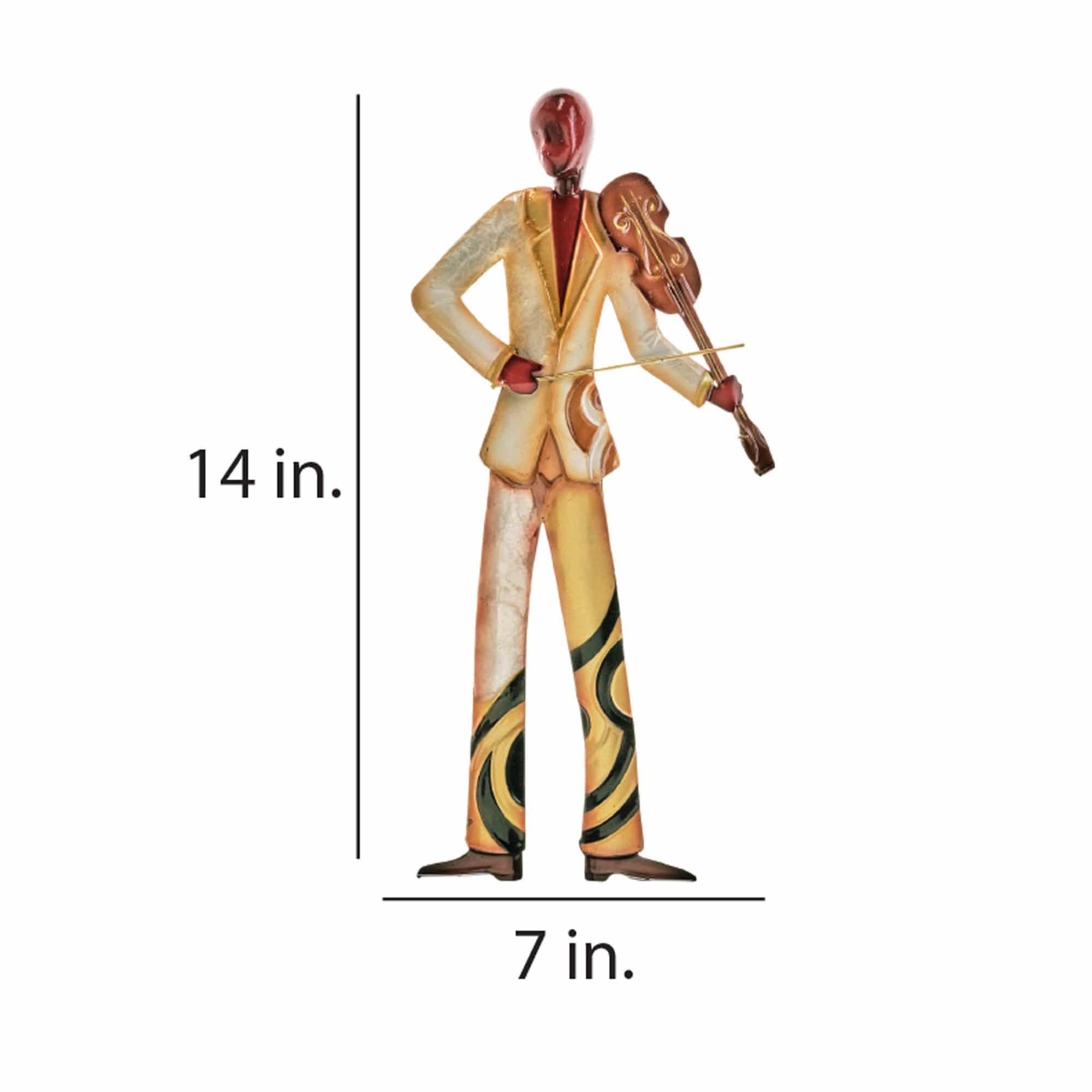
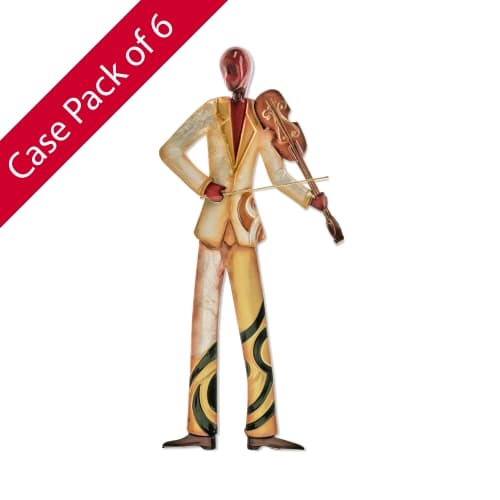 Case of 6
Case of 6The violin transcends time. Used in both formal and festive settings, this instrument is used to convey a journey or to simply get people up to dance. The artisans bring both into one piece of art. The formal wear of the violinist invokes the classics while the color and shading of the clothing represents the festive. The well-dressed violin player is partially adorned with capiz giving it a shimmer as it reflects light, again bringing out the festive side of the instrument.
The frame of the Violin Player Wall Decor is created using tin, which is powder coated in a black finish. The frame is reinforced using wrought iron wire inner edge or outer edge. Capiz is an oyster shell and the primary purpose of the oyster is as a source of food. However, the by-product, the shell, can be used for decoration. Due to it being a natural material, the natural colors of the capiz can come through as tans and browns underneath the paint.
-
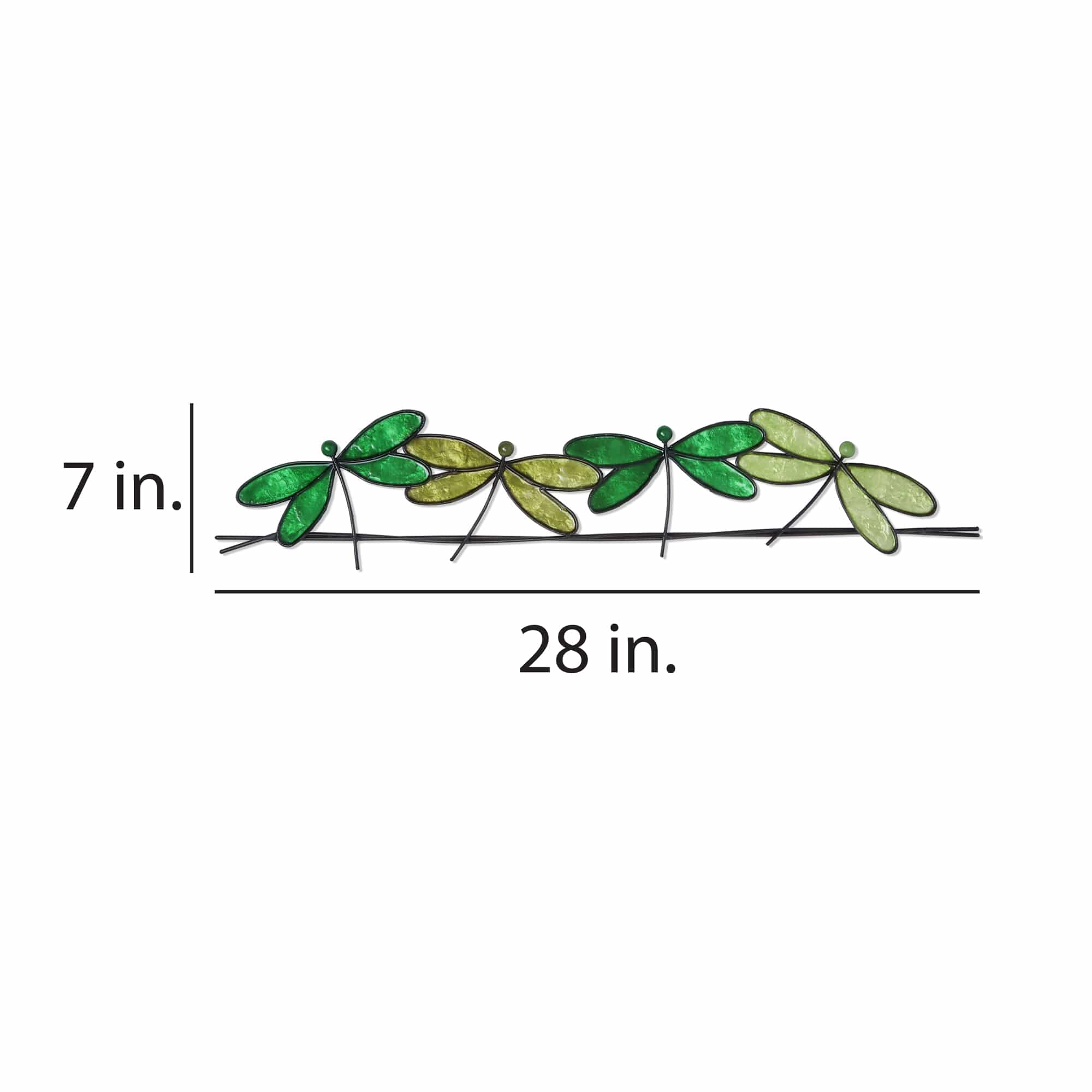
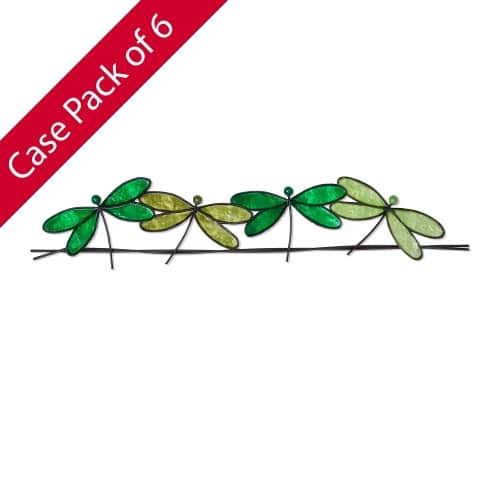 Case of 6
Case of 6Four dragonflies are taking a mid-day break from fluttering and their characteristically unpredictable flight patterns around the lake. The slender, metal body of each dragonfly connects to colorful, capiz-shell wings, which catches light and adds shine. Each wing is framed using sturdy wrought iron and reinforced with a metal backing.
The basic frame of the dragonfly is created using tin, which is powder-coated with a black finish and makes this piece safe to use outdoors. The edges of the frame are reinforced using thicker tin wire. The front of this piece is adorned in areas with capiz shell, an oyster native to the Philippines, before being hand-painted and sealed with a water-based sealant. The primary purpose of this oyster to provide a source of food, however, the shell is a sustainable by-product that can be used for decoration. The capiz shell subtly replicates the reflective qualities of dragonflies in nature. The entire piece is lightweight and has an eyelet in the back allowing it to be hung using a finishing nail, command strip, or a push pin. Due to it being a natural material, the organic colors of capiz come through as tans and browns underneath the paint.
-
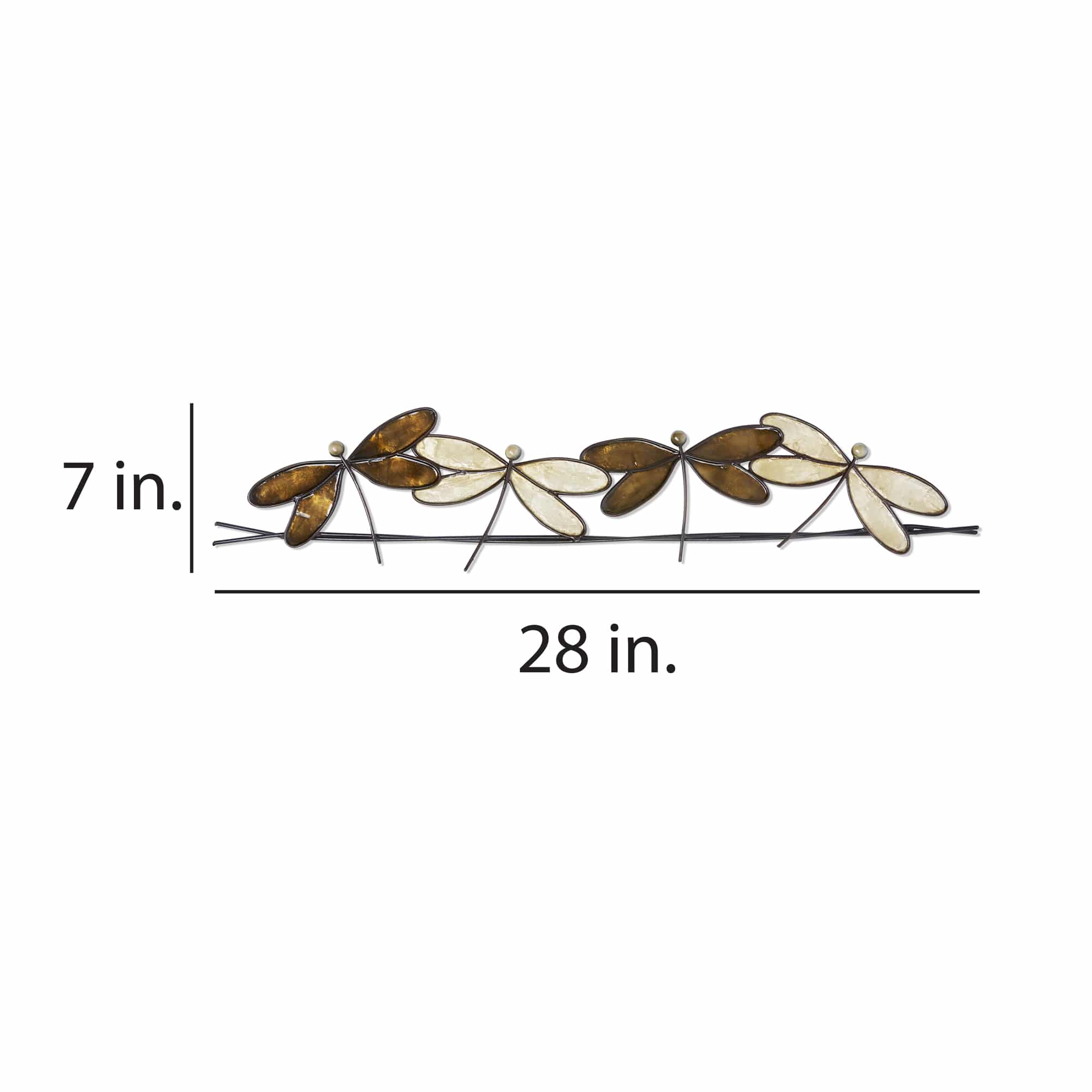
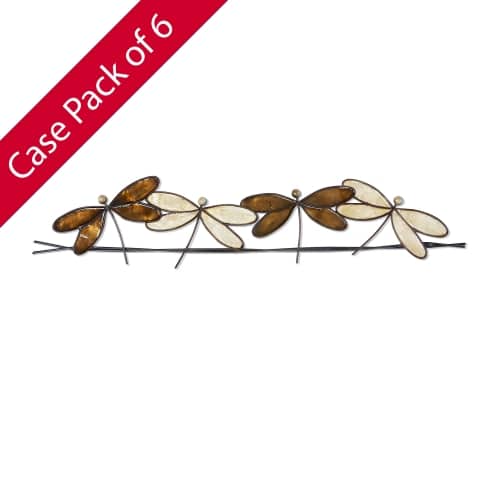 Case of 6
Case of 6Four dragonflies are taking a mid-day break from fluttering and their characteristically unpredictable flight patterns around the lake. The slender, metal body of each dragonfly connects to colorful, capiz-shell wings, which catches light and adds shine. Each wing is framed using sturdy wrought iron and reinforced with a metal backing.
The basic frame of the dragonfly is created using tin, which is powder-coated with a black finish and makes this piece safe to use outdoors. The edges of the frame are reinforced using thicker tin wire. The front of this piece is adorned in areas with capiz shell, an oyster native to the Philippines, before being hand-painted and sealed with a water-based sealant. The primary purpose of this oyster to provide a source of food, however, the shell is a sustainable by-product that can be used for decoration. The capiz shell subtly replicates the reflective qualities of dragonflies in nature. The entire piece is lightweight and has an eyelet in the back allowing it to be hung using a finishing nail, command strip, or a push pin. Due to it being a natural material, the organic colors of capiz come through as tans and browns underneath the paint.
-
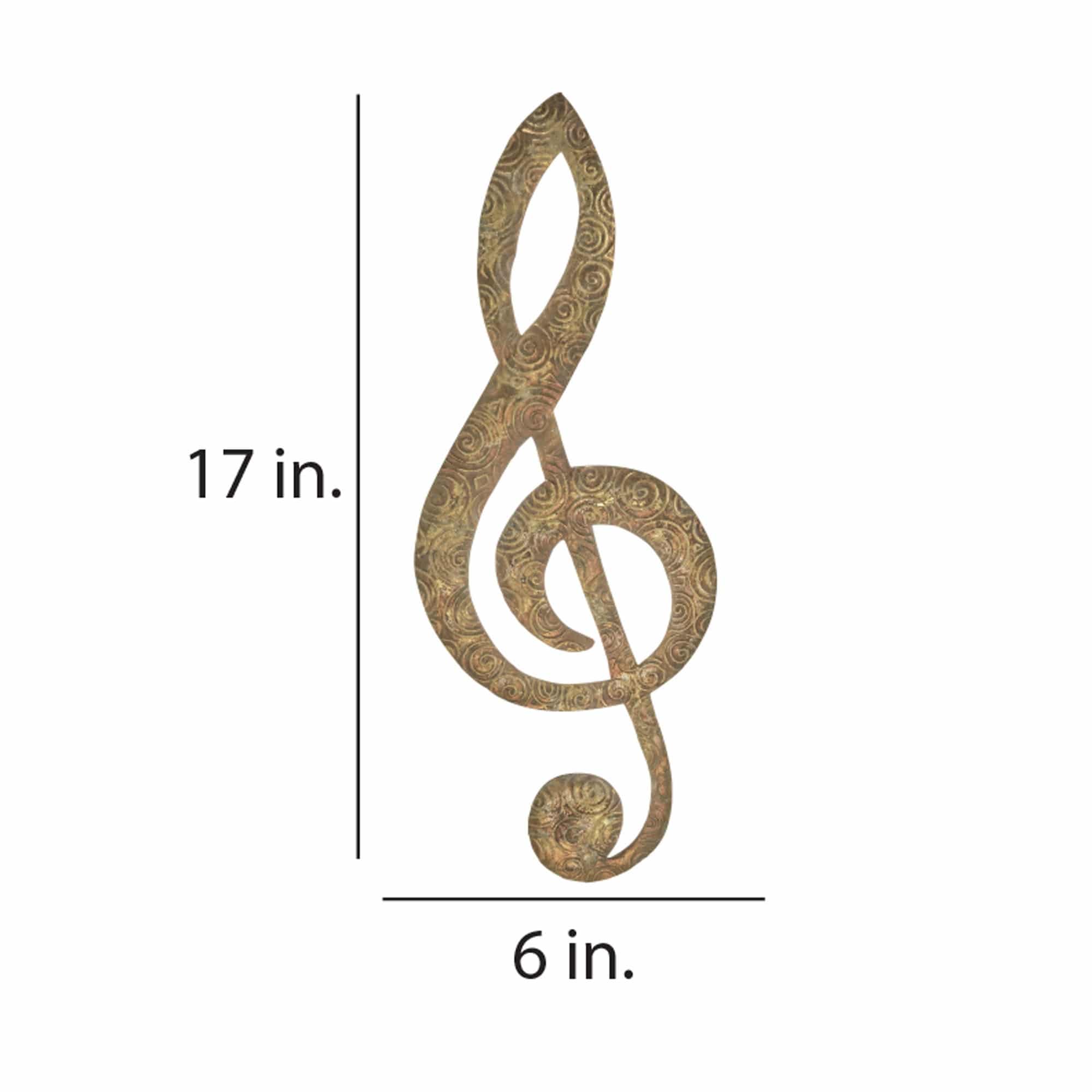
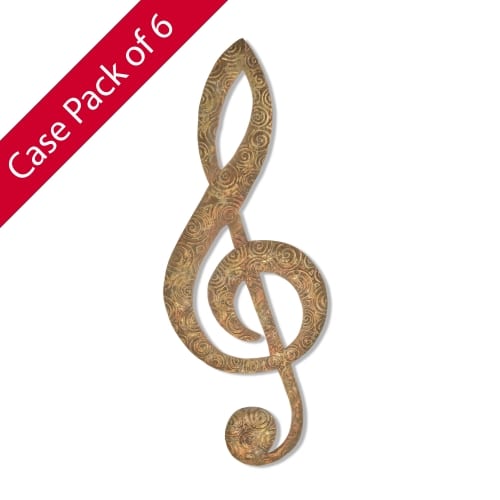 Case of 6 The treble clef is a musical symbol placed on one of the lines at the beginning of the staff. It indicates the name and pitch of the notes on that line. Imprinted into the treble clef are shapes and circles, symbolizing the movement of music. All components come together to give you a great textural piece to symbolize your love of music. The frame of the Music Note Wall Decor is created using tin, which is powder coated in a black finish. The frame is reinforced using wrought iron wire on the inner and outer edges. The copper paint is worked over to give it an aged and oxidized look.
Case of 6 The treble clef is a musical symbol placed on one of the lines at the beginning of the staff. It indicates the name and pitch of the notes on that line. Imprinted into the treble clef are shapes and circles, symbolizing the movement of music. All components come together to give you a great textural piece to symbolize your love of music. The frame of the Music Note Wall Decor is created using tin, which is powder coated in a black finish. The frame is reinforced using wrought iron wire on the inner and outer edges. The copper paint is worked over to give it an aged and oxidized look. -
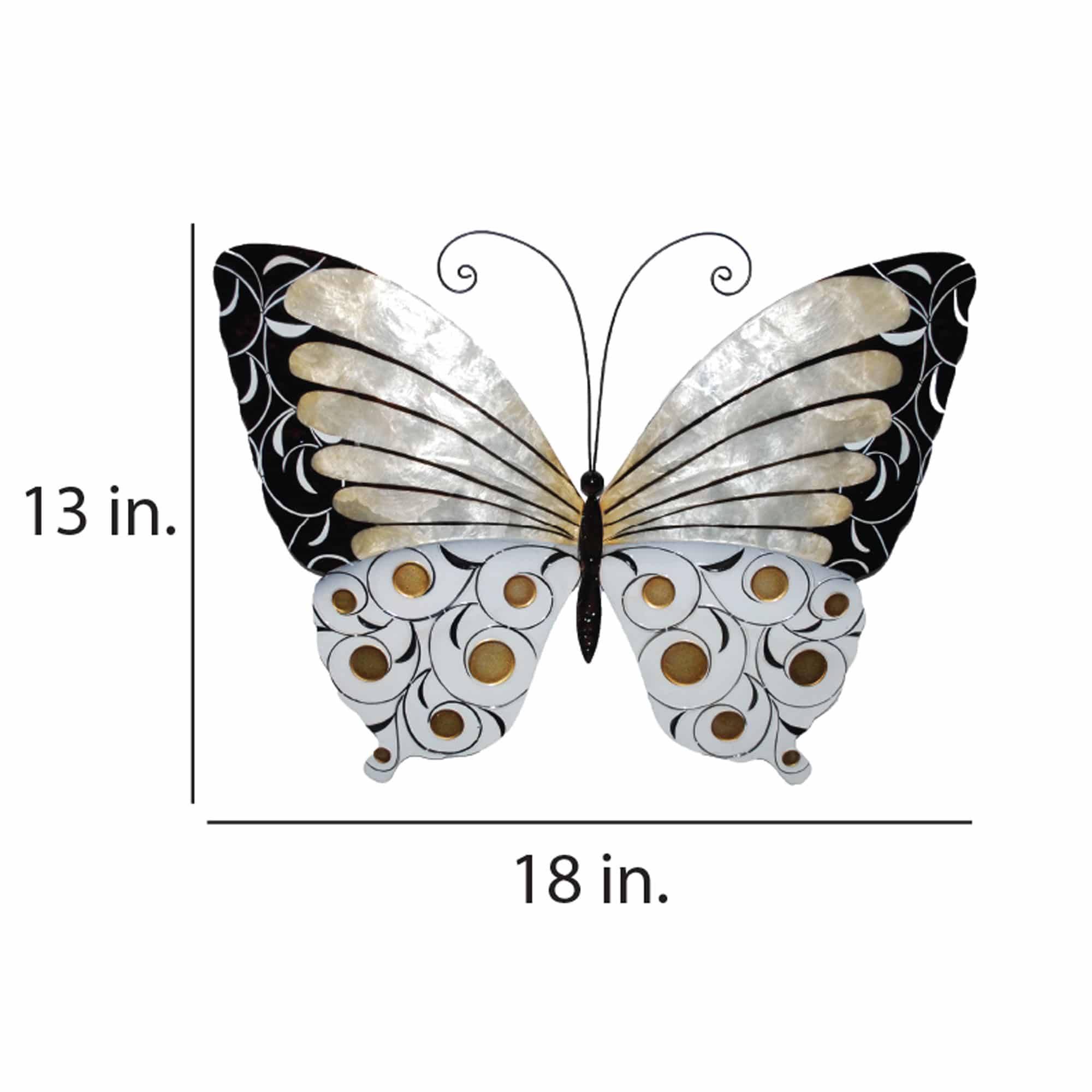
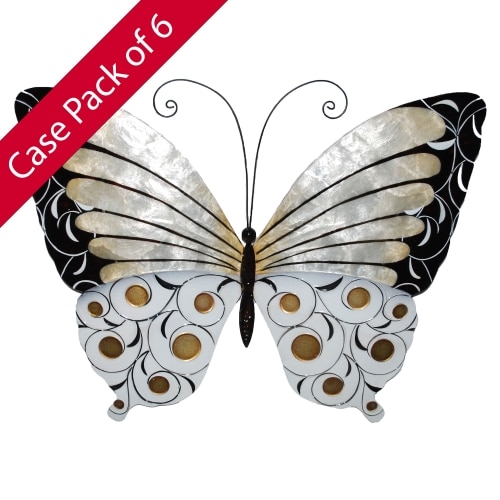 Case of 6
Case of 6Classy and elegant, the artist hand-paints this butterfly in bold black, white, and golds. This contrasting color choice provides a microcosm of a popular retro design, which incorporates, lines, circles, and different combinations of each of the three colors creating beautiful and distinct living spaces.
The basic frame of the butterfly is created using tin, which is powder-coated with a black finish and makes this piece safe to use outdoors. The edges of the frame are reinforced using thicker tin wire. The front of this piece is adorned in areas with capiz shell, an oyster native to the Philippines, before being hand-painted and sealed with a water-based sealant. The primary purpose of this oyster to provide a source of food, however, the shell is a sustainable by-product that can be used for decoration. The capiz shell subtly replicates the reflective qualities of butterflies in nature. The entire piece is lightweight and has an eyelet in the back allowing it to be hung using a finishing nail, command strip, or a push pin. Due to it being a natural material, the organic colors of capiz come through as tans and browns underneath the paint.
-
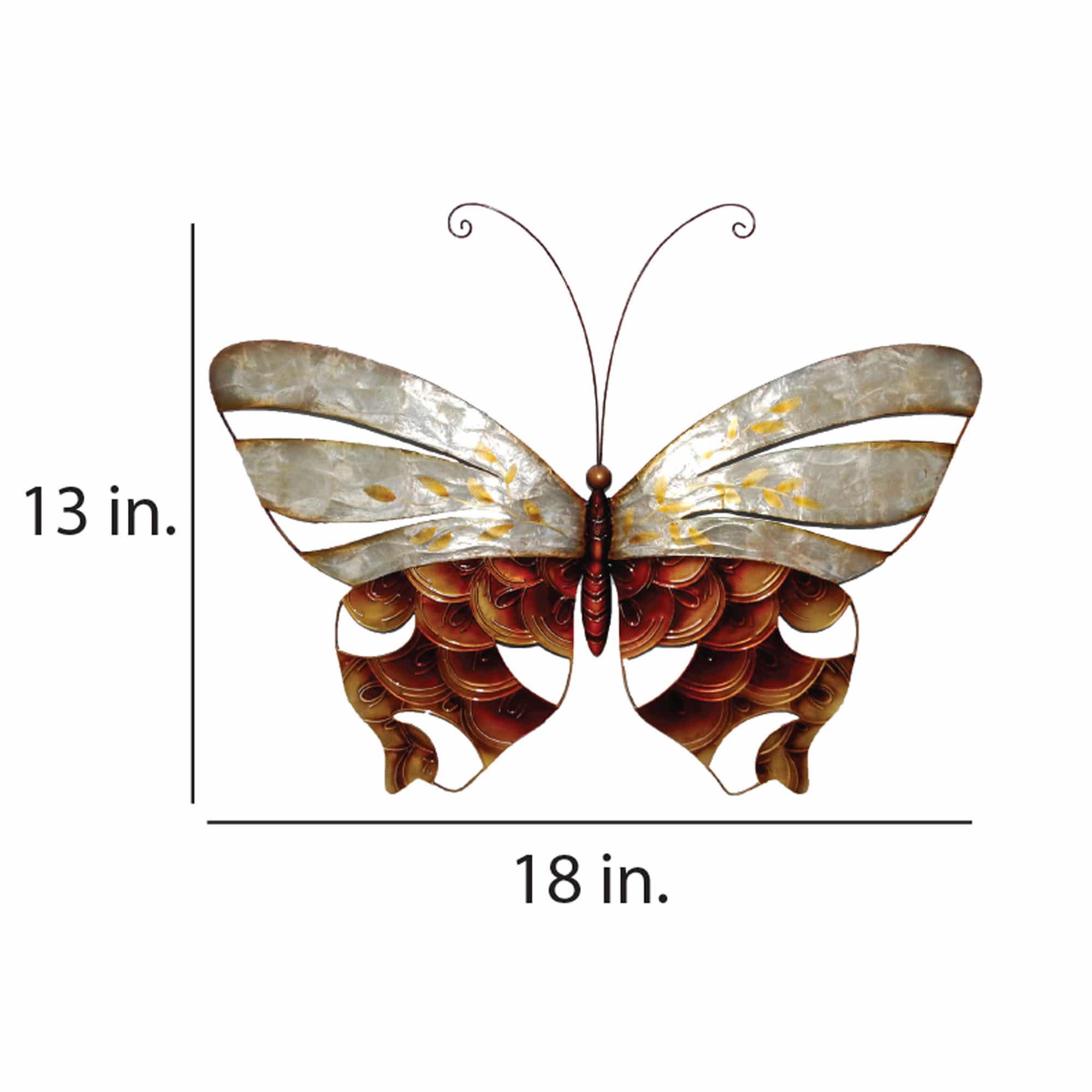
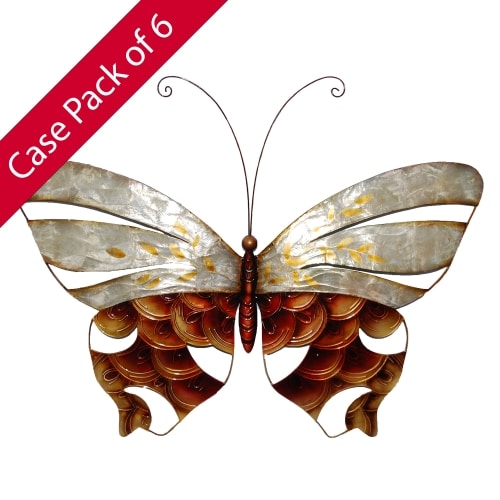 Case of 6
Case of 6With contrasting designs and textures, the artist captures the light and airy spirit of the ever-popular butterfly. Subtle hints of yellow design rest on top of natural capiz shell. Architecturally the arches are used to help support a structure, while creating an open area underneath it. Arches are used around the world and have become a symbol of strength. The lower wings feature a pattern of almost three-dimensional arches, symbolic to the strength a butterfly can represent.
The basic frame of the butterfly is created using tin, which is powder-coated with a black finish and makes this piece safe to use outdoors. The edges of the frame are reinforced using thicker tin wire. The front of this piece is adorned in areas with capiz shell, an oyster native to the Philippines, before being hand-painted and sealed with a water-based sealant. The primary purpose of this oyster to provide a source of food, however, the shell is a sustainable by-product that can be used for decoration. The capiz shell subtly replicates the reflective qualities of butterflies in nature. The entire piece is lightweight and has an eyelet in the back allowing it to be hung using a finishing nail, command strip, or a push pin. Due to it being a natural material, the organic colors of capiz come through as tans and browns underneath the paint.
-
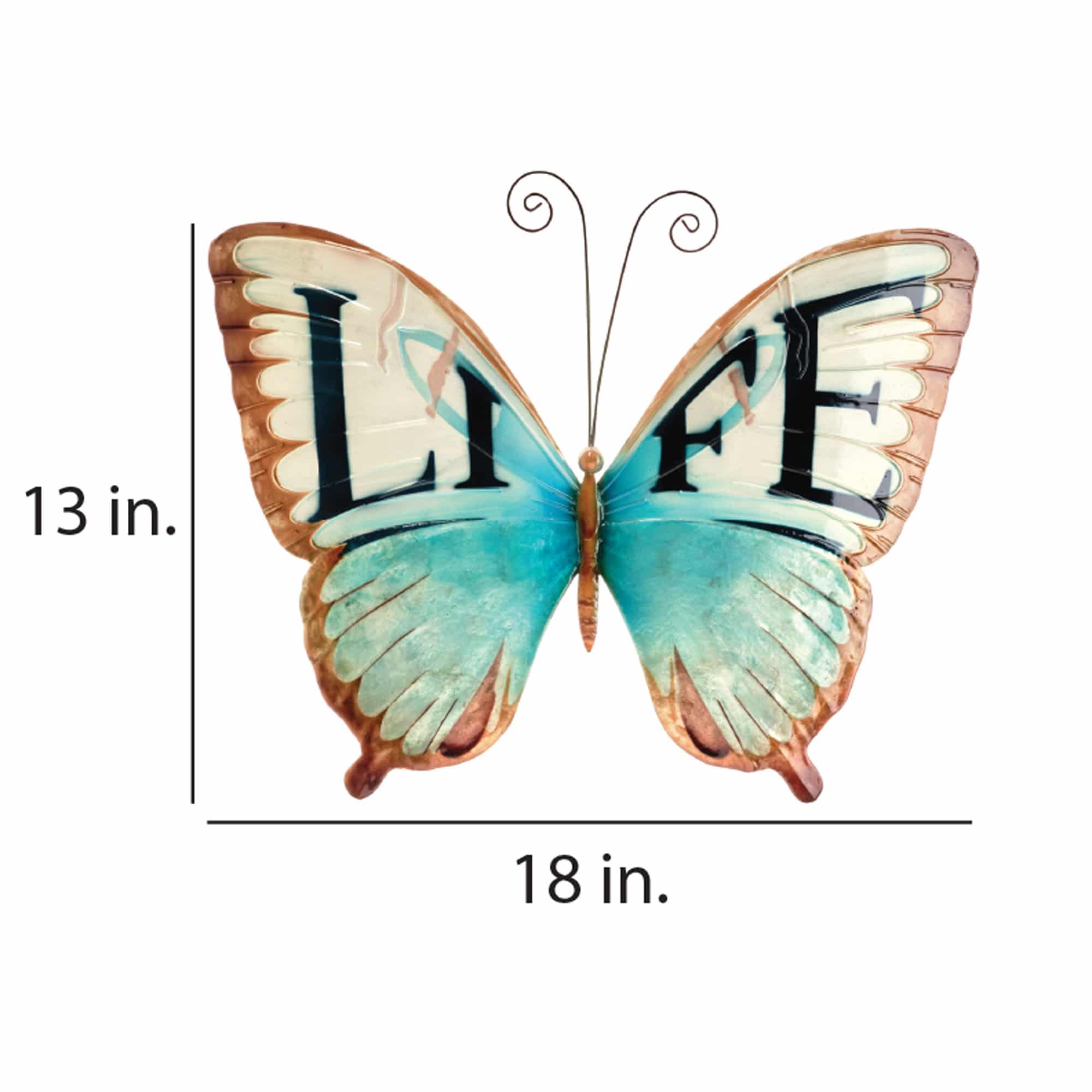
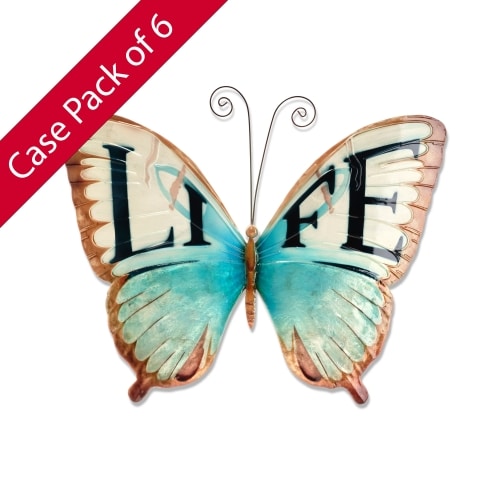 Case of 6
Case of 6Shedding its cocoon, the butterfly is a strong symbol of rebirth, thus the butterfly is entrenched in many myths and legends around the world about immortality. In many eastern cultures, the color blue also is a symbol of immortality and is used to represent life. As to contrast the subtle meanings behind this butterfly, the word eLife' radiates from the butterfly's very core. This elegant butterfly, highlighted with blue and browns, states clearly that this beautiful creation represents life.
The basic frame of the butterfly is created using tin, which is powder-coated with a black finish and makes this piece safe to use outdoors. The edges of the frame are reinforced using thicker tin wire. The front of this piece is adorned in areas with capiz shell, an oyster native to the Philippines, before being hand-painted and sealed with a water-based sealant. The primary purpose of this oyster to provide a source of food, however, the shell is a sustainable by-product that can be used for decoration. The capiz shell subtly replicates the reflective qualities of butterflies in nature. The entire piece is lightweight and has an eyelet in the back allowing it to be hung using a finishing nail, command strip, or a push pin. Due to it being a natural material, the organic colors of capiz come through as tans and browns underneath the paint.
-
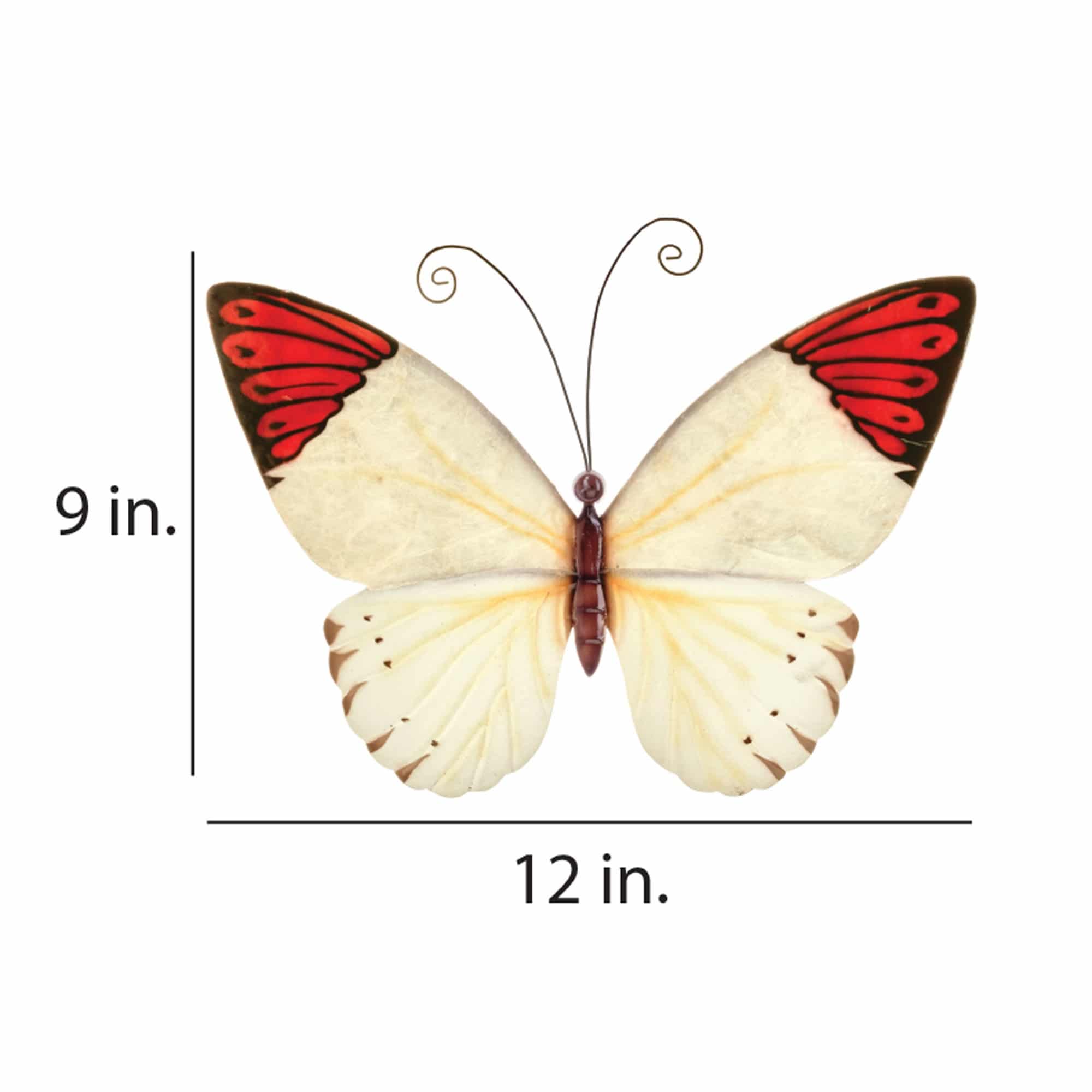
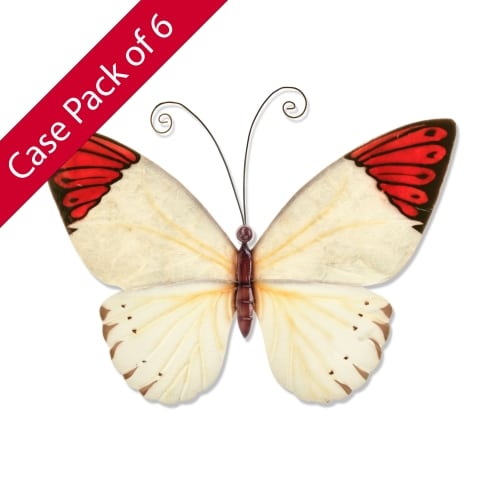 Case of 6 Starting with a base color of pearl white, the artist uses different techniques and splashes of color to craft a distinctive piece. The upper wings are created using capiz oyster shell, left natural to bring in different natural hues. The red base color is accented using brown feathering patterns. The lower portion of the wing is made of tin, textured to highlight the lines that stem from the body of the butterfly. The basic frame of the butterfly is created using tin, which is powder-coated with a black finish and makes this piece safe to use outdoors. The edges of the frame are reinforced using thicker tin wire. The front of this piece is adorned in areas with capiz shell, an oyster native to the Philippines, before being hand-painted and sealed with a water-based sealant. The primary purpose of this oyster to provide a source of food, however, the shell is a sustainable by-product that can be used for decoration. The capiz shell subtly replicates the reflective qualities of butterflies in nature. The entire piece is lightweight and has an eyelet in the back allowing it to be hung using a finishing nail, command strip, or a push pin. Due to it being a natural material, the organic colors of capiz come through as tans and browns underneath the paint.
Case of 6 Starting with a base color of pearl white, the artist uses different techniques and splashes of color to craft a distinctive piece. The upper wings are created using capiz oyster shell, left natural to bring in different natural hues. The red base color is accented using brown feathering patterns. The lower portion of the wing is made of tin, textured to highlight the lines that stem from the body of the butterfly. The basic frame of the butterfly is created using tin, which is powder-coated with a black finish and makes this piece safe to use outdoors. The edges of the frame are reinforced using thicker tin wire. The front of this piece is adorned in areas with capiz shell, an oyster native to the Philippines, before being hand-painted and sealed with a water-based sealant. The primary purpose of this oyster to provide a source of food, however, the shell is a sustainable by-product that can be used for decoration. The capiz shell subtly replicates the reflective qualities of butterflies in nature. The entire piece is lightweight and has an eyelet in the back allowing it to be hung using a finishing nail, command strip, or a push pin. Due to it being a natural material, the organic colors of capiz come through as tans and browns underneath the paint. -

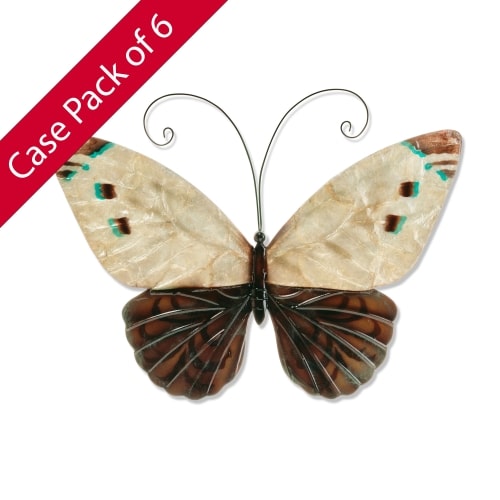 Case of 6
Case of 6The wings of this butterfly are divided into two parts. Soft muted organic colors are hand-painted onto mother of pearl oyster shells on the upper portion of the wings. The lower portion of the wings contrast with bold lines etched into the tin base. That is then hand-painted using a dark brown with a gloss finish reflecting different shades of color changing with the light.
The basic frame of the butterfly is created using tin, which is powder-coated with a black finish and makes this piece safe to use outdoors. The edges of the frame are reinforced using thicker tin wire. The front of this piece is adorned in areas with capiz shell, an oyster native to the Philippines, before being hand-painted and sealed with a water-based sealant. The primary purpose of this oyster to provide a source of food, however, the shell is a sustainable by-product that can be used for decoration. The capiz shell subtly replicates the reflective qualities of butterflies in nature. The entire piece is lightweight and has an eyelet in the back allowing it to be hung using a finishing nail, command strip, or a push pin. Due to it being a natural material, the organic colors of capiz come through as tans and browns underneath the paint.
-
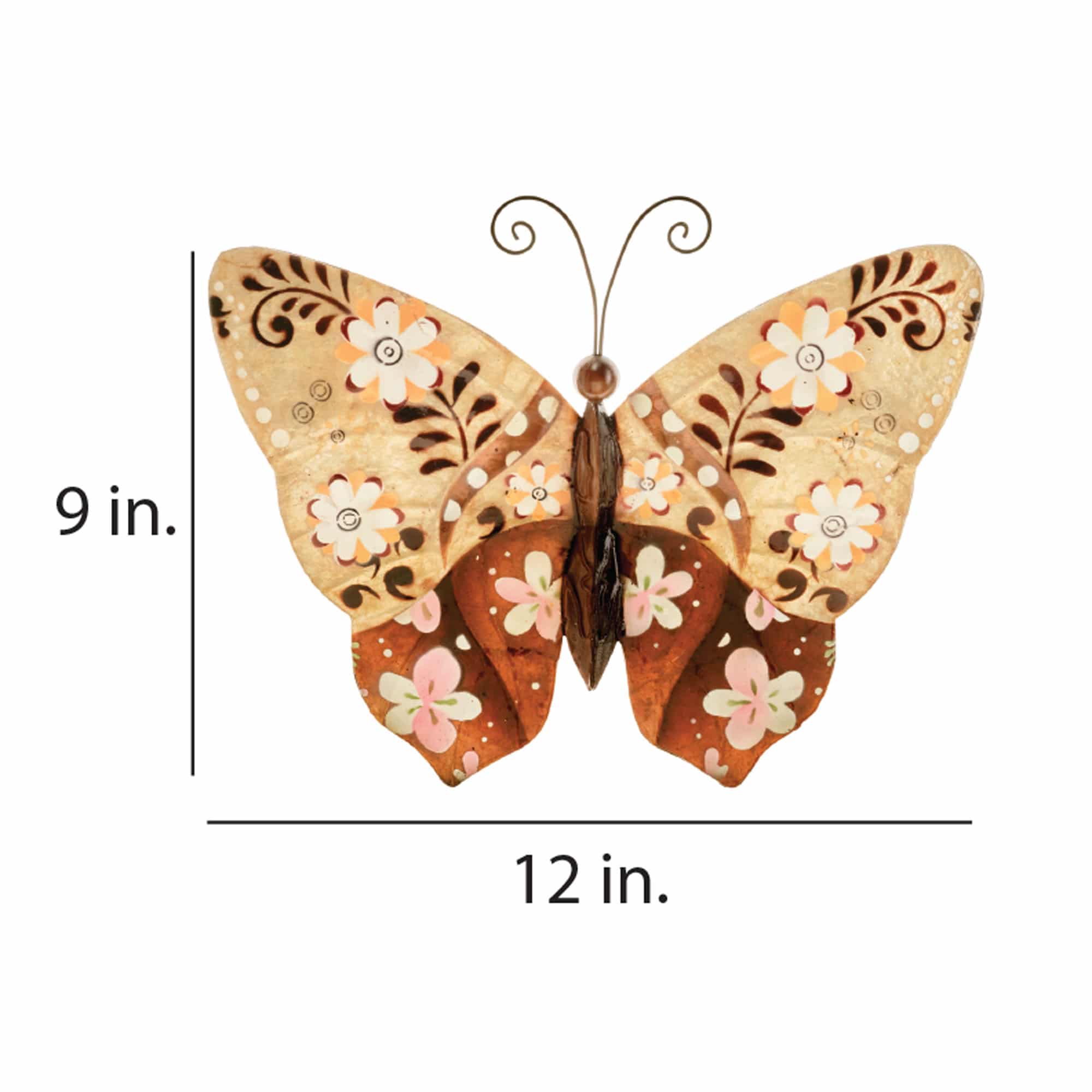
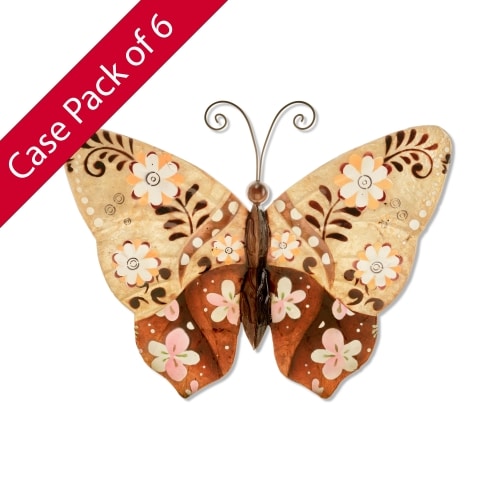 Case of 6
Case of 6With its warm earth and cream tones, this butterfly features whimsical flowers with sophisticated patterns. Calming and soothing, the understated elegance enhances its surroundings with the beauty of pattern and texture.
The basic frame of the butterfly is created using tin, which is powder-coated with a black finish and makes this piece safe to use outdoors. The edges of the frame are reinforced using thicker tin wire. The front of this piece is adorned in areas with capiz shell, an oyster native to the Philippines, before being hand-painted and sealed with a water-based sealant. The primary purpose of this oyster to provide a source of food, however, the shell is a sustainable by-product that can be used for decoration. The capiz shell subtly replicates the reflective qualities of butterflies in nature. The entire piece is lightweight and has an eyelet in the back allowing it to be hung using a finishing nail, command strip, or a push pin. Due to it being a natural material, the organic colors of capiz come through as tans and browns underneath the paint.
-
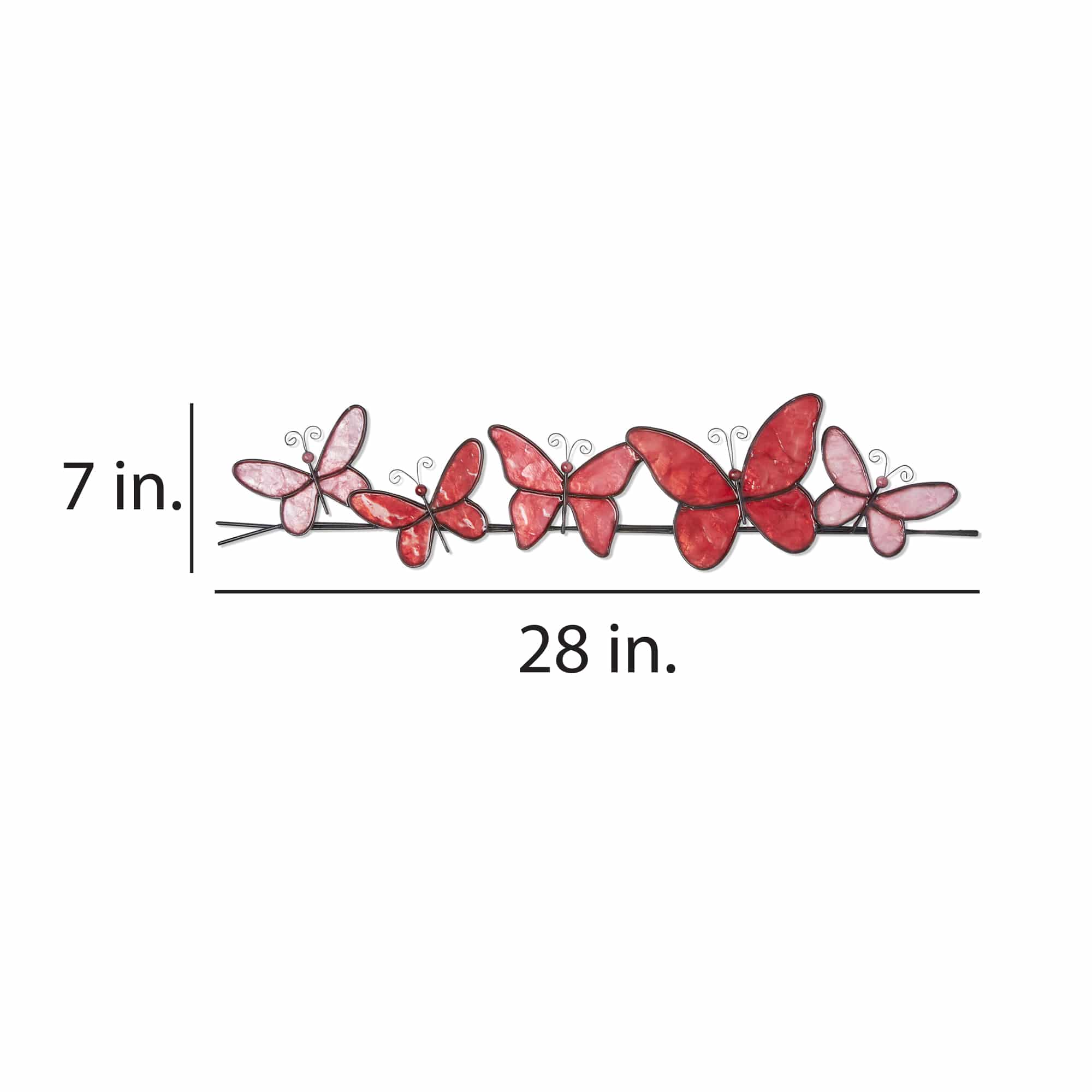
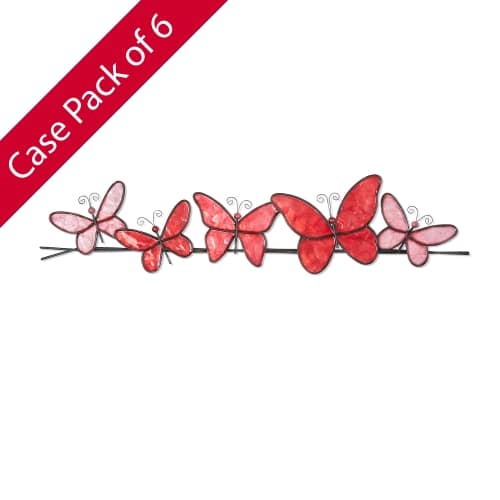 Case of 6
Case of 6Five, fluttering butterflies are ready to complete their journey after taking a break from a long migration. The slender, metal body of each butterfly connects to colorful capiz-shell wings which catches light and adds shine. Each wing is framed using sturdy wrought iron and reinforced with a metal backing.
The basic frame of the butterfly is created using tin, which is powder-coated with a black finish and makes this piece safe to use outdoors. The edges of the frame are reinforced using thicker tin wire. The front of this piece is adorned in areas with capiz shell, an oyster native to the Philippines, before being hand-painted and sealed with a water-based sealant. The primary purpose of this oyster to provide a source of food, however, the shell is a sustainable by-product that can be used for decoration. The capiz shell subtly replicates the reflective qualities of butterflies in nature. The entire piece is lightweight and has an eyelet in the back allowing it to be hung using a finishing nail, command strip, or a push pin. Due to it being a natural material, the organic colors of capiz come through as tans and browns underneath the paint.
-
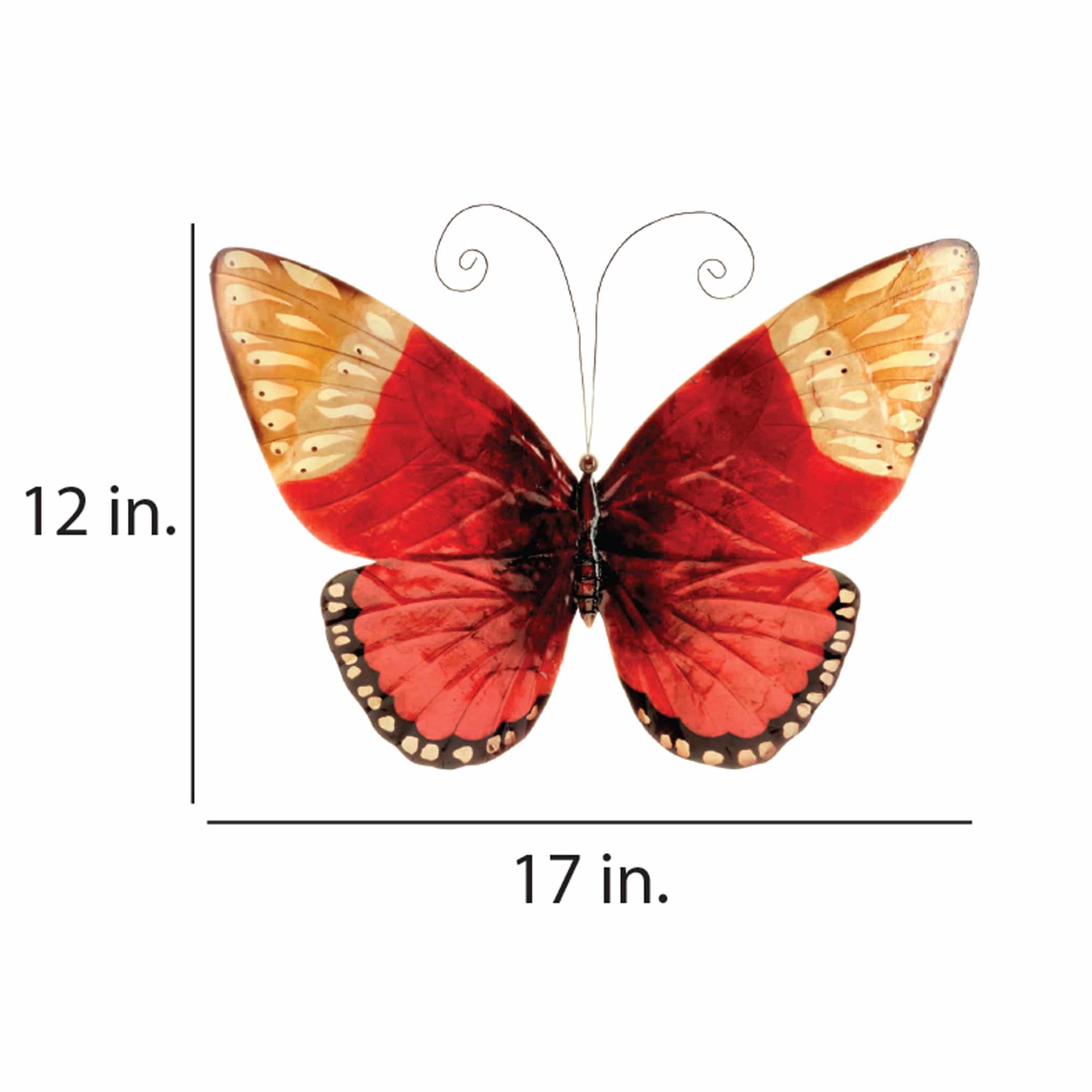
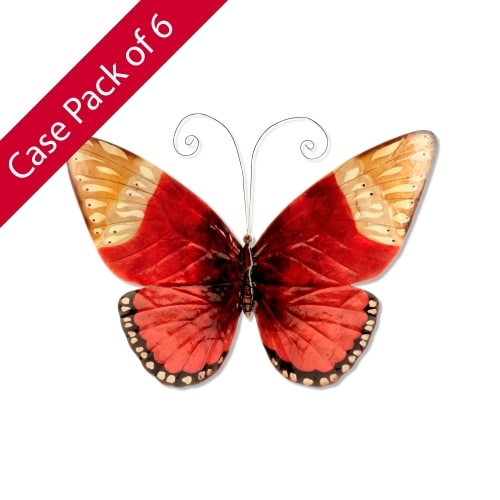 Case of 6
Case of 6This butterfly is large and bold with its striking bright red body. But this butterfly isn't mono-colored. Instead the artist uses different shading techniques and mother of pearl oyster shell to bring in depth as well as strong color. The artist further enhances the butterfly by adding brown feathering to the wing-tips.
The basic frame of the butterfly is created using tin, which is powder-coated with a black finish and makes this piece safe to use outdoors. The edges of the frame are reinforced using thicker tin wire. The front of this piece is adorned in areas with capiz shell, an oyster native to the Philippines, before being hand-painted and sealed with a water-based sealant. The primary purpose of this oyster to provide a source of food, however, the shell is a sustainable by-product that can be used for decoration. The capiz shell subtly replicates the reflective qualities of butterflies in nature. The entire piece is lightweight and has an eyelet in the back allowing it to be hung using a finishing nail, command strip, or a push pin. Due to it being a natural material, the organic colors of capiz come through as tans and browns underneath the paint.
-
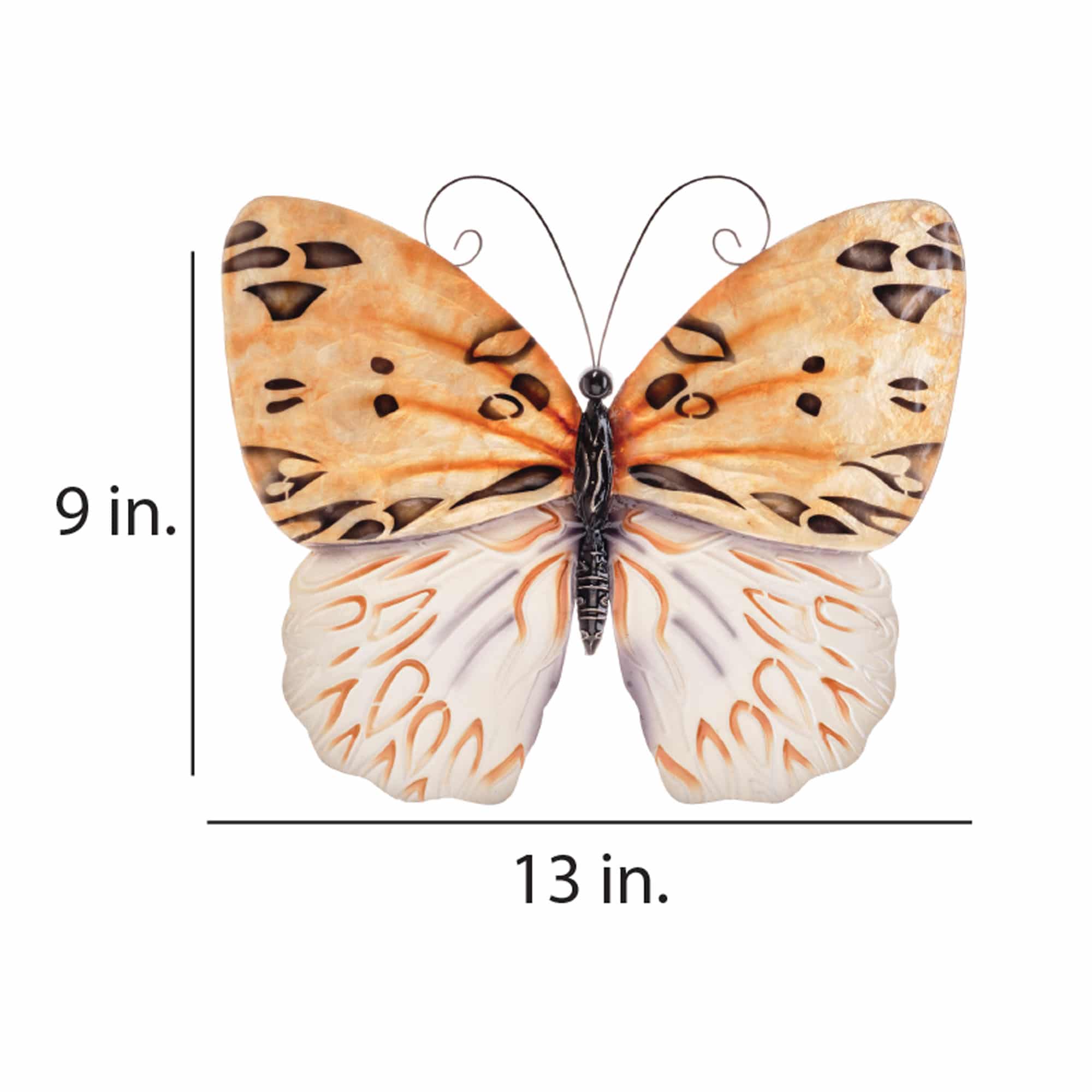
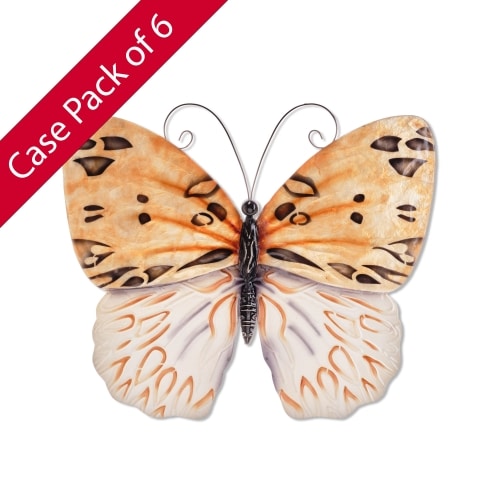 Case of 6
Case of 6Using paints of various shades and different hues of yellow, this graceful butterfly features an appearance of flowing honey on its upper wings. The lower wings diverge from the honey and are textured in a base white color with highlights of yellow. Stylish and elegant, this piece adds sophistication to the finish of any room, contemporary or traditional.
The basic frame of the butterfly is created using tin, which is powder-coated with a black finish and makes this piece safe to use outdoors. The edges of the frame are reinforced using thicker tin wire. The front of this piece is adorned in areas with capiz shell, an oyster native to the Philippines, before being hand-painted and sealed with a water-based sealant. The primary purpose of this oyster to provide a source of food, however, the shell is a sustainable by-product that can be used for decoration. The capiz shell subtly replicates the reflective qualities of butterflies in nature. The entire piece is lightweight and has an eyelet in the back allowing it to be hung using a finishing nail, command strip, or a push pin. Due to it being a natural material, the organic colors of capiz come through as tans and browns underneath the paint.
-
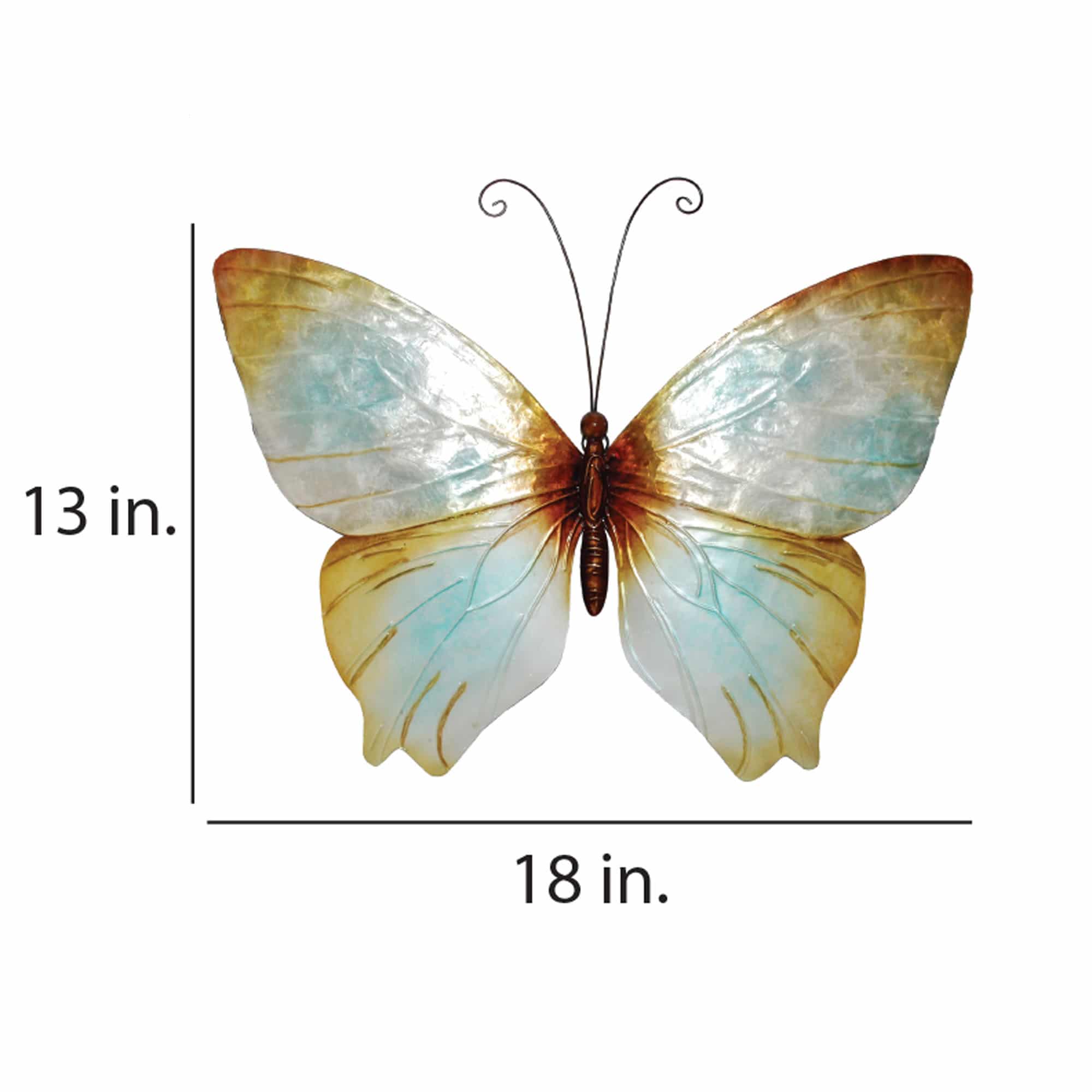
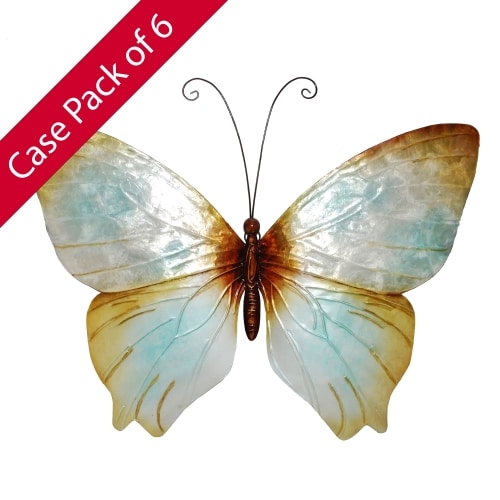 Case of 6
Case of 6The colors of the wings are inspired by the water of a crystal-clear lake, making the pearl wings feel translucent next to the dark body. The long flowing antenna and the shape of this butterfly provide a classic feel to this very familiar form.
The basic frame of the butterfly is created using tin, which is powder-coated with a black finish and makes this piece safe to use outdoors. The edges of the frame are reinforced using thicker tin wire. The front of this piece is adorned in areas with capiz shell, an oyster native to the Philippines, before being hand-painted and sealed with a water-based sealant. The primary purpose of this oyster to provide a source of food, however, the shell is a sustainable by-product that can be used for decoration. The capiz shell subtly replicates the reflective qualities of butterflies in nature. The entire piece is lightweight and has an eyelet in the back allowing it to be hung using a finishing nail, command strip, or a push pin. Due to it being a natural material, the organic colors of capiz come through as tans and browns underneath the paint.
-
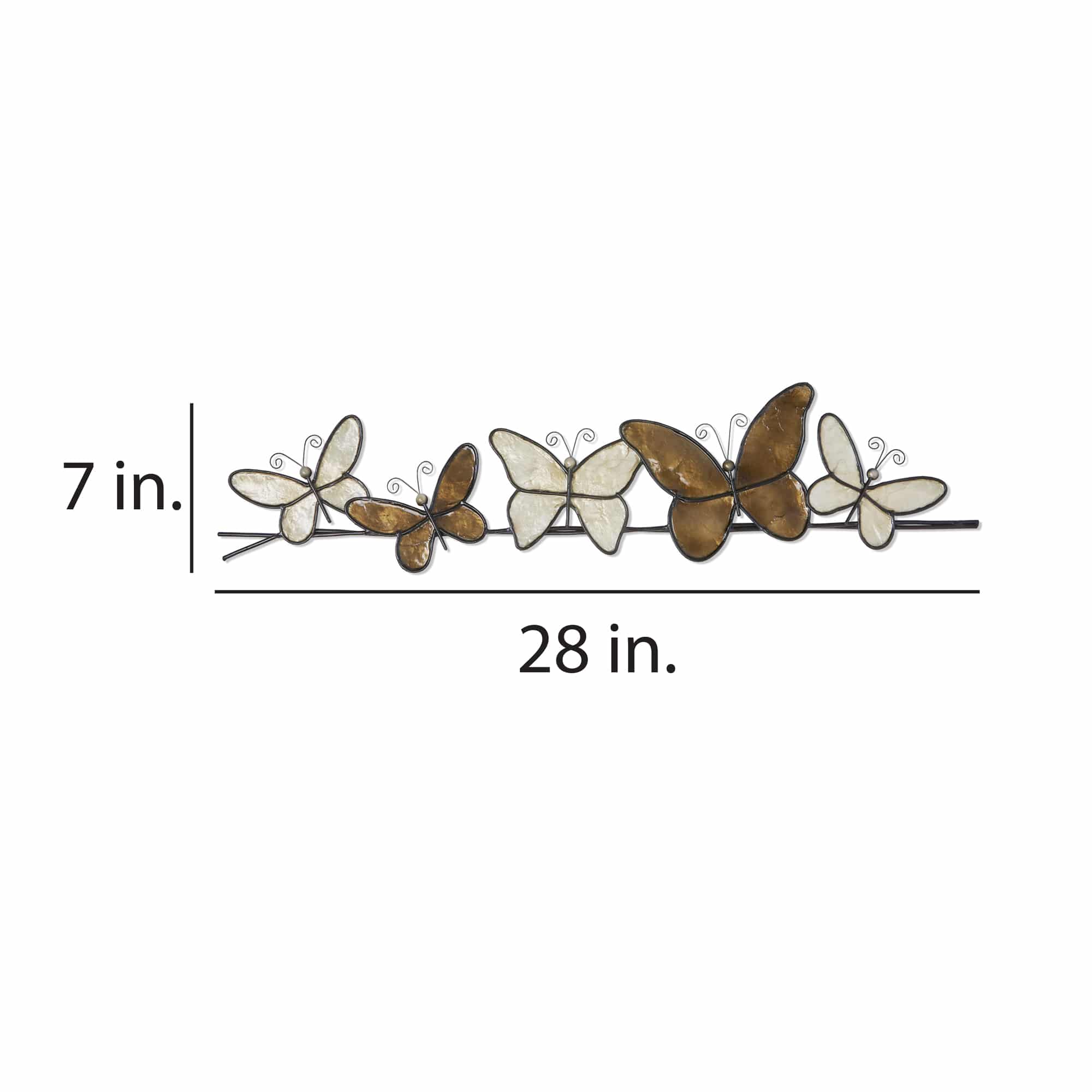
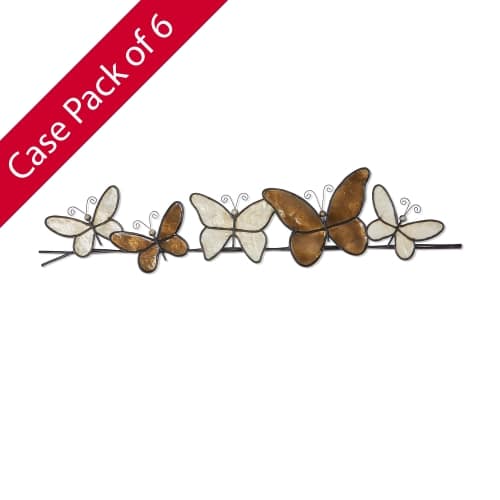 Case of 6
Case of 6Five, fluttering butterflies are ready to complete their journey after taking a break from a long migration. The slender, metal body of each butterfly connects to colorful capiz-shell wings which catches light and adds shine. Each wing is framed using sturdy wrought iron and reinforced with a metal backing.
The basic frame of the butterfly is created using tin, which is powder-coated with a black finish and makes this piece safe to use outdoors. The edges of the frame are reinforced using thicker tin wire. The front of this piece is adorned in areas with capiz shell, an oyster native to the Philippines, before being hand-painted and sealed with a water-based sealant. The primary purpose of this oyster to provide a source of food, however, the shell is a sustainable by-product that can be used for decoration. The capiz shell subtly replicates the reflective qualities of butterflies in nature. The entire piece is lightweight and has an eyelet in the back allowing it to be hung using a finishing nail, command strip, or a push pin. Due to it being a natural material, the organic colors of capiz come through as tans and browns underneath the paint.
-

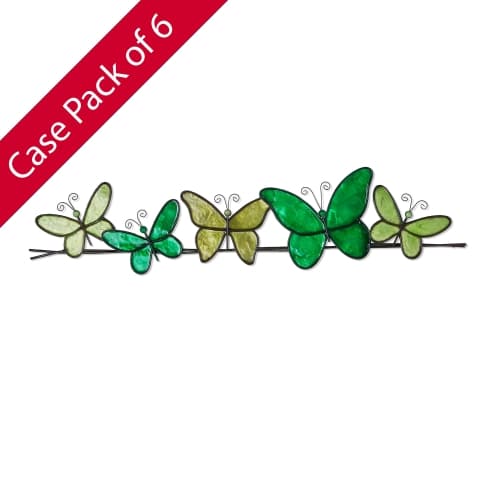 Case of 6 Five, fluttering butterflies are ready to complete their journey after taking a break from a long migration. The slender, metal body of each butterfly connects to colorful capiz-shell wings which catches light and adds shine. Each wing is framed using sturdy wrought iron and reinforced with a metal backing. The basic frame of the butterfly is created using tin, which is powder-coated with a black finish and makes this piece safe to use outdoors. The edges of the frame are reinforced using thicker tin wire. The front of this piece is adorned in areas with capiz shell, an oyster native to the Philippines, before being hand-painted and sealed with a water-based sealant. The primary purpose of this oyster to provide a source of food, however, the shell is a sustainable by-product that can be used for decoration. The capiz shell subtly replicates the reflective qualities of butterflies in nature. The entire piece is lightweight and has an eyelet in the back allowing it to be hung using a finishing nail, command strip, or a push pin. Due to it being a natural material, the organic colors of capiz come through as tans and browns underneath the paint.
Case of 6 Five, fluttering butterflies are ready to complete their journey after taking a break from a long migration. The slender, metal body of each butterfly connects to colorful capiz-shell wings which catches light and adds shine. Each wing is framed using sturdy wrought iron and reinforced with a metal backing. The basic frame of the butterfly is created using tin, which is powder-coated with a black finish and makes this piece safe to use outdoors. The edges of the frame are reinforced using thicker tin wire. The front of this piece is adorned in areas with capiz shell, an oyster native to the Philippines, before being hand-painted and sealed with a water-based sealant. The primary purpose of this oyster to provide a source of food, however, the shell is a sustainable by-product that can be used for decoration. The capiz shell subtly replicates the reflective qualities of butterflies in nature. The entire piece is lightweight and has an eyelet in the back allowing it to be hung using a finishing nail, command strip, or a push pin. Due to it being a natural material, the organic colors of capiz come through as tans and browns underneath the paint. -

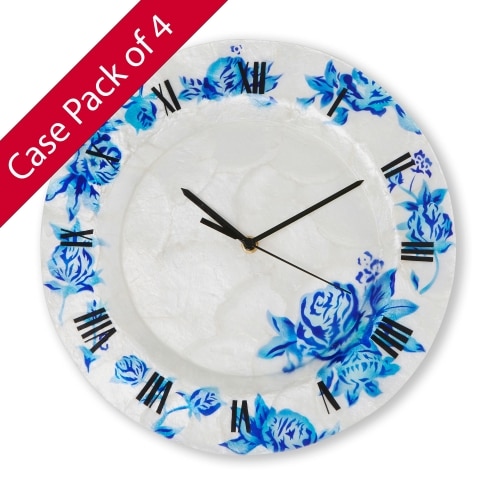 Case of 4 The frame of this clock is made with solid capiz oyster shell, compressed into shape. The artist seals the shells, leaving the natural color of the capiz as the base, pearl color of the clock face. Intricately designed blue roses are hand-painted and purposefully placed along the outer rim. Bold roman numberals are evenly spaced to complement the strong floral design. The combination provides a strong vintage appeal. Capiz is an oyster shell and the primary purpose of the oyster is as a source of food. However, the by-product, the shell, can be used for decoration. The clock is created by compressing capiz shell together and forming it into shape. The final result is a light-weight, plate that feels similar to plastic. Due to it being a natural material, the natural colors of the capiz may come through as tans and browns underneath the hand-painted surface.
Case of 4 The frame of this clock is made with solid capiz oyster shell, compressed into shape. The artist seals the shells, leaving the natural color of the capiz as the base, pearl color of the clock face. Intricately designed blue roses are hand-painted and purposefully placed along the outer rim. Bold roman numberals are evenly spaced to complement the strong floral design. The combination provides a strong vintage appeal. Capiz is an oyster shell and the primary purpose of the oyster is as a source of food. However, the by-product, the shell, can be used for decoration. The clock is created by compressing capiz shell together and forming it into shape. The final result is a light-weight, plate that feels similar to plastic. Due to it being a natural material, the natural colors of the capiz may come through as tans and browns underneath the hand-painted surface. -
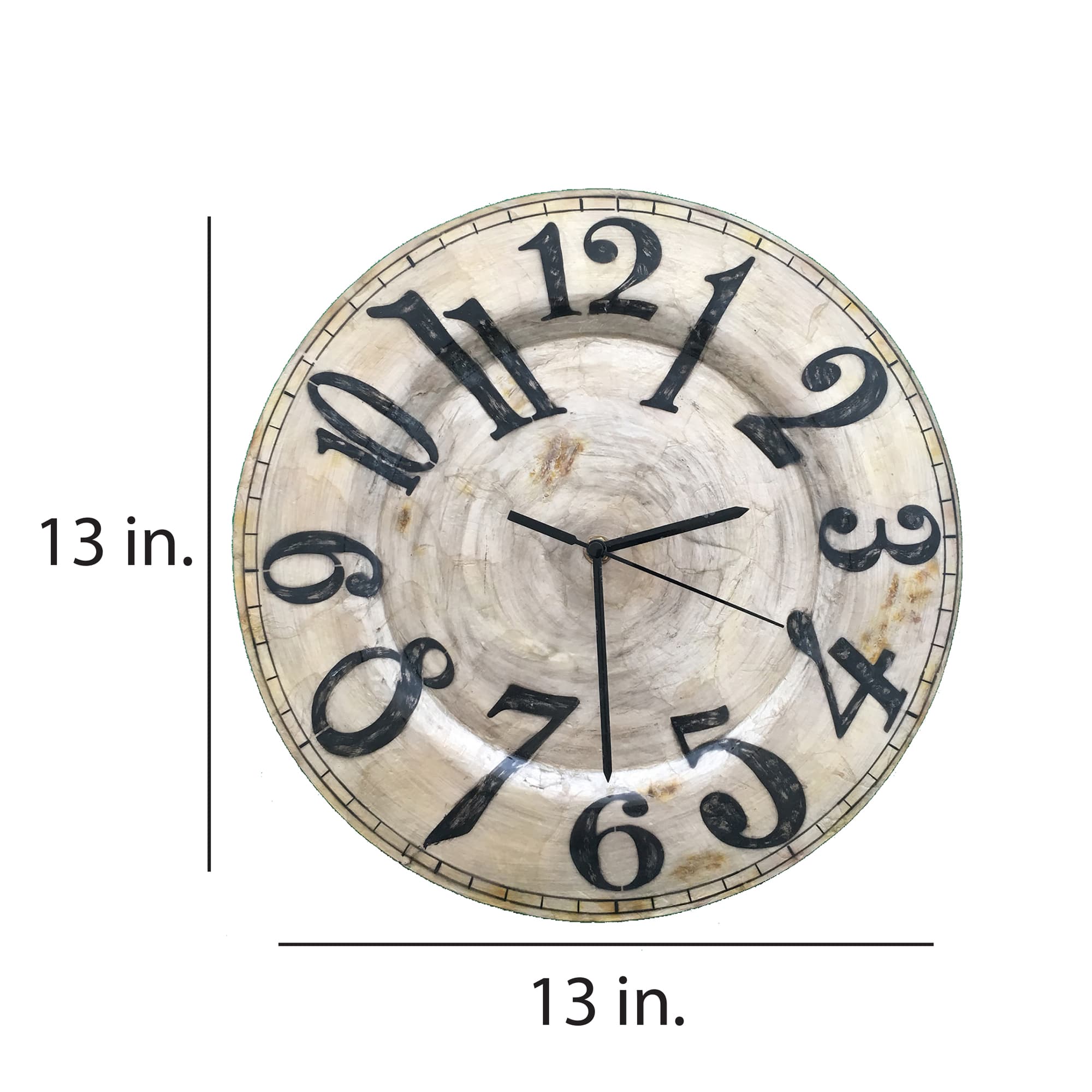
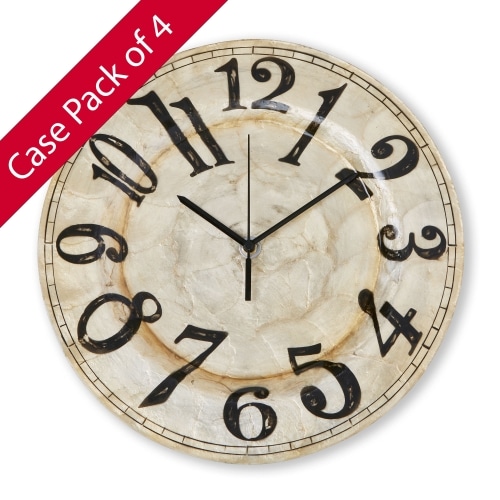 Case of 4 The frame of this clock is made with solid capiz oyster shell, compressed into shape. The face is hand-painted to appear as if it is aged porcelain, promoted by the natual colors of the capiz shell. The look is further accentuated by gentle distressed marks. The black, bold numbers vary in size and stand in strong contrast to the pearl background. The combination of simple color palette and the seasoned feel of the porcelain finish are quintessential hallmarks of the modern farmhouse design genre. Capiz is an oyster shell and the primary purpose of the oyster is as a source of food. However, the by-product, the shell, can be used for decoration. The clock is created by compressing capiz shell together and forming it into shape. The final result is a light-weight, plate that feels similar to plastic. Due to it being a natural material, the natural colors of the capiz may come through as tans and browns underneath the hand-painted surface.
Case of 4 The frame of this clock is made with solid capiz oyster shell, compressed into shape. The face is hand-painted to appear as if it is aged porcelain, promoted by the natual colors of the capiz shell. The look is further accentuated by gentle distressed marks. The black, bold numbers vary in size and stand in strong contrast to the pearl background. The combination of simple color palette and the seasoned feel of the porcelain finish are quintessential hallmarks of the modern farmhouse design genre. Capiz is an oyster shell and the primary purpose of the oyster is as a source of food. However, the by-product, the shell, can be used for decoration. The clock is created by compressing capiz shell together and forming it into shape. The final result is a light-weight, plate that feels similar to plastic. Due to it being a natural material, the natural colors of the capiz may come through as tans and browns underneath the hand-painted surface. -
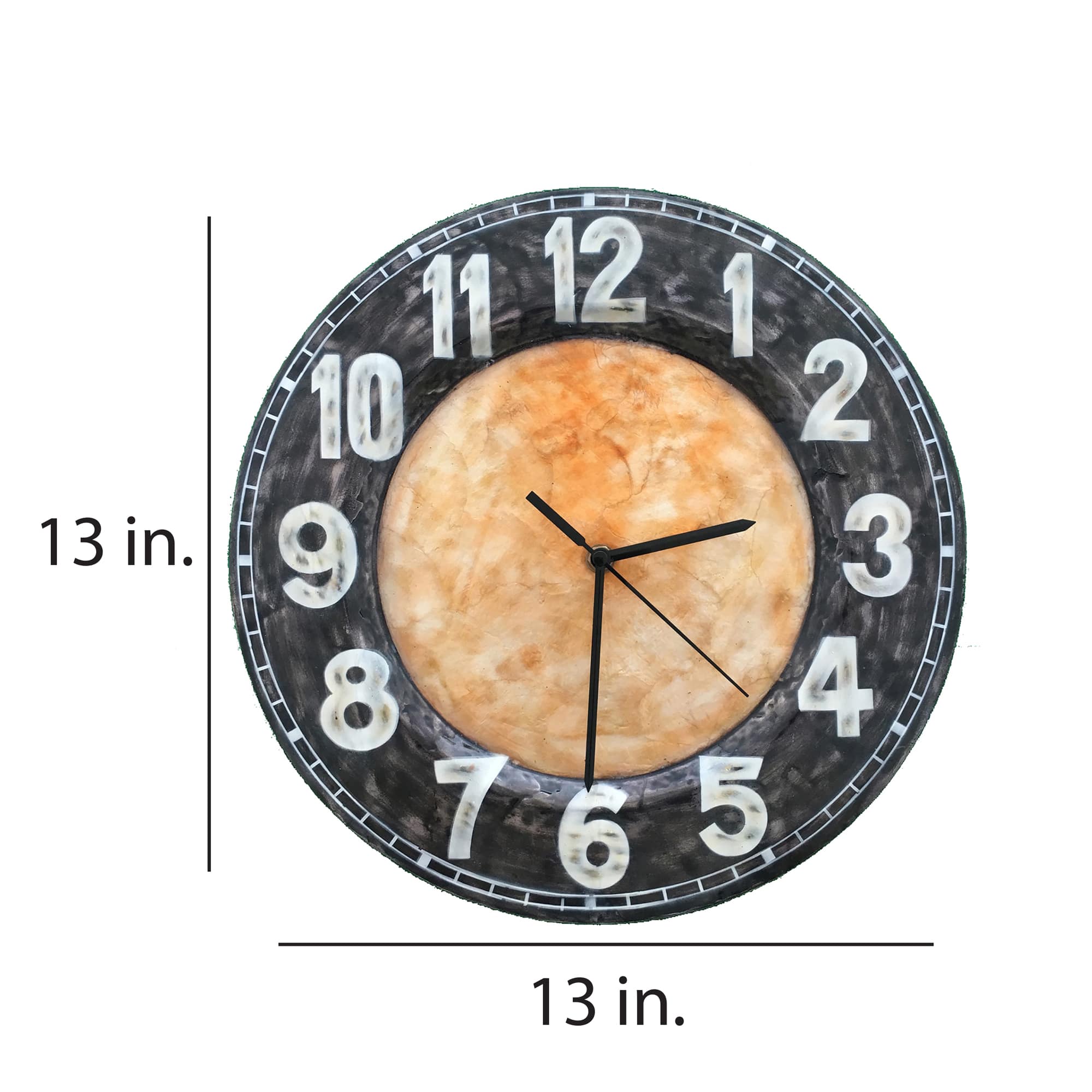
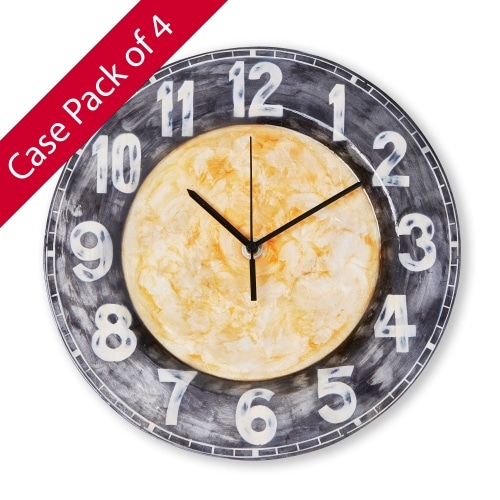 Case of 4 The frame of this clock is made with solid capiz oyster shell, compressed into shape. The texture and lines of the individual shell pieces still come through the hand-painted clock face. The center of the clock is sponge-painted resembling a Mediterranean, terra cotta finish. The darker outer rim and contrasting white, weathered numbers, complete this piece to feel as though it came from the old world. Capiz is an oyster shell and the primary purpose of the oyster is as a source of food. However, the by-product, the shell, can be used for decoration. The clock is created by compressing capiz shell together and forming it into shape. The final result is a light-weight, plate that feels similar to plastic. Due to it being a natural material, the natural colors of the capiz may come through as tans and browns underneath the hand-painted surface.
Case of 4 The frame of this clock is made with solid capiz oyster shell, compressed into shape. The texture and lines of the individual shell pieces still come through the hand-painted clock face. The center of the clock is sponge-painted resembling a Mediterranean, terra cotta finish. The darker outer rim and contrasting white, weathered numbers, complete this piece to feel as though it came from the old world. Capiz is an oyster shell and the primary purpose of the oyster is as a source of food. However, the by-product, the shell, can be used for decoration. The clock is created by compressing capiz shell together and forming it into shape. The final result is a light-weight, plate that feels similar to plastic. Due to it being a natural material, the natural colors of the capiz may come through as tans and browns underneath the hand-painted surface. -
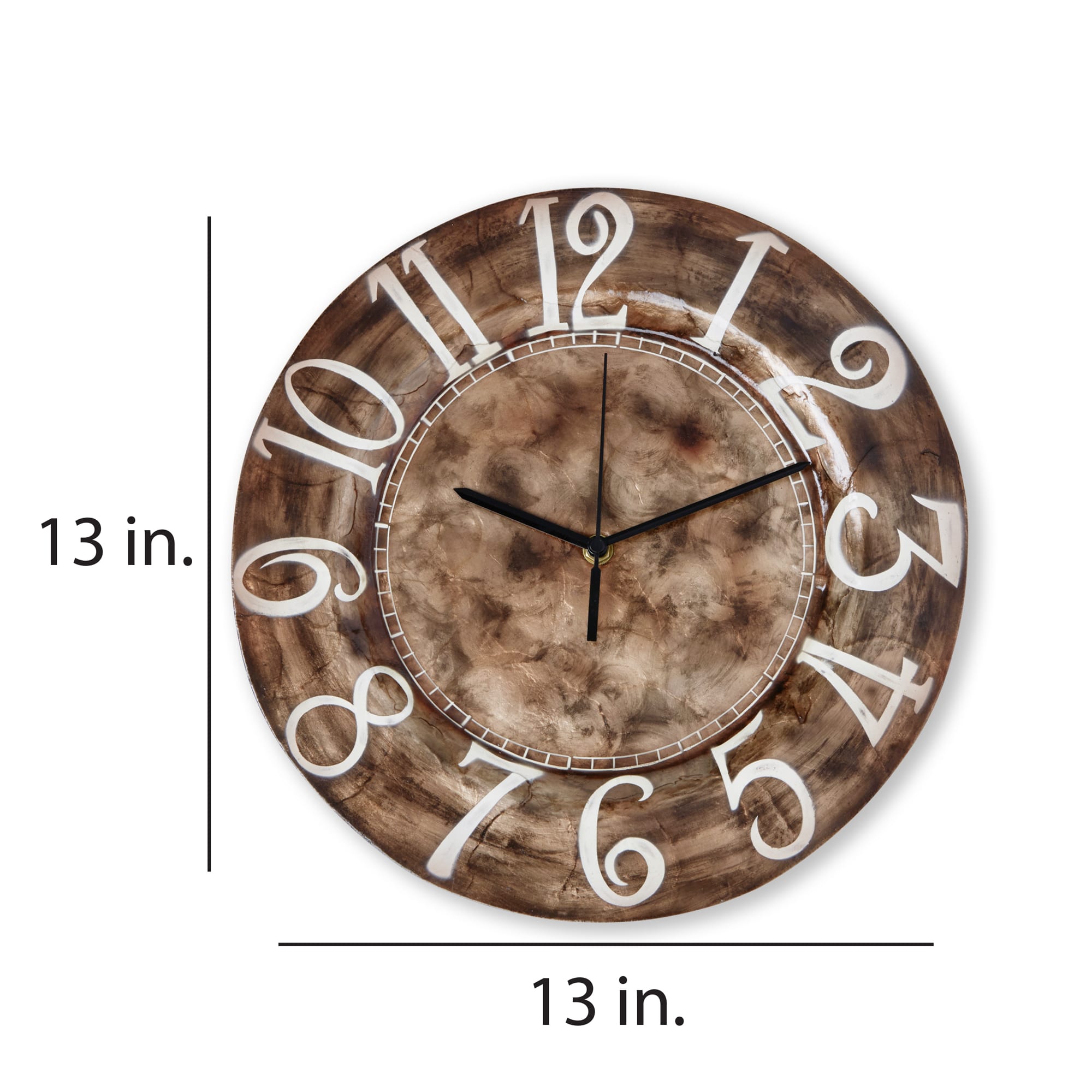
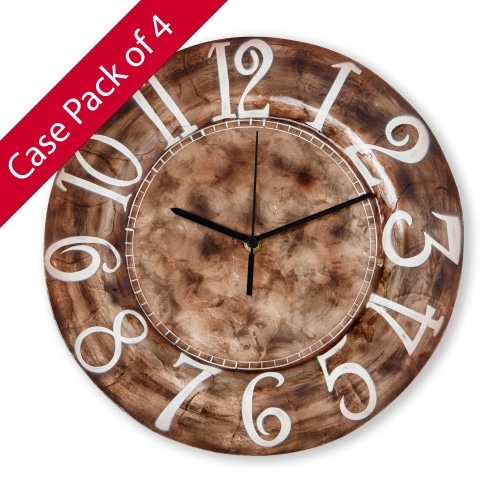 Case of 4 The frame of this clock is made with solid capiz oyster shell, compressed into shape. The texture and lines of the individual shell pieces still come through the broad brush strokes of brown on the background of the clock. The distressed look of the earthy, rich background color giving an aged feel which is complemented by the added detail of the weathered, hand-painted numbers. Capiz is an oyster shell and the primary purpose of the oyster is as a source of food. However, the by-product, the shell, can be used for decoration. The clock is created by compressing capiz shell together and forming it into shape. The final result is a light-weight, plate that feels similar to plastic. Due to it being a natural material, the natural colors of the capiz may come through as tans and browns underneath the hand-painted surface.
Case of 4 The frame of this clock is made with solid capiz oyster shell, compressed into shape. The texture and lines of the individual shell pieces still come through the broad brush strokes of brown on the background of the clock. The distressed look of the earthy, rich background color giving an aged feel which is complemented by the added detail of the weathered, hand-painted numbers. Capiz is an oyster shell and the primary purpose of the oyster is as a source of food. However, the by-product, the shell, can be used for decoration. The clock is created by compressing capiz shell together and forming it into shape. The final result is a light-weight, plate that feels similar to plastic. Due to it being a natural material, the natural colors of the capiz may come through as tans and browns underneath the hand-painted surface. -
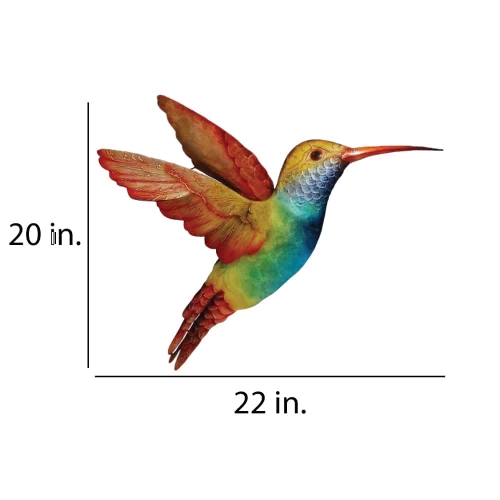
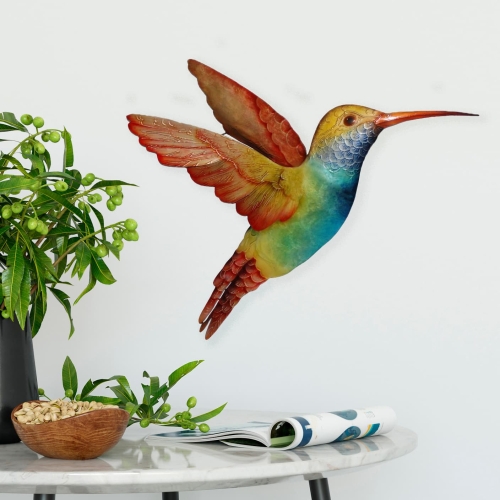 This hummingbird is inspired by many different species. The artist captures the colors and grace of a hummingbird in mid-flight. Its chest is adorned with capiz shell, which is then hand-painted to the magnificent colors seen in many species. This hummingbird brings a sense of purpose as it flies from flower to flower. The basic frame of the hummingbird is created using tin, which is powder coated with a black finish. The frame is reinforced using tin wire along the inner edge. Capiz is an oyster shell and the primary purpose of the oyster is as a source of food. However, the by-product, the shell, can be used for decoration. Due to it being a natural material, the natural colors of the capiz come through as tans and browns underneath the paint. The shell is then painted the bold colors you see. The entire front facing piece is carefully hand-painted keeping in mind the reflective qualities in the color of hummingbirds.
This hummingbird is inspired by many different species. The artist captures the colors and grace of a hummingbird in mid-flight. Its chest is adorned with capiz shell, which is then hand-painted to the magnificent colors seen in many species. This hummingbird brings a sense of purpose as it flies from flower to flower. The basic frame of the hummingbird is created using tin, which is powder coated with a black finish. The frame is reinforced using tin wire along the inner edge. Capiz is an oyster shell and the primary purpose of the oyster is as a source of food. However, the by-product, the shell, can be used for decoration. Due to it being a natural material, the natural colors of the capiz come through as tans and browns underneath the paint. The shell is then painted the bold colors you see. The entire front facing piece is carefully hand-painted keeping in mind the reflective qualities in the color of hummingbirds. -
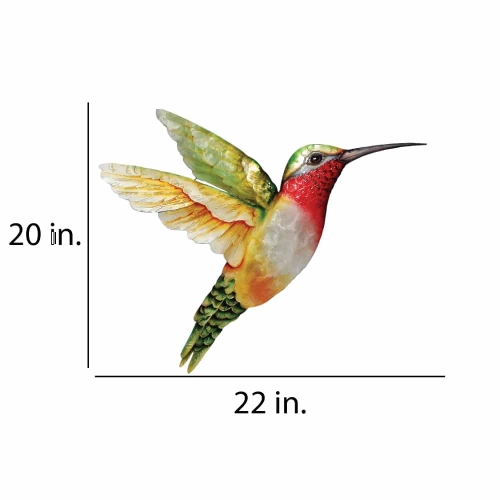
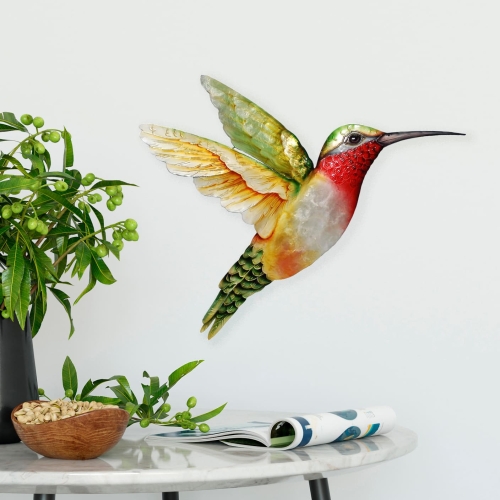 This hummingbird is inspired by many different species. The artist captures the colors and grace of a hummingbird in mid-flight. Its chest is adorned with capiz shell, which is then hand-painted to the magnificent colors seen in many species. This hummingbird brings a sense of purpose as it flies from flower to flower. The basic frame of the hummingbird is created using tin, which is powder coated with a black finish. The frame is reinforced using tin wire along the inner edge. Capiz is an oyster shell and the primary purpose of the oyster is as a source of food. However, the by-product, the shell, can be used for decoration. Due to it being a natural material, the natural colors of the capiz come through as tans and browns underneath the paint. The shell is then painted the bold colors you see. The entire front facing piece is carefully hand-painted keeping in mind the reflective qualities in the color of hummingbirds.
This hummingbird is inspired by many different species. The artist captures the colors and grace of a hummingbird in mid-flight. Its chest is adorned with capiz shell, which is then hand-painted to the magnificent colors seen in many species. This hummingbird brings a sense of purpose as it flies from flower to flower. The basic frame of the hummingbird is created using tin, which is powder coated with a black finish. The frame is reinforced using tin wire along the inner edge. Capiz is an oyster shell and the primary purpose of the oyster is as a source of food. However, the by-product, the shell, can be used for decoration. Due to it being a natural material, the natural colors of the capiz come through as tans and browns underneath the paint. The shell is then painted the bold colors you see. The entire front facing piece is carefully hand-painted keeping in mind the reflective qualities in the color of hummingbirds. -
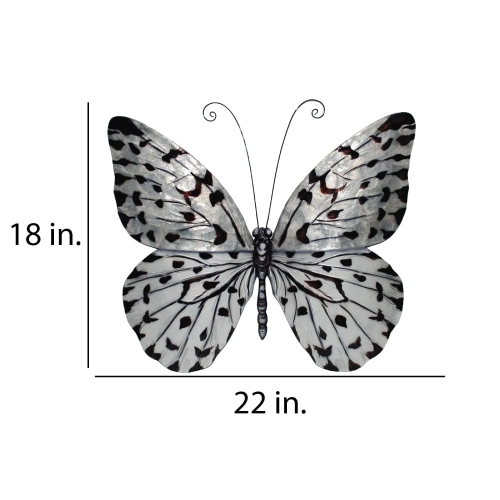
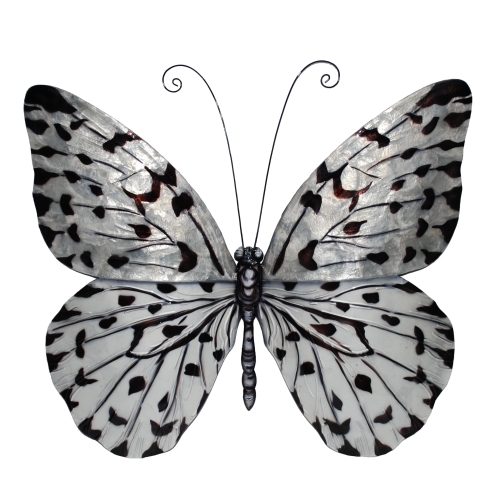 Angelic and graceful, the White Morpho butterfly is distinctive and regal. The wings of this butterfly are rather large and stately, particularly when this beauty flies on the breeze from flower to flower. The artist brings this to life by crafting the body smaller compared to the wings. The upper wings are adorned with capiz shell, giving it the translucent color seen in the natural butterfly. The lower wings are constructed from tin and the colors help accentuate the vein structures. The combination of the two will add both color and structure to your wall and your room.The basic frame of the butterfly is created using tin, which is powder-coated with a black finish and makes this piece safe to use outdoors. The edges of the frame are reinforced using thicker tin wire. The front of this piece is adorned in areas with capiz shell, an oyster native to the Philippines, before being hand-painted and sealed with a water-based sealant. The primary purpose of this oyster to provide a source of food, however, the shell is a sustainable by-product that can be used for decoration. The capiz shell subtly replicates the reflective qualities of butterflies in nature. The entire piece is lightweight and has an eyelet in the back allowing it to be hung using a finishing nail, command strip, or a push pin. Due to it being a natural material, the organic colors of capiz come through as tans and browns underneath the paint.
Angelic and graceful, the White Morpho butterfly is distinctive and regal. The wings of this butterfly are rather large and stately, particularly when this beauty flies on the breeze from flower to flower. The artist brings this to life by crafting the body smaller compared to the wings. The upper wings are adorned with capiz shell, giving it the translucent color seen in the natural butterfly. The lower wings are constructed from tin and the colors help accentuate the vein structures. The combination of the two will add both color and structure to your wall and your room.The basic frame of the butterfly is created using tin, which is powder-coated with a black finish and makes this piece safe to use outdoors. The edges of the frame are reinforced using thicker tin wire. The front of this piece is adorned in areas with capiz shell, an oyster native to the Philippines, before being hand-painted and sealed with a water-based sealant. The primary purpose of this oyster to provide a source of food, however, the shell is a sustainable by-product that can be used for decoration. The capiz shell subtly replicates the reflective qualities of butterflies in nature. The entire piece is lightweight and has an eyelet in the back allowing it to be hung using a finishing nail, command strip, or a push pin. Due to it being a natural material, the organic colors of capiz come through as tans and browns underneath the paint. -
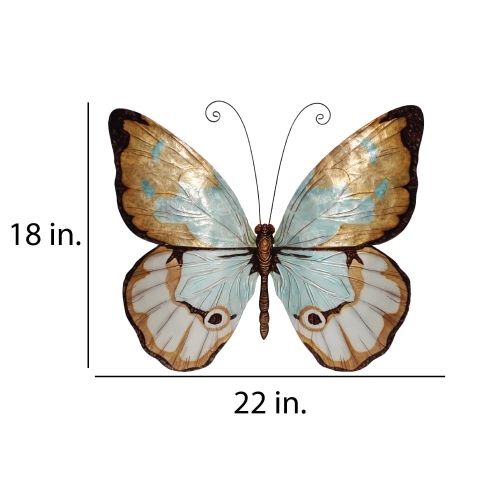
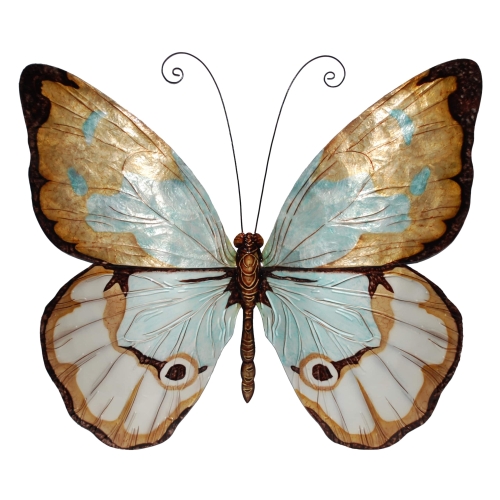 This butterfly features classic butterfly patterns with is mottled upper wings and its dotted lower section. The warm copper tones contrast with the contemporary blues to take this naturally feeling piece in a direction that works in both contemporary and traditional settings. Its neutral in tone while still exuding warmth.The basic frame of the butterfly is created using tin, which is powder-coated with a black finish and makes this piece safe to use outdoors. The edges of the frame are reinforced using thicker tin wire. The front of this piece is adorned in areas with capiz shell, an oyster native to the Philippines, before being hand-painted and sealed with a water-based sealant. The primary purpose of this oyster to provide a source of food, however, the shell is a sustainable by-product that can be used for decoration. The capiz shell subtly replicates the reflective qualities of butterflies in nature. The entire piece is lightweight and has an eyelet in the back allowing it to be hung using a finishing nail, command strip, or a push pin. Due to it being a natural material, the organic colors of capiz come through as tans and browns underneath the paint.
This butterfly features classic butterfly patterns with is mottled upper wings and its dotted lower section. The warm copper tones contrast with the contemporary blues to take this naturally feeling piece in a direction that works in both contemporary and traditional settings. Its neutral in tone while still exuding warmth.The basic frame of the butterfly is created using tin, which is powder-coated with a black finish and makes this piece safe to use outdoors. The edges of the frame are reinforced using thicker tin wire. The front of this piece is adorned in areas with capiz shell, an oyster native to the Philippines, before being hand-painted and sealed with a water-based sealant. The primary purpose of this oyster to provide a source of food, however, the shell is a sustainable by-product that can be used for decoration. The capiz shell subtly replicates the reflective qualities of butterflies in nature. The entire piece is lightweight and has an eyelet in the back allowing it to be hung using a finishing nail, command strip, or a push pin. Due to it being a natural material, the organic colors of capiz come through as tans and browns underneath the paint. -
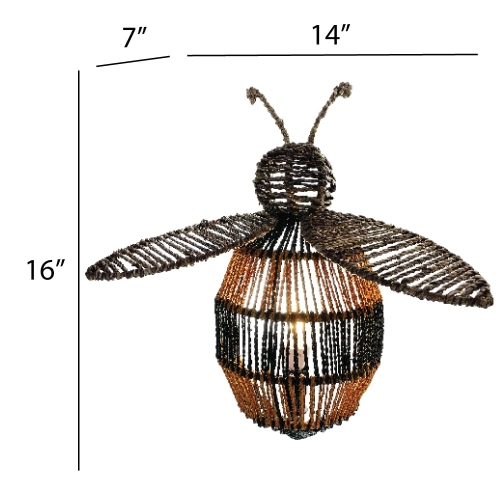
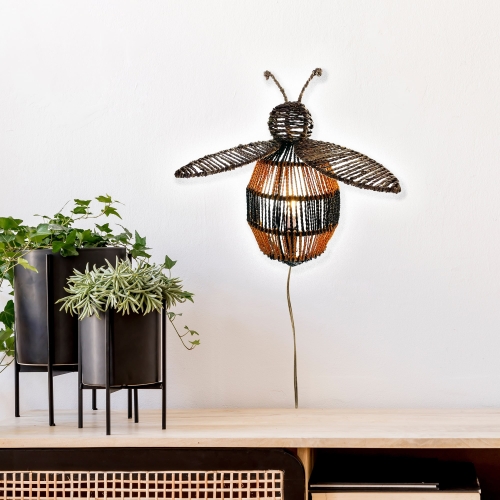 Bees have recently been referenced as one of the most important animals in all of nature for their important role in pollination. This bee is happy with wings raised and ready to take flight. The yellow and black banding contrast the natural color of its wings in a familiar pattern. This piece adds fun on its own but can have even larger impact if placed in a group with a few friends! The bee's head and wings are comprised of natural abaca rope handwoven into a wrought iron frame. The body is made of abaca twine, stain orange or black, and then handwoven into the same wrought iron fame, in the pattern of a bee's body. Abaca is a fiber of a plant that is related to the banana plant. It bears no fruit, but it can continuously grow from the same roots similar to native grasses. The open weaving allows for ambient light to show through providing functional light. Also included is a plug with an inline switch for easy use.
Bees have recently been referenced as one of the most important animals in all of nature for their important role in pollination. This bee is happy with wings raised and ready to take flight. The yellow and black banding contrast the natural color of its wings in a familiar pattern. This piece adds fun on its own but can have even larger impact if placed in a group with a few friends! The bee's head and wings are comprised of natural abaca rope handwoven into a wrought iron frame. The body is made of abaca twine, stain orange or black, and then handwoven into the same wrought iron fame, in the pattern of a bee's body. Abaca is a fiber of a plant that is related to the banana plant. It bears no fruit, but it can continuously grow from the same roots similar to native grasses. The open weaving allows for ambient light to show through providing functional light. Also included is a plug with an inline switch for easy use. -
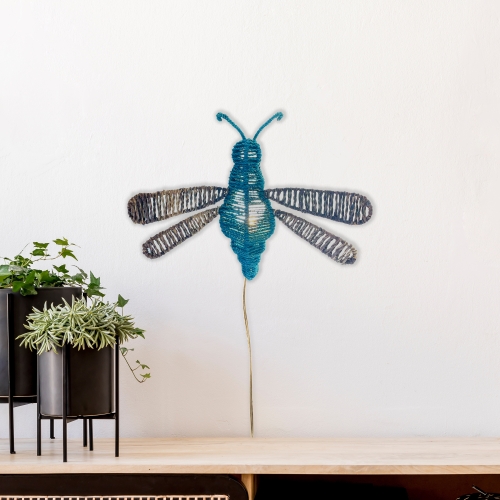
 Reflecting the natural aquas and blues of the nearly translucent dragonfly, the artist uses a base of sea blue dyed abaca weave to embody the almost ephemeral structure. The wings feature a natural abaca rope mimicking the texture of a dragonfly's organic wing structure. This piece adds fun on its own but can have even larger impact if placed in a group with a few friends! The dragonfly's wings are comprised of natural abaca rope handwoven into a wrought iron frame. The head and body is made of abaca twine, stained, and then handwoven into the same wrought iron fame, emphasizing the contrast between the body and wings. Abaca is a fiber of a plant that is related to the banana plant. It bears no fruit, but it can continuously grow from the same roots similar to native grasses. The open weaving allows for ambient light to show through providing functional light. Also included is a plug with an inline switch for easy use.
Reflecting the natural aquas and blues of the nearly translucent dragonfly, the artist uses a base of sea blue dyed abaca weave to embody the almost ephemeral structure. The wings feature a natural abaca rope mimicking the texture of a dragonfly's organic wing structure. This piece adds fun on its own but can have even larger impact if placed in a group with a few friends! The dragonfly's wings are comprised of natural abaca rope handwoven into a wrought iron frame. The head and body is made of abaca twine, stained, and then handwoven into the same wrought iron fame, emphasizing the contrast between the body and wings. Abaca is a fiber of a plant that is related to the banana plant. It bears no fruit, but it can continuously grow from the same roots similar to native grasses. The open weaving allows for ambient light to show through providing functional light. Also included is a plug with an inline switch for easy use. -
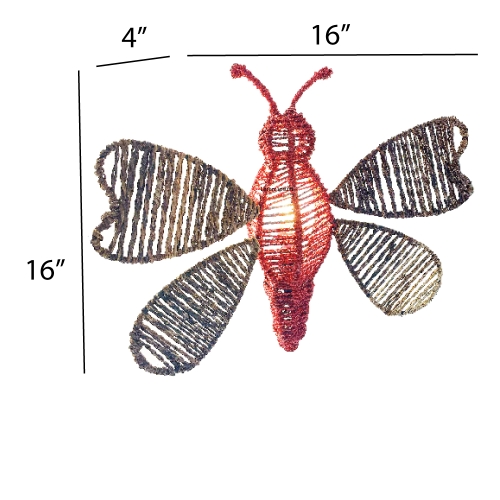
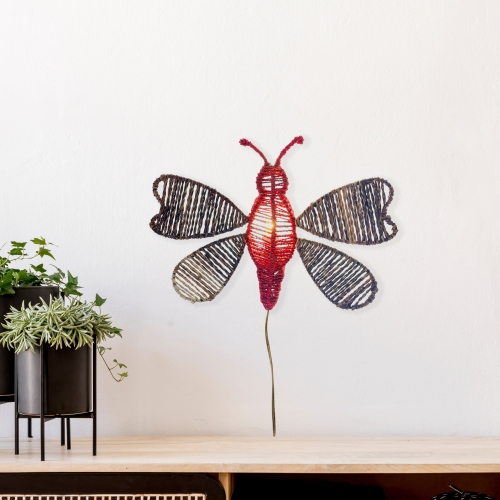 This butterfly is large and bold with its striking bright red body. But this butterfly isn't mono-colored. Instead, the artist uses natural earth tones within its wings to create contrast and warmth. This piece adds fun on its own but can have even larger impact if placed in a group with a few friends! The butterfly's wings are comprised of natural abaca rope handwoven into a wrought iron frame. The head and body is made of abaca twine, stained, and then handwoven into the same wrought iron fame, emphasizing the contrast between the body and wings. Abaca is a fiber of a plant that is related to the banana plant. It bears no fruit, but it can continuously grow from the same roots similar to native grasses. The open weaving allows for ambient light to show through providing functional light. Also included is a plug with an inline switch for easy use.
This butterfly is large and bold with its striking bright red body. But this butterfly isn't mono-colored. Instead, the artist uses natural earth tones within its wings to create contrast and warmth. This piece adds fun on its own but can have even larger impact if placed in a group with a few friends! The butterfly's wings are comprised of natural abaca rope handwoven into a wrought iron frame. The head and body is made of abaca twine, stained, and then handwoven into the same wrought iron fame, emphasizing the contrast between the body and wings. Abaca is a fiber of a plant that is related to the banana plant. It bears no fruit, but it can continuously grow from the same roots similar to native grasses. The open weaving allows for ambient light to show through providing functional light. Also included is a plug with an inline switch for easy use.
